August 31, 2018
Prom 64: Verdi’s Requiem
If the text is religious, the music can seem apocalyptic, coruscating, relentless - and even agnostic. Hans von Bülow, even before he had heard the work, described it as “Verdi’s latest opera, though in ecclesiastical costume”, and for some (though not Brahms), this view remains a valid one. But the scale of this requiem, and the miracle of its orchestration and vocal writing, rather prove the opposite: Where else, except perhaps in Mahler’s Resurrection, does the power of trumpets, on-stage, and antiphonally off-stage, take you towards the precipice of religious cataclysm? In what other sacred work does the timpani sound like a hammer against an anvil? And is there a darker, more sonorous, and bleaker, ‘Amen’ than the one that Verdi writes at the close of his ‘Dies Irae’?
Great performances of Verdi’s Requiem are rare in my experience. They fall short for all kinds of reasons - and yes, the worst do treat this work as an opera. The young Columbian conductor, Andrés Orozco-Estrada, making his Proms debut with this work - as Lorin Maazel had done almost fifty years ago - clearly sees Verdi’s work in very sacred terms. This was in no sense a hard-edged, or even driven, performance in the Solti mould - but nor was it one that lingered over phrases to the point of paralysis as Maazel was wont to do in his later years. That is not to say that Orozco-Estrada doesn’t take time to illuminate details of orchestration. The woodwind phrasing was luscious, for example - but given this conductor’s ear for ravishing sonorities in a work like Strauss’s Ein Heldenleben this didn’t overly surprise me.
It’s difficult to sustain drama and tension in this piece for almost ninety minutes but for most of that span Orozco-Estrada managed to do just that. The ‘Dies Irae’ was taken in almost a single arc and the impact of it was entirely memorable. He brings a younger man’s sense of terror to this music rather than the more usual sense of prophecy than someone like Giulini did. Those indelible piccolos almost seemed to stab themselves through the orchestra like blades, the bass drum thundered, the trombones erupted into pyroclastic clouds of sound. This was a ‘Dies Irae’ with fire scorching like an inferno, the horror of the Day of Wrath painted from the ink of Verdi’s music. But there was room for great luminosity, too: bassoons were sculpted, not just phrased, flutes fluttered like angels. The ‘Agnus Dei’ had an ethereal beauty to it, and this is a conductor who can shape a pianissimo with breath-taking transparency.
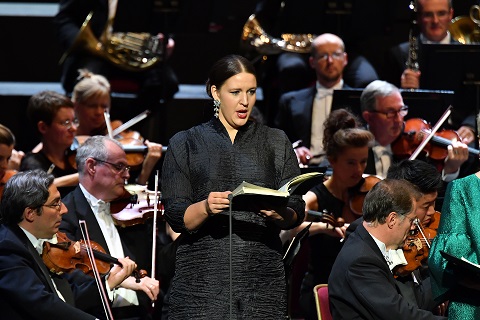 Lise Davidsen. Photo Credit: BBC/Chris Christodoulou.
Lise Davidsen. Photo Credit: BBC/Chris Christodoulou.
None of this would have been possible without his soloists or choir, however. Of all the great choral works, Verdi’s Requiem is the most difficult to cast well and this one did much better than most. The Norwegian soprano, Lise Davidsen, I sometimes felt was a touch hard-edged. This isn’t the most obviously beautiful, or creamy, soprano and the sheer steeliness of her voice sometimes felt too harsh. I think anyone who was familiar with Margaret Price in this work would have found her rather cold - even shrill. But where it mattered the accuracy of her singing, the brilliance of her upper register and the ability to scale her dynamics was stunning. She definitely took some time to get into her stride; the ‘Introit and Kyrie’ wasn’t as assured as I’d have liked, but she undoubtedly became more secure as the performance developed. Indeed, her ‘Libera me’ was a tour de force: exquisite strength, imperious high notes and a pianissimo that was ravishing. This is a voice that doesn’t just cut through the orchestra like a sabre; it rises effortlessly above it as well.
The mezzo-soprano Sarah Connolly, replacing the indisposed Karen Cargill, was magnificent. The voice is rich, yet the tone is so burnished as well, and no-one who heard her sing would have been unmoved by the depth she brought to her part. Perhaps the voice isn’t huge - and certainly it didn’t have the dramatic impact that Lise Davidsen summoned at times - but the pairing of these two voices was symbiotic. The Ukrainian tenor, Dmytro Popov, is that rare thing: A true Verdian tenor. His ‘Ingemisco’, so often a point of anti-climax in a performance of Verdi’s Requiem, was staggering. The top notes ring out with a steady evenness that is as disciplined as it is stentorian, and yet that brightness of tone belies a really deep, unquivering lower register that is granitic. Short of stature - it was difficult from where I was sat in the stalls to see him above his music stand - the voice has huge presence. The Polish bass, Tomasz Konieczny, brought the strength and terror of Wotan to his ‘Confutatis’. Again, here was a singer who didn’t just sing his part; he brought a wealth of vocal colour and heroic range to it. Konieczny’s voice is rock-solid at the bottom, the final line of his ‘Confutatis’ - ‘Gere curam mei finis’ - so sonorous you felt it would split the heavens apart. This isn’t just a voice that has strength, however; it abounds in lyricism, too.
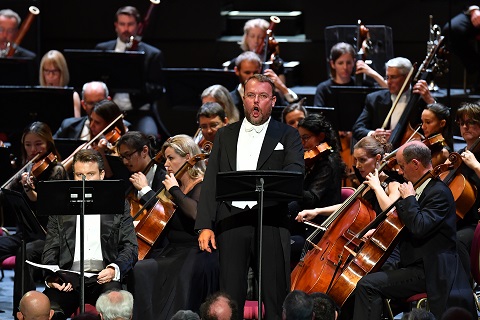 Tomasz Konieczny. Photo Credit: BBC/Chris Christodoulou.
Tomasz Konieczny. Photo Credit: BBC/Chris Christodoulou.
Both the London Philharmonic Orchestra, and its chorus, were fully equal to the demands of Verdi’s score. This was a performance where neither the orchestra, nor the chorus, overwhelmed the other. It wasn’t the weightiest sounding Verdi Requiem I can remember; in fact, it projected a feeling of period performance being both highly disciplined and strongly incisive. Indeed, balances were so in harmony with each other you often felt the whole requiem was like a slow, blossoming flower. Moments like the opening of the ‘Introit and Kyrie’ were exquisitely poetic, defined by playing that was almost inaudible, barely above the level of a ghostly whisper; yet, on the other hand, the ‘Sanctus’, with its double fugue and double chorus, was a triumph of vocal clarity.
This was a sublime concert, magnificently performed and interpreted, and a very notable Proms debut from its young Columbian conductor.
Marc Bridle
Prom 64: Verdi, Requiem
Lise Davidsen (soprano) - Sarah Connolly (mezzo-soprano) - Dmytro Popov (tenor) - Tomasz Konieczny (bass) - London Philharmonic Choir (Neville Creed, Chorus-master) - London Philharmonic Orchestra - Andrés Orozco-Estrada (conductor)
Royal Albert Hall, London, 30th August 2018.
image=http://www.operatoday.com/Prom64%20Connolly.jpg image_description=Prom 64: Verdi’s Requiem, London Philharmonic Orchestra conducted by Andrés Orozco-Estrada product=yes product_title=Prom 64: Verdi’s Requiem, London Philharmonic Orchestra conducted by Andrés Orozco-Estrada product_by=A review by Marc Bridle product_id= Above: Sarah ConnollyPhoto credit: BBC/Chris Christodoulou
Prom 62: Petrenko and the Royal Liverpool Philharmonic - one concert, two stellar sopranos
And, the performances by Romanian soprano Adela Zaharia and Swedish soprano Miah Persson in this Prom, with the Royal Liverpool Philharmonic Orchestra conducted by Vasily Petrenko, were certainly satisfying, completely and complementarily.
However, the music that they performed did not hit similar heights. Persson’s Straussian credentials were polished at Garsington this summer where her role debut performance as the Countess in Tim Albery’s production of Capriccio was unanimously acclaimed. Gold, silver and pearl: the adjectives bandied about by the critics suggested that the Three Kings had come to Wormsley. But, such effulgence was retrospectively justified by the sumptuousness, gracefulness and purity with which Persson floated - with glorious freedom, suppleness and coloristic range - through the four songs selected here.
Slightly reduced in forces after the interval, the RLPO glistened with the excited heart-flutterings of a love-inflamed adolescent at the start of ‘Ständchen’ (Serenade) - indeed, Persson’s impassioned impetuosity evoked the palpitating ardours of a Cherubino. After the sweet reflectiveness of the first two stanzas of ‘Das Bächlein’ (The Brooklet), the final verse had a wonderful sense of new energy and confident purposefulness, lifted too by the exuberant spiralling in the orchestral texture. In ‘Morgen!’ (Tomorrow!), Persson crafted the vocal line with simple but pure delicacy, her melody embraced by leader Thelma Handy’s eloquent violin solo as the delicious rubatos of the heaven-aspiring harp and the deep resonance of the bass pizzicatos provided a fulfilling accompaniment. There was a ripening of emotion with the declamatory “Stumm warden wir uns in die Augen schauen” (We shall look mutely into each other’s eyes), and Petrenko exploited the harmonic tensions in the sustained chords until feeling overflowed in the final duet of solo violin and harp; Petrenko dared to diminuendo to a whisper and then to nothing, and then still further into silence. The glories of ‘Zueignung’ were over all too soon; the intensification and apotheosis of the third stanza were thrilling.
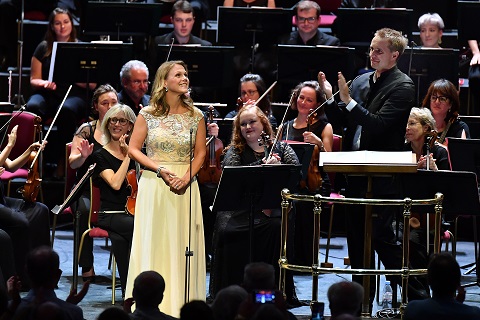 Miah Persson. Photo Credit: BBC/Chris Christodoulou.
Miah Persson. Photo Credit: BBC/Chris Christodoulou.
Throughout, Persson’s lovely vocal sheen held the Proms audience in still wonderment and joy, though, if one were to quibble, perhaps the soprano might have paid a little more attention to Strauss’s word-painting. There was an occasional verbal-coloristic frisson, as in as ‘Ständchen’, when the dusk fell beneath the linden trees - “Unter den Lindenbaumen” - and Persson’s rich rolling of the ‘r’ - “Und die Rose, wenn sie am Morgen erwacht” - made the flower glow with the night’s rapture; and Strauss’s cadential falling appoggiaturas were discerningly articulated. More of such details would have raised a very fine performance still higher. But, the final phrase of ‘Zueignung’ said it all: “habe Dank!” Be thanked, indeed.
Persson was replacing Diana Damrau who had withdrawn owing to illness, and Damrau had also been the intended soloist in Iain Bell’s Aurora, a BBC co-commission with the RLPO, written for Damrau with whom Bell has collaborated frequently. It fell instead to Romanian soprano Adela Zaharia to present the world premiere. Operalia 2017 winner Zaharia, making her Proms debut here, won acclaim when she stood in for an ailing Damrau last December in Munich, when the latter withdrew from the first performance of the run of Lucia di Lammermoor at the Bayerische Staatsoper. Bell’s exploration of the coloristic mystery and majesty of the aurora borealis was well served by the ease of Zaharia’s flights into the stratosphere; the darkness and strength of her tone in the middle and lower ranges; and by the powerful muscularity, allied with subtle flexibility, of her soprano, which breezed easily over the varied orchestral textures. Such qualities did much to sustain a narrative arc and expressive focus through the three linked movements of Bell’s nocturnal probing and wonderment. Zaharia worked hard to imbue the vocalise of the first movement, ‘Dusk to Darkness: First Glimmers’, with expressive weight and intent, her voice flickering and glittering over orchestral intimations of coming night, beginning coolly and then accruing warmth, to glow with the luminescent strength of the sky’s display of dancing of electrons and photons. She slithered provocatively and fierily - and with impressive precision - through the frolics of ‘Night-time: Lights Come Out to Play’, rising exuberantly to climactic vocal peaks and soaring over the flourishes of full-textured orchestral playfulness. In ‘Dead of Night: Phantom Shadows’, her florid outbursts were delivered with deceptive ease, untroubled by the aggressiveness of the orchestra’s rhythmic repetitions, brassy challenges and percussive onslaughts. And, in the closing stages, as the sustained low pedal dissipated into the ether, Zaharia shaped the voice’s final declaration of the supremacy of light most beautifully.
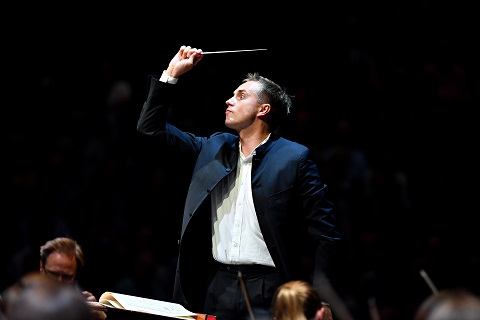 Vasily Petrenko. Photo Credit: BBC/Chris Christodoulou.
Vasily Petrenko. Photo Credit: BBC/Chris Christodoulou.
The work itself, I found less convincing. Bell certainly knows how to exploit orchestral timbres and how to tint textures with flashes of colour, light and tactility. The ear was teased with myriad gestures; one could never anticipate from whence or which instrumental voice would speak, sing, stutter or demand, then disappear back into the shimmering mass. Petrenko shaped the evolving hues and episodes with a sure sense of pace and atmosphere, and, particularly in the central movement, ensured that we appreciated the teasing dialogues between voice and orchestra, in a manner of a ‘traditional’ concerto. But, it’s difficult to sustain a sense of expressive focus through twenty minutes of vocalise, however inventive the instrumental effects; and, in a work centring on colour and conflict, it’s a pity that harmony played a less significant role in Bell’s pictorial arsenal. Overall, what I missed most was the mythic poetry of the aurora borealis, though I certainly hope that we get another chance to hear Zaharia perform in the UK soon.
The vocal items were framed by two exuberant scores in which Petrenko inspired some committed and virtuosic playing from the RLPO. Elgar’s In the South opened the Prom with a blast of Mediterranean heat, sunshine and out-of-doors joie de vivre, though it was the tenderness of the strings’ playing during the episode depicting the shepherd’s pastoral idyll - a lovely, warm viola solo from Catherine Marwood - which was most stirring. Béla Bartók’s Concerto for Orchestra allowed the RLPO to demonstrate their individual and collective prowess. The Introduzione offered contrasts of blackness and brightness to complement Bell’s night-time vistas, while the snareless side-drum was an exacting master in Giuoco delle coppie. The central Elegia was somewhat restrained, and Petrenko thus did not emphasis the characteristic arch-structure of the work, but the extremes of decorum and boorishness were entertainingly exploited in the Intermezzo interrotto, while in the Finale: Presto Petrenko threw the orchestral caution to the wind in spectacular style. We needed the gentle beauty of the RLPO’s encore - Rachmaninov song, ‘Zdes’ khorosho’ (All is well here), transcribed for orchestra by the orchestra’s principal horn, Timothy Jackson - to remind us that, indeed, all was well.
Claire Seymour
Prom 62: Miah Persson (soprano), Adela Zaharia (soprano), Vasily Petrenko (conductor), Royal Liverpool Philharmonic Orchestra
Elgar - In the South (Alassio); Iain Bell - Aurora (BBC co-commission: world premiere); Richard Strauss - ‘Ständchen’, ‘Das Bächlein’, ‘Morgen!’, ‘Zueignung’; Bartók - Concerto for Orchestra
Royal Albert Hall, London; Wednesday 29th August 2018.
image=http://www.operatoday.com/Zaharia.jpg image_description=Prom 62: Royal Liverpool Philharmonic Orchestra conducted by Vasily Petrenko product=yes product_title=Prom 62: Royal Liverpool Philharmonic Orchestra conducted by Vasily Petrenko product_by=A review by Claire Seymour product_id=Above: Adela ZahariaPhoto credit: BBC/Chris Christodoulou
August 27, 2018
A brilliant celebration of Bernstein & co. from Wallis Giunta at Cadogan Hall
But, in what genre, who would hazard a guess, given Giunta’s evident passion and affinity for, and accomplishment within, anything from opera to blues, art song to jazz, music theatre to cabaret? On the evidence of this Chamber Prom, the mezzo-soprano doesn’t simply sing, she truly performs: every textual line is inhabited vocally, gesturally, physically, and the characters to which she gives voice, spirit and presence are immediately, viscerally and compelling ‘real’. Her tone - high, middle, or low - is simply gorgeous, though it was the full, flickering hues of the middle that I found most stunning; and, if in this recital, Giunta didn’t have to call upon an enormously extended range, then she was even from top to bottom, and seemed happy to slip out of her natural comfort-zone when music and drama called - and to incorporate all manner of spoken and sung sounds, sound-effects and percussive gestures as the repertoire demanded.
The English texts of the songs by Bernstein and his contemporaries, and also that set by Bushra el-Turk (b.1982) whose BBC commission offered us a song inspired by and in homage to Bernstein, were crisply enunciated, no matter how racy the rhythms or tongue-twisting the consonants. Indeed, versatility might be considered the quintessence of Giunta’s art, and in this regard she seems to have found the perfect accompanist in Michael Sikich, whose studies at the Aspen Music Festival and School, the Schubert Institute in Baden, and with Peter Bithell and Julius Drake at the Guildhall School of Music and Drama, where he received the Piano Accompaniment Prize, have been complemented by mentoring in jazz piano by Barry Green at the GSMD and working as a bandleader and pianist for the jazz group Cut Time. Such experience and range resulted here in accompaniments characterised by a soft but sure touch, precise but animated rhythms, and a latent friskiness that always supported and never overpowered the singer.
In Aaron Copland’s ‘Pastorale’ (composed in 1921, first performed the following year, but not published until 1979), Giunta’s silvery tone effortlessly served the simple beauty of the unornamented melodic line. The setting of Edward Powys Mather’s ‘Song’ (translated from the Kafiristan) eschews any ‘eastern’ mannerism, instead fore-grounding the innocence faith in the joy that love can bring, a quality evinced by Giunta’s floating octave rise: “Since you love me and I love you/ The rest matters not.” The song seems to speak of a belief in ideal love, which is given a sensual twisty in the dusky harmonies of the closing repetition, “I love you”, and of a heavenly bliss which here was exquisitely captured by Sikich’s three pianissimo notes at the close, which dissolved gently into the air.
Perhaps Giunta tapped into her Irish roots in ‘Sea-Snatch’; it’s an ancestry she shares with the composer of the Hermit Songs Op.29, Samuel Barber, who in this song set lines from Sean O’Faolain’s poem - in which the poet cries out to heaven as the sea brings turmoil and death. As the wind consumed and swallowed the ailing poet, and the ship’s timber was devoured by “crimson fire”, Giunta’s melismatic appeal to “O King of the starbright Kingdom of Heaven!” burned with fervour and stirring potency. In contrast, in ‘The Monk and His Cat’ Giunta purred with the self-satisfied contentment of the theological scholar who finds peace and fulfilment in the company of his “white Pangur”.
Two songs by Marc Blitzstein let Giunta off the leash. Though her hands were clasped, as if in prayer, for the opening self-introduction by the “Victorian and modest maid”, the subsequent revelation that, despite her neatness and discreteness, what she really loves is “LECHERY/ Simple LECHERY”, released wry and riotous emotions and Giunta relished the lascivious ‘maid’s’ indiscretions and confessions - I was put in mind of the insouciant defiance and rejection of archetype of Thomas Hardy’s ‘Ruined Maid’. The opening reflections of ‘Stay in My Arms’ were poignant and Giunta suggested a universal relevance beyond the song’s romantic confines: “In this great city, is there no peaceful, pretty place where noise is not?/ A little quiet, somewhere amid this riot, would help things a lot.” The subsequent varied sentiments of the unfolding stanzas were vividly communicated.
Sondheim’s ‘The Miller’s Son’, from A Little Night Music, seems purposefully designed to trip up the singer who dares to tackle it - “It’s a wink and a wiggle/ And a giggle on the grass/ And I’ll trip the light fandango./ A pinch and a diddle/ In the middle of what passes by.” - but Giunta sailed through as if it were a breeze, literally enacting every gesture from the “flings of confetti” to the “rustle in the hay”.
The mezzo-soprano exhibited similar adeptness as an enunciator in the opening four Bernstein songs which form La bonne cuisine. She pattered pianississimo through Émile Dumont’s recipe for ‘Plum Pudding’, her clarity showcased here and in the following ‘Queues de Boeuf’ by Sikich’s finely etched unison accompaniments. ‘Tavouk Gueunksis’ lilted louchely to an oriental pulse and tint, Sikich’s percussive ostinati clattering edgily, while the instructions how to cook a ‘Rabbit at Top Speed’ had a purposefully, sometimes manic, drive, coupled with occasional lyrical expanse à la Candide. Giunta displayed a flawless control not just of enunciation but also of intonation and rhythm, and she crowned her vocal-culinary demonstration with a flamboyant air kiss: “mix them together … and serve!”
Bushra El-Turk’s ‘Crème Brûlée on a Tree’ was even more visually demonstrative and Giunta didn’t let her need for a score here - the rest of the recital was sung from memory - inhibit her one iota; indeed, I longed to know whether the facial tics, slaps, claps, puffed and pouting cheeks, shoulder twitches and nose-pinching had been prescribed by El-Turk or were Giunta’s own invention. Spoken text, whooping repetitions and explosive commands directed at Sikich - who lurched finely through the perfected custard’s jiggles and wobbles - were capped with the nonchalant declaration: “You’ll notice a few nooks and crannies on the surface. That’s fine.” I suspect that a few brave singers may attempt to show their own gastronomic prowess in encores to come …
On Saturday evening we’d had the opportunity, courtesy of John Wilson and the LSO, to enjoy Bernstein’s On the Town , the foundations of which were laid in the 1944 ballet Fancy Free. Set in a bar, the ballet had opened with a juke box playing the blues number ‘Big Stuff’ - a song subsequently recorded by Billie Holiday. Giunta’s middle-range had a wonderful silky warmth which was complemented by Sikich’s lazy, unassuming accompaniment; and, with the nous of a doyenne of musical theatre, the mezzo’s final statement, “it may be that you’re the guy”, diminished with sensual invitation, as her unwavering gaze pierced the Cadogan Hall audience.
There was a Bernstein ‘novelty’ too: Conch Town, Bernstein’s never-published 1941 ballet - which would provide material for both Fancy Free and West Side Story - in a two-piano and percussion form as completed by Tom Owen and Nigel Simeone in 2009, and here receiving its UK premiere. Sikich was joined by pianist Iain Farrington, timpani (and sometime tambourine player) Owen Gunnell and percussionist Toby Kearney, and the quartet convincingly shaped the dance episodes, conveying a sense of an evolving narrative during which two beat-bending rhythmic ideas maintained a toe-tapping presence. The 3+3+2+2+2 pattern, announced quite sparsely and unobtrusively, with a gentle Cuban tint, might have alerted listeners to the forthcoming appearance of this motif in a more well-known melodic guise, explicated in an anecdote by Stephen Sondheim about the composition of West Side Story: ‘Lenny came back from a vacation in Puerto Rico and said that he'd come across a wonderful dance rhythm called the huapango, and he said, “And I have an idea for a tune.” And he went to the piano and he started going “Ya-ta-ta ya-ta-ta tum-tum-tum” with the idea of alternating between six and three, six and three ... And, many years later, a friend of mine found in a box of Lenny's papers an unproduced ballet he’d written called Conch Town [composed in 1941], and the friend said, “Look on page 17.” And there, on page 17, was “Ya-ta-ta ya-ta-ta tum-tum-tum.” He made up that whole story so he could use that old tune and, of course, I fell for it.’ [1]
The pianos’ running melodies chased each other with a propelling sway, and a contrasting section of similar-motion chains provided a temporary still centre above with Sikich’s high right hand indulged Bernstein’s melodic explorations with quasi-improvisatory grace. The musical editors demonstrated attention to orchestrational detail worthy of the originator, the climax of the ‘America’ prototype being coloured with a tambourine flourish - produced successively by hand, one timpani sticks and, at the last, two.
Giunta and Sikich closed their recital with Bernstein’s ‘What a Movie’ (from the opera Trouble in Tahiti which the composer later adapted into A Quiet Place): the perfect medium for the singer to confirm both her operatic and music theatre instincts. She acted with aplomb - as ‘Dinah’ lamented the banality of the “Technicolor twaddle” she’d endured, and imagined real ‘trouble in Tahiti’ - and relished the declamatory, lyrical and explosive vocalism equally.
Sondheim provided the encore: ‘Send in the Clowns’. As Giunta seemed to quickly brush aside a tear, I glanced around the Cadogan Hall. She wasn’t the only one.
Claire Seymour
Proms Chamber Music 7: Wallis Giunta (mezzo-soprano), Michael Sikich (piano)
Bernstein - ‘La bonne cuisine’; Bushra El-Turk - ‘Crème Brûlée on a Tree’ (BBC commission, world premiere); Bernstein - Fancy Free ‘Big Stuff’, ‘Conch Town’ (completed by Tom Owen and Nigel Simeone, UK premiere); Copland - ‘Pastorale’; Barber - ‘Sea Snatch’ (from Hermit Songs Op.29), ‘The Monk and His Cat’; Marc Blitzstein - ‘Modest Maid’, ‘Stay in My Arms’; Sondheim - ‘The Miller’s Son’ (fromA Little Night Music); Bernstein - ‘What a Movie!’ (from Trouble in Tahiti).
Cadogan Hall, London; Monday 27th August 2018.
[1]
Recounted in Andrew Milner, ‘More Insights from Sondheim’, The Sondheim Review, Summer 2012: 41.
Photo credit: Dario Acosta
August 26, 2018
Porgy and Bess in Seattle
I am delighted that Mr. Sohre's review is only a click away. It frees me to register a strongly differing opinion. I found the staging not only ugly to look at but ill-serving of the work itself.
The setting of Porgy and Bess is a row of tenement dwellings abutting a steamy, stormy channel of the Atlantic Ocean on the southern side of the city of Charleston, South Carolina. To present this shabby but exotic locale this production provides something resembling a Motel 6 composed of rusty corrugated sheet metal, shut off from the natural and human world by a towering sliding door of the same material.
The interior of this container is illuminated for the most part by an undifferentiated wash of rust-colored light, varied from time to time by mustard and vinegar overtones. The color palette could not be better devised to wash out the varied black skin tones of the cast. In a work which is the very definition of "an ensemble opera," the performers face an uphill struggle to make their characters distinct.
The blocking of the action renders their effort even more difficult by keeping the ensemble lined up like an oratorio chorus, letting individuals step forward for individual turns only to fade back into the murk. When the hurricane blows in act two, it batters the tin box, but no physical emotional wind sweeps through the people inside it: they are inert as Neolithic standing stones.
I am certain that the show Mr. Sohre saw in Cooperstown looked a lot different. The Alice Busch Theater is a state-of- the-art jewel box seating fewer than 900 people; Marion McCaw Hall in Seattle is more than three times as large, and its acoustics vary not just row to row, but seat to seat.
There's no way, no matter how sensitively mounted, this production could come across with equal weight in these two halls.
Nonetheless, this is very much recognizable as a Zambello production. She is not so much a "concept" director as a conceptual magpie. Her shows are like theatrical pull-aparts composed of half a dozen contrasting doughs: slice of life, presentational, Broadway-glitzy, expressionistic, according to whatever seems to work at the moment.
In her Aïda here this season (also originating at Glimmerglass), she offered everything from static, stand-and- deliver Stivanello to hokey Broadway hoe-down side by side in the triumphal scene. Much the same kind of megillah pervades the long picnic sequence and final scenes of Porgy.
By the time the show's over (divided into two exhausting hour-plus-long acts instead of the original three), the lingering impression is of intermittent glories (like the mighty Mary Elizabeth Williams' "My Man Done Gone") and lovely flashes (like the cameos of Ibidunni Ojikutu and Ashley Faatoalia as Strawberry Woman and Crabman) embedded in trudging routine.
The principals do their best under these dire conditions.
Lester Lynch sings Crown with grinding menace, but his costume makes him look less a brutal longshoreman than a suburban daddy longing to get his feet up in the Barcalounger. Elizabeth Llewellyn, a debutante Bess,
doesn't seem comfortable with the tessitura of the role (she's known best in England for her Butterfly and Rondine), but she's painfully believable as the helpless creature and blazes up in her (wholly inappropriate) Apache dance with the veteran Sportin' Life of Jermaine Smith.
Kevin Short's Porgy is grandly sung, but he's hampered from the git-go by his striking size and the sorry modern tendency to minimize the character's disability. Heyward's Porgy was crippled from birth and unable to walk at all; Short's Porgy uses (and sometimes forgets to use) a single crutch. He looks and sounds more than a match for his nemesis Crown, leaving the central conflict of the opera utterly implausible. When a Porgy could obviously lay out his opponent with one blow of his crutch, what's left of the story?
A gentle suggestion for my reader: Heyward's original novel is easily accessible on line. To read it is to appreciate for the first time what a marvel of compression the Porgy libretto is: very nearly as fine as the unforgettable songs Gershwin wrote for it.
Roger Downey
Cast and production information:
Kevin Short (Porgy); Elizabeth Llewellen (Bess); Lester Lynch (Crown); Jermaine Smith (Sportin' Life); Mary Elizabeth Williams (Serena); Brandie Sutton (Clara); Edward Graves (Robbins); Martin Bakari (Honeyman). Original production: Francesca Zambello, reproduction by Garnett Bruce. Scenic design: Peter J. Davidson; Lighting: Mark McCullough; Costumes: Paul Tazewell, assistant Loren Shaw; Choreography: Eric Sean Fogel; Chorus master: John Keene. Conductor: John DeMain, members of the Seattle Symphony Orchestra.
image=http://www.operatoday.com/180808_PorgyBess_DR%202252_PN.png image_description=© Philip Newton product=yes product_title=Porgy and Bess in Seattle product_by=A review by Roger Downey product_id=Above: Porgy & Bess [Photo © Philip Newton]John Wilson takes the Prommers out On the Town
John Wilson is rapidly becoming an essential ingredient in the Proms season recipe. It’s hard to imagine a year going by without the conductor and his eponymous orchestra entertaining us with a performance or two characterised by slick professionalism, musical precision and kinetic energy. He and his band have already contributed to the BBC’s Bernstein 100 celebrations with a sassy performance of the concert version of West Side Story earlier this month. For his second Proms appearance this year, Wilson teamed up with the LSO, a jaunty cast and the bright-voiced students of ArtsEd for a night on the town that whizzed by with jazzy high-jinks and ear-pleasing appeal.
So, before the praise, the provisos. First, On the Town was a theatrical adaptation of Bernstein and Robbin’s previous collaboration: the thirty-minute ballet, Fancy Free, which had triumphed at the Met. The New York Times headline on 19th April 1944 had read, ‘Ballet by Robbins Called Smash Hit’, and critic John Martin hailed score and choreography: ‘The music by Leonard Bernstein utilizes jazz in about the same proportion that Robbins’ choreography does. It is not in the least self- conscious about it, but takes it as it comes. It is a fine score, humorous, inventive and musically interesting. The whole ballet, performance included, is just exactly ten degrees north of terrific.’ When the romantic adventures of three wide-eyed sailors who find themselves with twenty-four hours to kill in New York - “a helluva town” - before their ship leaves its berth in Brooklyn Navy Yard was transformed into a Broadway show, the narrative was largely dance-driven, as attested by the large proportion of the score of On the Town that is taken up by instrumental interludes which accompany and articulate the balletic narrative.
Indeed, subsequently, when MGM bought the film rights to On the Town, producer Arthur Freed excised most of Bernstein’s songs. Will Friedwald suggests that director Gene Kelly’s ‘primary motivation as one of the film’s stars was to dance to Bernstein’s superlative ballet music; as a first-time director, he apparently didn't feel he had the clout to make the case for the rest of the original score. Neither did Comden and Green--who were importuned to write substitute songs with MGM stalwart Roger Edens--and, remarkably, neither did Sinatra. Betty Comden later told me, in 1994, “Frank said that the only reason he agreed to do the movie was so that he could sing ‘Lonely Town,’” a number that never made it to the film.’ [1]
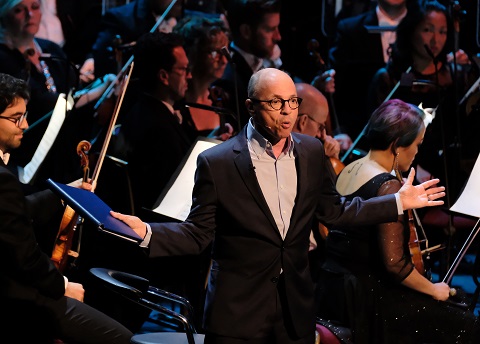 Kerry Shale. Photo Credit: BBC/Mark Allan.
Kerry Shale. Photo Credit: BBC/Mark Allan.
Robbins’ choreography may not be extant, but dance remains integral to the dynamism of the plot and the stylistic expressivity of the musical milieu. The absence of physical embodiment of the narrative in this Proms concert performance was a major hindrance, for the dance binds together the nineteen episodic scenes that carry us across New York. Some attempt at redress was made with the inclusion of a narrator, the experienced Kerry Shale, who, lyric book nestled in the crook of his arm, proved a confident story-teller, suavely linking the musical numbers; but Shale’s larger-than-life delivery only confirmed the problem, particularly in Act 2 when dance numbers predominate over song.
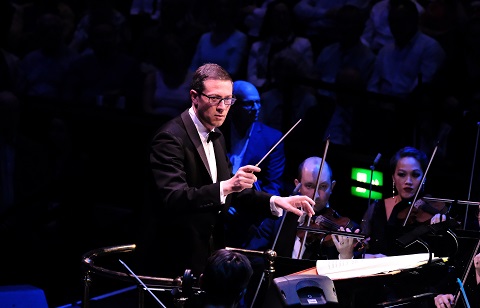 John Wilson. Photo Credit: BBC/Mark Allan.
John Wilson. Photo Credit: BBC/Mark Allan.
Second, the BBC engineers really do need to modify the ear-splitting amplification of the Proms’ musical theatre presentations. I think the volume and reverb switches were turned down after the first twenty minutes or so, but perhaps my ears, simply and sadly, just became accustomed to the head-churning echoes. The spoken dialogue was particularly deafening initially; and single-line contributions from soloists in the ArtsEd Chorus thundered over the LSO with the stridency of a regimental Sergeant Major.
There were some unintended benefits of the absence of a choreographic narrative though, chiefly that in the extensive instrumental interludes the spotlight was thrown on the music itself: the easeful flow of Bernstein’s poly-stylistic integration and the LSO’s precisely etched delivery of the composer’s jazz, blues and Broadway-vernacular cocktail. Perhaps there was a little less swing and sassiness than we are customarily treated to courtesy of the John Wilson Orchestra: others may disagree, but to my ears the brass didn’t have quite enough raspy brashness and the violin tone, while clear and singing, needed a bit more luscious Broadway schmaltz. In Gabey’s ‘Lonely Town’, Wilson’s left hand went into overdrive in an effort to coax a syrupy sheen and emotive vibrato from the LSO violins, but after the interval he seemed more restrained. That said, individual players and sections - particularly the woodwind and trumpets - played with a precision that highlighted the order and clarity of Bernstein’s musical language and form, no matter the sense of freedom and free will that it conjures. Jazz specialist, saxophonist Howard McGill, tugged the heart-strings. And, nestled at the rear was an inner band of piano (Elizabeth Burley, showing how to honky-tonk), drum-kit, brass and amplified double bass (one rhythm-invigored Laurence Ungless, I think), that brought some brazen vigour to the proceedings.
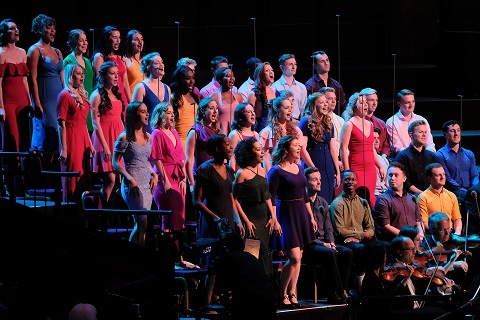 Students from ArtsEd. Photo Credit: BBC/Mark Allan.
Students from ArtsEd. Photo Credit: BBC/Mark Allan.
I had not been that impressed by the students of ArtsEd during the Proms’ concert version of West Side Story but here the young singers were much more impressively marshalled, choreographically and vocally, and, as city crowds, night club revellers, they had a firmer narrative role too. Uncredited individuals put in fine solo turns: in Act 2, Diana Dream’s parodic blues number, ‘I Wish I Was Dead’, successful trod the fine line between glamorous celebration and satirical parody. The three sailors who appeared in the organ gallery at the close to begin their own twenty-four hours ‘on the town’, delivered their closing salute with military panache and pride.
Stage director Martin Duncan made good use of the Hall’s walkways and stairwells; and the panel frieze offered vistas of New York - its arching, aspiring bridges, the underbelly of the metro, the red lights of its night-life. When Ozzie and the voracious anthropologist Claire de Loone enjoyed their amorous assignation amid the dinosaur fossils, the collapsing animation - complemented by acrobatics from the xylophone player, who simultaneously juggled rattle and whistle - raised the loudest laugh of the night.
The cast demonstrated a unanimous appreciation of Bernstein’s blend of the comedic and the serious. Much is frivolous, but it shouldn’t be flippant. Claire Moore staggered on her red stilettos in stupendous inebriation but we knew she would not topple, and her message to Siena Kelly’s fresh-voiced Ivy Smith - let your artistic dreams and goals be your guiding light, not your romantic whims - spoke surely of the feminist ambitions of the 1940s. Barnaby Rea revealed a terrifically focused low bass as the First Workman in the opening moments and was a sympathetic Judge Pitkin.
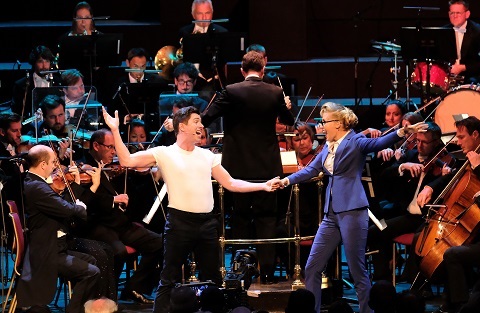 Nadim Naaman (Ozzie) and Celinde Schoenmaker (Claire de Loone). Photo Credit: BBC/Mark Allan.
Nadim Naaman (Ozzie) and Celinde Schoenmaker (Claire de Loone). Photo Credit: BBC/Mark Allan.
Nadim Naaman’s Ozzie was fittingly over-the-top without being ridiculously overblown. As Chip, Fra Fee winced with naïve gaucheness when rampant taxi cab driver Hildy launched herself upon him, in their disorderly duet, ‘Come Up To My Place’. Nathaniel Hackmann was an earnest Gabey, singing ‘Lonely Town’ with open-hearted warmth and ‘Lucky To Be Me’ with guileless honesty, but he did not neglect the humour of Gabey’s desperate trawl ‘in search of his gal’ in Act 2.
But, the male characters are largely ‘types’, and it’s the women who, more individualised and independent of spirit, who hog the spotlight. As Hildy Esterhazy, Louise Dearman was assertively but harmlessly predatory, ready to drive a cab or rustle up a cordon bleu dinner with equal élan if it would win her a man. Dearman gave an invigorating rendition of ‘I Can Cook Too’, all brassy assurance with a light-hearted patina, avowing breathlessly that she could “make a magazine cover” and be a “wonderful lover”, as well as “hit the high Cs” - and she did. Celinde Schoenmaker’s more ‘operatic’ Claire de Loone was similarly in command but, despite her tight trouser-suit, more obviously sensual, though Schoenmaker’s beautifully sweet, floating leaps to the top suggested sincerity too.
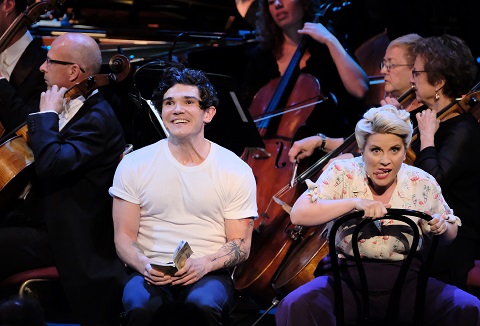 Fra Fee (Chip) Louise Dearman (Hildy) and Photo Credit: BBC/Mark Allan.
Fra Fee (Chip) Louise Dearman (Hildy) and Photo Credit: BBC/Mark Allan.
If there was one thing missing, it was the very real sadness and shadows that surely reverberate through the quartet, ‘Some Other Time’, when Chip and Hildy, Ozzie and Claire realise that their day of hunting for their soul mate is over and that they must soon return to their ship and sail off to war, and perhaps to their deaths: “When you're in love/ Time is precious stuff -- /Even a lifetime isn’t enough.”
Claire Seymour
Prom 57: Bernstein - On the Town (concert version)
Barnaby Rea (First Workman/Judge Pitkin), Nadim Naaman (Ozzie), Fra Fee (Chip), Nathaniel Hackmann (Gabey), Siena Kelly (Ivy Smith), Louise Dearman (Hildy), Celinde Schoenmaker (Claire de Loone), Claire Moore (Madame Dilly); John Wilson (conductor), Martin Duncan (stage director), London Symphony Orchestra, Students from ArtsEd.
Royal Albert Hall, London; Saturday 25th August 2018.
image=http://www.operatoday.com/On%20the%20Town%20Prom%2057.jpg image_description=On the Town : BBC Prom 57, London Symphony Orchestra conducted by John Wilson product=yes product_title=On the Town : BBC Prom 57, London Symphony Orchestra conducted by John Wilson product_by=A review by Claire Seymour product_id=Above: Cast of On the TownPhoto credit: BBC/Mark Allan
August 25, 2018
The Barber of Seville
at the Rossini Opera Festival
And the best it was, though Canadian born Europe based conductor Yves Abel had some formidable competition for being the star of the show, namely 88 year old Pier Luigi Pizzi who staged it. In turn Signor Pizzi was upstaged by Italian baritone Davide Luciano, Seville’s factotum Figaro. But even he disappeared into the shadows when Russian tenor Maxim Mironov cut loose with his brilliant “Cessa di piu resistere,” that closes the show.
Never has the patter been more cuttingly precise at breakneck speed than when Italian bass baritone Pietro Spagnoli unleashed his “A un doctor della mia sorte” nor has the malicious pleasure of “La calunnia è un venticello” been more indulged than when intoned by Italian bass Michele Pertusi.
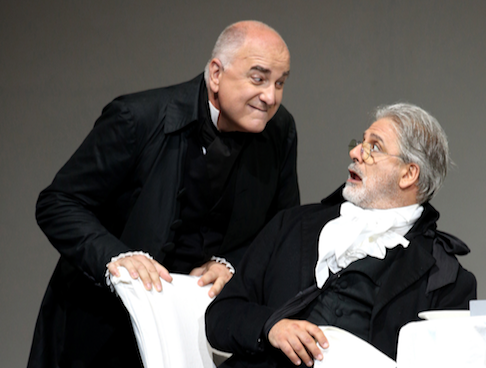 Michele Pertusi as Basilio, Pietro Spagnoli as Bartolo
Michele Pertusi as Basilio, Pietro Spagnoli as Bartolo
That Rossini himself became the true star of the show can only be credited to stage director Pizzi who stripped the comedy of any specific scenic context using only a white box, anonymous white architecture, white furniture, a visual technique that thrust his actors and Rossini’s singers into high relief. The octogenarian stage director instilled an energy of personality into this production that effected the comic process — the triumph of youth over age — in monumental terms. It was the all too rare proof that Il barbiere is indeed one of the repertoire’s greatest masterpieces.
The overwhelming atmosphere of the production was that of youth, from Fiorello, sung by Venetian baritone William Corrò, to Almaviva and to Rosina, sung by splendid Japanese mezzo soprano Aya Wakizono, and finally, and even most of all to Figaro who stripped to his culottes, jumped into the fountain and then did a beefcake parade along the catwalk fronting the orchestra pit regaling us with his “Largo al factotum!”
None of this possible, of course, without conductor Abel who propelled Rossini’s numbers onto plateaux of lyricism that bordered on delirium. Of greater accomplishment was perhaps the pacing the maestro imposed on Rossini’s parade of blockbuster numbers, allowing us to savor each of them to the fullest but leaving us resource to sink ourselves into the opera’s two gigantic finales.
There was virtually no comic schtick (sight gags) in Pizzi’s production, the innate charm of each of its virtuoso singers needing no embellishment to create character. Except the music lesson scene which itself is nothing but schtick, and usually annoying. Director Pizzi solved this in simple strokes. There was no piano. Fiorello mimicked a cello for “L’inutil precauzione” conducted by Almaviva disguised as a dwarf. When it was Bartolo’s turn to show how to sing Sig. Spagnoli leapt into falsetto soprano!
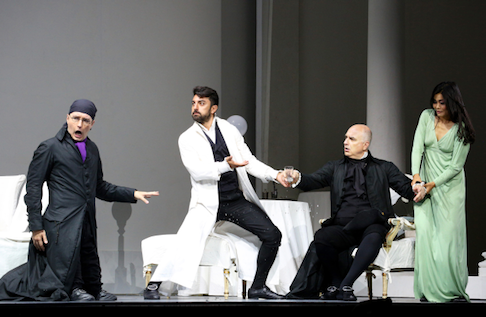 Almaviva disguised as dwarf music teacher [shoes on knees], Figaro, Basilio and Rosina
Almaviva disguised as dwarf music teacher [shoes on knees], Figaro, Basilio and Rosina
Note that before the performance I had spotted three little people among the spectators. Hopefully they enjoyed the comedy of such travesty (Almaviva had shoes on his knees) made transparent when Almaviva jumped to his feet from time to time when Bartolo wasn’t looking).
Not to forget that the storm was nothing more than the throes of fever that overtook Rosina when she thought Lindoro was betraying her, reinforcing stage director Pizzi’s firm commitment to comedy of character.
Esteemed Italian character mezzo soprano Elena Zilio sang Berta, sharing the tasks of Ambrogio, charmingly and broadly played by actor Armando de Ceccon, with little more to do that just be there to answer the door and bring in the laundry. Sig.ra Zilio’s “aria di sorbetto” “il vechhiotto cerca moglie” was met with huge applause. Note that in Rossini times sorbet was hawked near the end of a performance where such secondary arias were placed.
Sig. Pizzi directed, designed both sets and costumes, and designed the lighting with his associate Massimo Gasparon. The elegance of the costume design — abstracted formal wear in black and white, with Rosina in various solid colors — well served the elegance of the singing.
In his formative years Pier Luigi Pizzi worked as a designer with Giorgio Strehler and Luca Ronconi, incorporating much of mid-twentieth century Italian avant garde into his theatrical vocabulary. He made his Pesaro Rossini Opera Festival debut in 1982 with Tancredi. During the 1980’s as well he both designed and directed productions at San Francisco Opera, notably Simon Boccanegra, Semiramide and Orlando Furioso (though these credits are not included on Wikipedia). His productions have appeared in all of the world’s major theaters.
The male chorus of the Teatro Ventidio Basso (an historic opera house in Ascoli Piceno, a town halfway between Pesaro and Rome) was the raucous police force. The Orchestra Sinfonica Nazionale Della RAI (Italian Radio/Television) were the polished collaborators of maestro Abel.
Michael Milenski
Cast and production information:
Il Conte d’Almaviva: Marim Mironov; Bartolo: Pietro Spagnoli; Rosina: Aya Wakizono; Figaro: David Luciano; Basilio: Michele Pertusi; Berta: Elena Zilio; Fiorello/Ufficiale: William Corrò. Chorus of the Teatro Ventidio Basso, Orchestra Sinfonica Nazionale della RAI. Conductor: Yves Abel; Regia, Scene e Costumi: Pier Luigi Pizzi; Regista collaboratore e Luci: Massimo Gasparon. Arena Adriatica, Pesaro, August 19, 2018.
image=http://www.operatoday.com/Barber2_Pesaro1.png
image_description=
product=yes
product_title=Il barbiere di Siviglia at the 2018 Pesaro Festival
product_by=A review by Michael Milenski
product_id=Above: Maxim Mironov as Almaviva, Davide Luciano as Figaro [All photos by Studio Amati Bacciardi, courtesy of the Rossini Opera Festival, Pesaro]
August 23, 2018
Saul, Glyndebourne Festival
Although the production raised questions at times, with what some purists may decry as gimmicks, the performance overall presented a dark and searching exploration of the themes of power, age, love and loss. Here was a highly enjoyable and memorable examination of the human condition.
Taking its narrative from the First Book of Samuel, Handel’s oratorio – first performed in 1739 – explores the descent of King Saul, where respect for young David (who has just slain Goliath) rapidly turns to hateful jealousy of the younger man’s popularity. Glyndebourne’s revival of Barrie Kosky’s 2015 production for the Festival brought more than a streak of tragedy: here was an emotionally compelling performance full of instrumental and vocal colour.
Countertenor Iestyn Davies took the role of David, who alongside the lustrous singing of tenor Allan Clayton – who played Jonathan, King Saul’s son – provided the soloistic highlights of the evening. In the First Act, Davies provided moments of genuinely heart-stopping beauty, the lyrical power of his voice evident when the orchestra suddenly cut out, leaving the countertenor sustaining a single note on a crescendo. With masterly awareness of dynamics coupled with a silky upper register, Davies displayed a vocal control few can match. Captivating. Allan Clayton was similarly expressive, again especially striking when the texture was most exposed; there were moments when the orchestra fell silent, leaving Clayton singing quietly alone, his voice full of lyrical warmth. This was music-making of the most controlled, sensitive and nuanced degree.
Topping off a superb cast, German baritone Markus Brück played King Saul in what is his Glyndebourne debut, alongside Handelian soprano Karina Gauvin as Merab, Saul’s daughter. Brück’s voice was richly expressive, bringing out the darker colours in this most troubled of characters. Although the libretto, in my eyes at least, hardly portrays a character of great psychological complexity – the King declines to madness within the blink of an eye, hardly the nuanced depiction of madness and decline in Shakespeare’s King Lear – Brück presented a character full of emotional contrasts with a voice similarly replete with juxtaposing colours. Gauvin was equally impressive, her duet with Davies at the opening of Act 3 full of urgency.
Also in particularly fine form were The Glyndebourne Chorus, whose voices provided both musical and dramatic delight; at the point in which Saul is confronting his madness explicitly, The Chorus stride right up to the edge of the stage, feet from the audience, their powerful singing dominating the space in an effective recreation of the voices swirling through the monarch’s mind. With Kosky’s creative use of space and The Chorus’s dramatic projection of their voices, this was a supreme example of how imaginative production and performance can combine to create the most vivid portrayal of a text. The Glyndebourne Chorus’s forceful fortissimo singing and vivid characterisation were one of the highlights of the evening.
The Orchestra of the Age of Enlightenment conducted by Handel expert Laurence Cummings were also brimming with energy. The opening was full of bounce, whilst a consistently transparent texture allowed us to hear every delightful imitation in Handel’s intricate scoring. One of Saul’s unique points is its orchestration, with trombones evoking sackbuts, playing alongside kettledrums (which Handel borrowed from the Tower of London, no less), harp and carillon (a keyboard-glockenspiel). The score is therefore packed to the brim with colour, and Cummings made plentiful use of this, pointedly emphasising specific moments of instrumental contrast, most notably the tenderness of a theorbo (played by David Miller) accompanying the scene in which a declining Saul is cradled by Allan Clayton’s Jonathan.
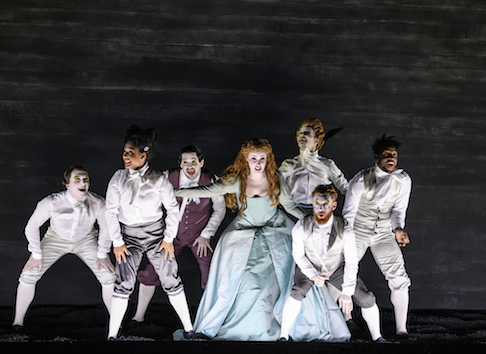 Michal (Anna Devin) and dancers
Michal (Anna Devin) and dancers
The production itself memorably played on the theme of light and dark, with effective use of stage lighting; the spotlight at the very start gently grew so as to expose the severed head of Goliath on stage, whilst later on the all-white tablecloths that dominated the stage dazzled the audience with light, perhaps a comment on Saul’s growing emotional blindness. A production highlight was the set for the final act, where hundreds of candles lined the stage, only to be gently extinguished by the chorus; this warm orange glow slowly reduced to darkness, Kosky’s staging here was a poignant moment of visual poetry.
However, if I am to make any criticism of this fine evening, it was that at times the production gave way to what some purists might decry as gimmickry; six dancers would rush onto the stage, sometimes after moments of exquisite emotional tenderness, and start gyrating at the edge of the stage. Although it brought a few laughs from the audience, I wondered whether the frequency of these interruptions was necessary, with the dancers breaking the flow of the narrative and wrecking the emotional tenderness that made many of the scenes so striking. Similarly distracting was the regularity of the shrieks and screams from the chorus, which – although a superb way of evoking the distress and the very humanity of the characters onstage – came so frequently that they detracted from their power. One scream would be striking, but ten or eleven become plain distractions.
Despite this small criticism, to the production’s credit, Kosky’s minimalism brought us back to the world of Ancient Greek tragedy, most appropriate for this Lear-like narrative; in having minimal distractions on stage in the way of set design, Kosky allowed us to focus on the human beings that are at the centre of this tragedy. Such an exposed stage drew greater sympathy from the audience because, when Saul was sat alone with just his closest family near him, his isolation was made painfully clear. Kosky appears to find that the inherent drama in Handel’s oratorios – even if they are not strictly operas, they are operatic by nature – is suited to the similarly dramatic nature of Greek theatre.[*] The influence of Greek Tragedy reminds us that, whilst this story is taken from the Bible, there are numerous parallels to Tragic plays and theatre in its progression, something Kosky’s production magnified with great effect.
An evening full of horror, delight, humour and despair all at once, this was an emotionally compelling and beautifully-performed evening. They say that a tragic story can be cathartic; no wonder everyone emerged from the theatre so full of life. An excellent evening.
Jack Pepper [†]
Editor’s Notes:
[*] According to Grout & Williams, “Wearied by the material difficulties and discouraged by the waning fortunes of opera, Handel had already begun in the 1730s to turn his attention to composing oratorios: Saul and Israel in Egypt were performed by the end of that decade, and in the following years came some of the other masterpieces by which the composer is best known today.” (p. 187)
[†] Jack, who has written for Opera Today, was invited by Glyndebourne to review their production of Saul as part of an initiative to engage younger writers in opera and opera criticism.
Photos © Bill Cooper
1818 Rossini
at the 2018 Rossini Opera Festival
A bit of a success in its time, Ricciardo e Zoraida soon disappeared to be resurrected only in 1990 by the Rossini Festival (that unquestioningly does all Rossini). Improbable as it may seem just now in Pesaro it attracted two major singers, Juan Diego Flórez as Ricciardo and South African soprano Pretty Yende as Zoraida, even though each has but one aria the entire evening.
The story is a generic, old style chivalric tale — exotic tyrant wishes to marry a damsel loved by a Christian knight, slightly complicated by a father who has his own ideas. Compared to the great Rossini tragedies of this same (Naples) period it is of slight dramaturgical interest, and therefore of lesser musical challenge for Rossini.
Its musical lines are however exquisitely Rossini, starting with the overture’s extended and quite lovely clarinet and horn solos followed by a brilliant flute display, brazenly interrupted from time to time by a raucous military band — a first use of stage musicians by Rossini, and quite startling indeed.
The African tyrant Agorante was sung by Russian bari-tenore Sergey Romanovsky whose darkly colored tenor voice soared with easy heft to the required high C’s, simultaneously sculpting elaborate coloratura in his lengthy aria. It was his one and only aria, an auspicious inauguration of this evening of spectacular vocal fireworks.
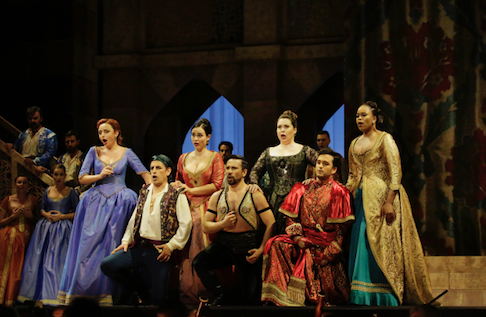 Front row Juan Diego Flórez, Sergey Romanovsky, Xabier Anduaga as Ernesto (a Christian ambassador). Back row Sofia Mchedlishvili as Fatima (Zoraide's confidant), Martiniana Antonie as Elmira, Victoria Yarovaya as Zomira (Agorante's wife); Pretty Yende (in gold gown)
Front row Juan Diego Flórez, Sergey Romanovsky, Xabier Anduaga as Ernesto (a Christian ambassador). Back row Sofia Mchedlishvili as Fatima (Zoraide's confidant), Martiniana Antonie as Elmira, Victoria Yarovaya as Zomira (Agorante's wife); Pretty Yende (in gold gown)
If Pretty Yende seemed vocally tentative in her initial scenes — a duet with the tyrant’s current wife, Zomira, becoming a trio by adding the lovesick tyrant Agorante — it was perhaps because she was simply coping with a dramatically awkward situation (the other woman), exacerbated when Ricciardo unexpectedly showed up. She did hold her own in their extended duet.
But by the time la Yende, her stage father Ircano and Ricciardo got rescued from the tyrant’s clutches she was in magnificent voice and delivered her one aria with ultimate virtuoso aplomb. Though Rossini had embedded his usual soprano showpiece finale within the larger finale (in which the Christian forces overwhelmed those of Agorante and everyone forgave everyone), the glories of her shining high notes (well above the staff) lingered and the energy of her coloratura endured earning her an ovation at the curtain calls that well surpassed the ovation awarded to Juan Diego Flórez for his splendid Ricciardo.
Tenorissimo Flórez had great opportunity to show off his high C’s and his impeccable fioratura while imbuing his character with the welcomed notion that we didn’t have to take any of this too seriously, that after all this Rossini opera was meant to be about singing and that he can do, as everyone knows.
The production was staged by French director Marshall Pynkoski, a specialist in Baroque and proto-Romantic opera. Thus the staging was highly formalized in static stage pictures. Action when demanded was in the abstract choreography of five ballerinas and six male dancers — there were pompous entrances by the tyrant, preparations for beheadings, and a great battle among other, lesser activities. The extensive choreography was created by Jeanette Lajeunesse Zingg (Mr. Pynkoski’s wife).
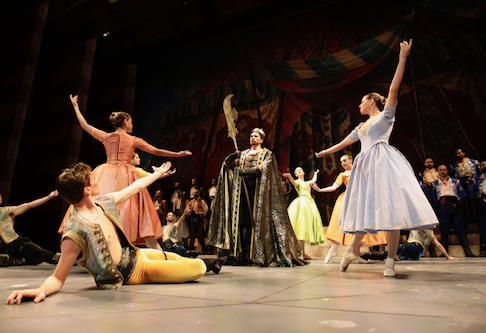 An entrance of Agorante with ballet
An entrance of Agorante with ballet
Mr. Pynkoski did avail himself of the “close-up” technique so effectively used by director Pier Luigi Pizza in the Rossini Festival’s ad hoc 1200-seat theater inside Pesaro’s massive Adriatic Arena. Singers are brought outside the proscenium onto a catwalk fronting the orchestra pit, thus eliminating all scenic and musical context. The direct contact of these superb Rossini singers with the audience was an awesome experience.
Canadian set designer Gerard Gauci, a collaborator of Mr. Pynkoski at Versaille’s Opéra Atelier offered backdrops of painted canvas in monumental shapes and somber color. Appropriate period costumes were created by Michael Gianfrancesco, a Canadian colleague of Mr. Gauci. Neither sets nor costumes, nor Mr. Pynkoski’s staging for that matter, succeeded in finding the indulgent smile we might confer on such a precious literary relic.
Italian conductor Giacomo Sagripanti presided over the Orchestra Sinfonica Nazionale della RAI. The young maestro set the elegant musical level of the evening in the overture, finding its caressing lines, encouraging the excellent solo playing, stoically tolerating the noisy stage band, then providing Rossini’s richly colored foundation for some of Rossini’s loveliest vocal lines. The maestro’s tempi kept the easy energy needed to sustain ornamental singing and at the same time drive the opera’s substantial ensembles to maximum effect.
It is not hard to fathom why Giachino Rossini returned to the very simple one-act semi-serious farsa form of his youth after creating his four magnificent character comedies, as well as coping with libretti based on Shakespeare and Sir Walter Scott among other literary luminaries for his Neapolitan tragedies — he was paid to do it (but that’s another story)!
Adina is the essentially the same story as Ricciardo e Zoraide. An older Persian caliph has taken a fancy to a beautiful prisoner of his seraglio and is about to marry her. Her former fiancé Selimo appears, whom she has believed to be dead after the shipwreck that separated them. The lovers hatch plans to escape with the help of Mustafa, the palace gardener. Ali, servant and confident of the caliph becomes aware or the plot. It fails. But as it turns out Adina is the long lost daughter of the caliph, thus Selimo need not be executed.
There are little complications to sing about. Selimo feels betrayed by Adina who is about to marry the caliph. Adina respects the caliph and is grateful to him for rescuing her. Adina believes Selimo to have been executed and is distraught.
Rossini actually recycled much of Adina’s music from his early operas and even borrowed musical material from other composers. Nonetheless Adina is still the musically mature Rossini, the vocal lines boast his ultimate sophistication. There is a splendid quartet near the end of great effect, plus a robust, exciting finale (with Adina’s splendid “Dove sono? Ancora respiro?”) composed especially for this operatic stepchild, the two pieces alone making the evening worthwhile.
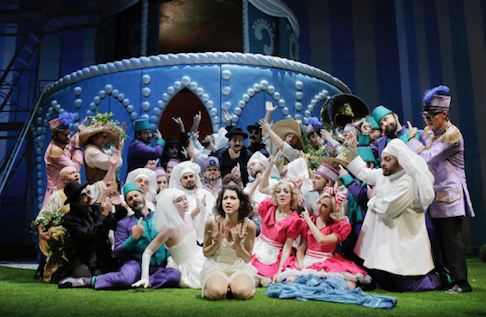 Lisette Oropesa (center) with chorus of the Teatro della Fortuna M Agostini
Lisette Oropesa (center) with chorus of the Teatro della Fortuna M Agostini
Adina was sung by New Orleans born soprano Lisette Oropesa well known to L.A. and Met audiences as Lucia. An able Rossini singer as well, she did find the singerly excitement of her final aria. Her fiancé Selimo was ably sung by South African tenor Levy Sekgapane whose aria “Giusto ciel, che i dubbi miei tu conosci” is really a beautiful duet with English horn, attesting Rossini’s mature orchestral sophistication. The caliph was sung by Italian baritone Vito Priante, bringing the energy of his usual big-house Figaro to the caliph’s lone aria “D’intorno il Serraglio.” Completing the small farsa cast were character singers Matteo Macchioni as Ali who dutifully delivered his “aria di sorbetto” (a secondary singer’s small aria near the end of an opera) and Davide Giangregorio as Mustafa.
That the singers in this new production made little impression can be attributed to its metteur en scène, Rosetta Cucchi. Sig.a Cucchi is a pianist once associated with the Rossini Festival. Turned provincial opera house stage director she is now on the artistic staff of Ireland’s Wexford Festival. This Adina is a shared production with that festival.
Rather than allowing Rossini’s farsa process to work naturally, allowing its singers to expose Rossini’s prototype characters, this director imposed a blinding, supposedly comic environment (saturated pinks, blues and greens for the decor) that overwhelmed mere Rossini.
The stage was dominated by one huge scenic image — a three tiered wedding cake with the bride and groom statuette on the top (who were real people echoing the ins and outs of the farsa action).
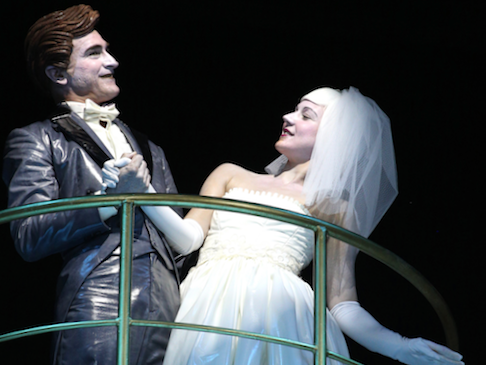 Live groom and bride statuette
Live groom and bride statuette
When the caliph wasn’t in a gold lame suit jacket for the wedding that never happened he was in a bubble bath singing his aria. Adina herself was accompanied by two mincing acolytes in short pink dresses. Selimo got off a bit easier appearing in a simple frocked shirt and gold vest as did his gardener sidekick who donned a straw hat adorned with foliage as well. The caliph’s henchmen threatened the lovers with colorful toy Uzis. There was not a turban or eunuch in sight.
A protege of Venezuela’s famed “Sistema” and now music director of Venice’s La Fenice, young (33 years old) conductor Diego Matheuz gave a fine account of this minor Rossini score, respecting the current performance practices that favor stylistically informed singers. The Orchestra Sinfonica G. Rossini, resident orchestra of Le Marche’s historic theaters (Pesaro, Fano, Jesi and Pergola) performed at its usual high level. The male chorus of the Teatro della Fortuna M Agostini in Fano (a small city 12 kilometres south of Pesaro) did its best to fulfill stage director Cucchi’s idea of what fun is not.
Michael Milenski
Cast and production information:
Ricciardo e Zoraide Agorante: Sergey Romanovsky; Zoraide: Pretty Yende; Ricciardo: Juan Diego Flórez; Ircano Nicola Ulivieri; Zomira: Victoria Yarovaya; Ernesto: Xabier Anduaga; Fatima: Sofia Mchedlishvili; Elmira: Martiniana Antonie; Zamorre: Ruzil Gatin. Chorus of Teatro Ventidio Basso, Orchestra Sinfonica Nazionale della RAI. Conductor: Giacomo Sagripanti; Metteur en scène: Marshall Pynkoski; Coreografie: Jeannette Lajeunesse Zingg; Scene: Gerard Gauci; Costumi: Michael Gianfrancesco; Luci: Michelle Ramsay. Arena Adriatico, Pesaro, August 20, 2018.
Adina Califo: Vito Priante; Adina: Lisette Oropesa; Selimo: Levy Sekgapane; Alì: Matteo Macchioni; Mustafà: Davide Giangregorio. Chorus of the Teatro Della Fortuna M. Agostini, Orchestra Sinfonica G. Rossini. Conductor: Diego Matheuz; Metteur 3n scène: Rosetta Cucchi; Scene: Tiziano Santi; Costumi: Claudia Pernigotti; Luci: Daniele Naldi. Teatro Rossini, Pesaro, August 18, 2018.
image=http://www.operatoday.com/Ricciardo_Pesaro1.png
image_description=
product=yes
product_title=The 1818 Rossini at the 2018 Pesaro Festival
product_by=A review by Michael Milenski
product_id=Above: Juan Diego Flórez as Ricciardo, Sergey Romanovsky as Agorante [Photos by Studio Amati Bacciardi, courtesy of the Rossini Opera Festival, Pesaro]
London Bel Canto Festival: Aprile Millo at Cadogan Hall
Over the years, ‘diva’ has become interchangeable with ‘prima donna’, with both terms connoting a female singer who is distinguished by the magnitude of her vocal prowess and her personal aura, both of which astonish, seduce and mesmerise. More recently, diva has often been used pejoratively, with associations of bad tempers, unreliable behaviour and narcissism.
In her London solo recital debut, legendary soprano Aprile Millo - whose official website is titled ‘The Golden Voiced Diva’ - reminded us of the original meaning of the term. For the devoted fans who had eagerly gathered in Cadogan Hall, Millo certainly is a ‘goddess’ - indeed, a critic once described her, memorably and pertinently, as the “High Priestess of that old-time operatic religion”. She also demonstrated why she is so revered by devotees of the bel canto repertory. Millo has a gorgeously rich voice of enormous power, which she uses judiciously, swelling with ease to fill the Hall but holding back to coax us into the sentiments the song. Her soprano is unfailingly supported, even across its wide range. The beauty of the sound is paramount, and the phrasing is unfailingly gracious and elegant, but there is no lack of expression and communication with the audience. It’s no surprise that her fans revere her as the upholder of vocal traditions and a successor to former bel canto heavyweights such as vocal heavyweights such as Renata Tebaldi and Rosa Ponselle.
It seems incredible that after a career spanning more than thirty years, during which Millo has performed at the Metropolitan Opera House more than 180 times, in 15 different roles, as well as in countless opera houses from San Francisco to Vienna, Milan to Moscow, Rio de Janeiro to Tokyo, the soprano had not previously appeared on the Covent Garden stage or in the capital. What finally brought her to London was the invitation to give a masterclass and perform the closing concert of the second London Bel Canto Festival (6-22 August), an international music festival and academy which, in the words of scholar, tenor and founding Director Ken Querns Langley, focuses on “the development of young singers and the reinvigoration of bel canto”. This year, students attended masterclasses by Millo, Bruce Ford and Nelly Miricioiu, before presenting a Young Artists Concert at Cadogan Hall.
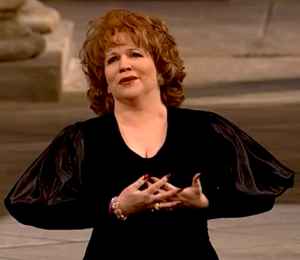 Aprile Millo.
Aprile Millo.
Hailed as ‘a new Verdi star’ when she stepped in to replace the indisposed Anna Tomowa-Sintow in Simon Boccanegra at the Met in December 1984, Millo has made Verdi’s major roles the centre of her career in the theatre and on disc, though her performances of Puccini and verismo have been equally lauded. Millo’s programme, therefore, might have been expected to have comprised ‘old favourites’, but the soprano had some surprises in store. She didn’t simply give the fans what they wanted, she gave them what they didn’t know that they wanted.
Millo, born in New York, has Italian and Irish ancestry, and this was reflected in her programme. The first half focused on nineteenth-century Italian repertoire. We had some Bellini and Verdi, but not well-known arias, rather ‘studies’ - ‘La Ricordanza’, a study of ‘Qui la voce’ from La sonnambula, and ‘Insolitaria Stanza’, a study for Leonore’s ‘Tacea la notte’ from Il trovatore - as well as Donizetti’s ‘Me voglio fà na casa’ from Soirées d’automne à l’Infrascata. And, there were songs, arias and scenes by Paulo Tosti, Ermanno Wolf-Ferrari and Lincinio Refice among others. After the interval, Millo travelled more widely, incorporating Rachmaninov and Massenet, in memory of Dmitri Hvorostovsky, two songs by Richard Strauss dedicated to the memory of Simonetta Puccini (the composer’s grand-daughter), and following these with some traditional English and Irish folksongs, some of which were accompanied by harpist Merynda Adams.
Given that in her repertoire choices Millo was straying off-the-beaten-track, it was a little surprising that no texts were provided, or at the least some brief indication of the context and/or content of each aria. From the start of her career, Millo has made known her disapproval of surtitles, telling The Washington Post in 1990 that, ‘They distract from the performers’ ability to weave the story, to make it believable and make it understood. You spend a lot of money on costumes and scenery, and then you divide attention with a piece of paper at the top of the proscenium. It makes no sense. Opera has survived this long without it.”
However, the sequence might perhaps have had a clearer narrative if the audience had had a more precise indication of what Millo was singing about. She describes her programme as “the story of a relationship in Italian songs … there are different songs for how it goes” and explains that “at one point the audience will decide whether the relationship is a success or whether it’s not. And It’s a bit of audience participation”. And, so Stefano Donaudy’s ‘O del mio amato ben’ (from 36 Arie di Stile Antico) marked ‘Falling in Love’, Paulo Tosti’s concert aria ‘Non t’amo più’ marked the ‘First Quarrel’ and both Frank Bridge’s Frank Bridge’s ‘Love went a-riding’, and ‘Cara la mia Venezia’ from Il campiello by Ermanno Wolf-Ferrari necessitated ‘A Decision’.
I particularly enjoyed the light-hearted simplicity of Donizetti’s ‘Me voglio fà na casa’ (I want to build a house), in which pianist Inseon Lee accompanied with charming insouciance as Millo rose with an effortless legato to the sustained high passages. Millo relished the drama of Bridge’s ‘Love went a riding’, and both singer and accompanist were equal to the verismo heights of ‘Grazie, sorelle’, the death and transfiguration scene from Refice’s Saint Cecilia, Lee getting her fingers around the mass of ‘orchestral’ detail with aplomb. It was a treat to hear these and other unfamiliar works, such as Tosti’s ‘Sogno’ and ‘Ideale’ (‘The Dream of Love’ and ‘The Honeymoon’, respectively, in Millo’s narrative); in these salon songs, Millo soared through the arching lines with grandeur, sensuality and compelling dramatic presence.
Perhaps those familiar with the chosen songs, or Italian speakers in the audience, could discern the development of a romance, but in the second part of the recital there was less sense of a binding narrative, and perhaps this was because Millo herself seemed on slightly less comfortable ground. There was no lack of vocal sheen, power and expressivity, but the songs in Russian, French and German require a vocal style different to the glorious weight and effortless scope of Millo’s natural bel canto. Strauss’s ‘Allerseelen’ and ‘Zueignung’, for example, had a vibrant intensity which seemed to overpower the long-breathed silkiness of the vocal writing. In the folk-songs, Millo made little attempt to modify her vocal colour, singing ‘The Rose of Tralee’ and ‘Danny Boy’ with rich lustre and a potent vibrato, but while some purists may have demurred I found her commitment to these songs to be compelling and the ‘art-song’ manner made them seem personal and honest to the singer - indeed, in her prefatory remarks she mentioned memories of her mother singing to her when she was a child.
For her final item, Millo returned to ‘home territory’, inviting baritone Jeffrey Carl to join her on the platform to perform ‘Ciel, mio padre’ from Aida (dedicated to the memory of Rita Saponaro Patene). The singers, performing from memory, immediately created a persuasive dramatic context and presented a vivid, impassioned and emotionally driven scena. Needless to say, her fans loved it, jumping to their feet and whooping their delight.
From the first, Millo engaged in a relaxed fashion with her audience, in banter and through song, revealing her humour, directness and passion. Everything was done with style, panache and a flourish - Millo even managed to make the putting on of her spectacles a ‘grand’ gesture! - and the intent to communicate, engage and entertain was evident and sustained. We were far from the hushed gentility of Wigmore Hall and I was a little surprised to find myself so absorbed by Millo’s presence and performance. At the close, I felt somewhat exhausted emotionally - and I guess this was what the soprano intended. She had drawn us into the songs and the stories, suspending our disbelief by the power of her singing and of song. When Rossini retired from the opera world in 1858, he reportedly lamented the state of contemporary Italian singing, “Alas for us, we have lost our bel canto”. Here, Millo showed that the bel canto tradition is in fact very much alive.
Claire Seymour
London Bel Canto Festival: April Millo (soprano), Inseon Lee (piano), Jeffrey Carl (baritone), Merynda Adams (harp)
Donaudy - ‘O del mio amato ben’ (from 36 Arie di Stile Antico), Tosti - ‘Sogno’, Donizetti - ‘Me voglio fà na casa’ (from Soir ées d’automne à l’Infrascata), Tosti - ‘Ideale’, ‘Non t’amo più’, Bridge - ‘Love went a-riding’, Wolf-Ferrari ‘Cara la mia Venezia’ (from Il campiello), Bellini - ‘La Ricordanza’ (a study of ‘Qui la voce’ from La sonnambula), Verdi - ‘Insolitaria Stanza’ (a study for Leonore’s ‘Tacea la notte’ fromIl trovatore), Refice - ‘Grazie, sorelle’ (fromSaint Cecilia), Rachmaninov - ‘Ne poy, krasavitsa, pri mne’ (from 6 Romances Op.4), Massenet - ‘Elegie’, Richard Strauss - ‘Allerseelen’, ‘Zueigning’ (from 8 Gedichte aus ‘Letzte Bl ätter Op.10), C.W.Glover - ‘The Rose of Tralee’, Mrs George D Presentis - ‘The Kerry Dance’, ‘Bendeemer Stream’, ‘Danny Boy’, Verdi - ‘Ciel, mio padre!’ (from Aida).
Cadogan Hall, London; Tuesday 21st August 2018. image=http://www.operatoday.com/londonbelcanto-festival%20%281%29.jpg image_description=London Bel Canto Festival: Aprile Millo at Cadogan Hall product=yes product_title=London Bel Canto Festival: Aprile Millo at Cadogan Hall product_by=A review by Claire Seymour product_id=
August 22, 2018
PROM 51 - Wagner, Strauss and a Nørgård UK premiere
We had music from the end of two composers’ careers, poised against music from the early period of another, and yet there was considerable overlap, even symmetry, to be heard. Nørgård’s Third might steal, like a magpie, from any number of contemporary and classical idioms - and for a European symphony it acknowledges elements of American music, too - but it also abounds in a harmonic, even polyphonic, language, that would have been fully recognisable to both Wagner and Strauss.
The concert opened with the Prelude to Act I of Wagner’s Parsifal. Thomas Dausgaard is one of those interesting conductors who sets very fluid, some might argue hasty, tempos for almost all the works he conducts and yet the effect tends to be rather the opposite. It’s a skilful art for a conductor to have, and it worked beautifully for the Wagner. I’ve always thought this particular prelude from a Wagner opera the most difficult to bring off in concert - one recalls Nietzsche’s quote that this music “is the sort of thing to be found in Dante, and nowhere else” - and most performances do seem to sink into some kind of Dantesque quagmire. The best, on the other hand, tend to treat the music with great suppleness, looking inwards rather than being self-consciously controlled or over-grandiose. It’s true that the strings of the BBCSSO didn’t always have the lushness or depth of tone one might have craved, but the brass were magnificent, peerlessly golden-hued, and were careful to phrase their notes. There is a thin line in this music between playing that is refined and tinged with beauty - and playing that simply seems civilized. Dausgaard very much drew the former from his orchestra, even in the Prelude’s most powerful moments, such as the ‘Faith’ theme. This was a performance that managed to achieve tension, depth and spirituality.
I’m not really sure that Strauss’s Vier Letze Lieder, sung by the Swedish soprano Malin Byström, really managed to demonstrate her artistry as a singer, nor the sheer greatness of these songs: this was a performance that was both understated, and all but swallowed whole by the cathedral that is the Albert Hall. Here we have music of ravishing humanity that is born from the destruction and annihilation of a Germany - and Europe - in ruin; music that is unashamedly late Romantic, music that refuses to embrace the brutalism and atonality that would seduce other European composers post-1945 attempting to draw a line under that very culture that had been implicated in the terror of war and the Holocaust. But these are songs that also look forward, even if the music doesn’t: they are about rebirth and renewal, a reflection on decay and the past. They are about serenity and love; life and death.
Although there can be no doubt whatsoever that Strauss had in mind these songs should be sung by a soprano, it’s much less clear what kind of soprano voice he was writing for. The composer specifically asked for Kirsten Flagstad to give the premiere, though it would be crude to suggest this is the only kind of sound he imagined; the orchestration, and even the settings of the poems by Hesse and Eichendorff, don’t easily sit with one type of soprano as decades of performance have revealed. ‘Frühling’ can be a notable problem - and it was here. Byström’s dark, tenebrous voice felt notably chilly, even distant. I found the lack of colour a little unappealing, this song’s curving lines less a barometer of the season in which it’s set, more a prelude towards the rest of the cycle. She didn’t settle into ‘September’ either - again, there was nothing really distinctive about the intricate vocal writing - Byström rarely brought an expansiveness to the text; a tendency to clip phrases only made us more aware of the beautiful phrasing of individual instruments, especially the horn writing - played outstandingly well here.
As is often the case with richer, darker voices in these songs ‘Beim Schlafengehen’ and ‘Im Abendrot’ worked better: the autumnal, spiritual depth of the poems is instilled with almost unbearable soul-searching in the music. There is something unearthly about Strauss’s orchestration in the former, though Dausgaard’s tendency to push forward with his tempi did Byström few favours in the first two stanzas. Only after the magnificent violin solo - which comes to epitomise the journey of the soul - did this song become the marvel that it is, and only here did Byström really begin to penetrate into the heart of darkness of this music, floating a wonderful top B over the orchestra and holding it until it curved effortlessly into a beautifully held pianissimo. ‘Im Abendrot’ was even darker, though perhaps Byström didn’t really feel comfortable in the upper-most registers of the voice and though Strauss is quite clear his soloist should sing single syllables in parts of this final song the effect here was more than a little peremptory.
 Per Nørgård. Photo Credit: Lars Skaaning.
Per Nørgård. Photo Credit: Lars Skaaning.
Despite having been born in 1932, Per Nørgård’s music has been scandalously underplayed at the Proms (though he’s doing rather better than the great Swedish symphonist, Allan Pettersson, who has yet to have any of his music played here, despite having died in 1980). Written between 1972-75, and premiered by Herbert Blomstedt in 1976, the Third is a titanic work, and the first of his symphonies to use choral forces. This is music that derives part of its inspiration from Nørgård’s Nordic forefathers, Sibelius and Holmboe, but it also owes a debt to late Mahler, and even to the early influence, that was to be absorbed into his later work, of the Swiss artist Adolf Wölfli, who spent much of his life in a psychiatric hospital, and from where so much of the undiluted chaos and unrepressed changes of mood in the music evolve. Nørgård’s music - especially the Third - differs markedly from that of Pettersson’s in one crucial sense: they might share a close tonality, even a common polyphony, they might also share a ferocity that can lead to climaxes that are shattering and then melt into serene tranquillity and unease, but Nørgård’s music simply isn’t driven by the same sense of lacerating despair, hypnotic bleakness or sheer terror that makes hearing a Pettersson symphony such a grim experience. Whether that is a plus is a matter of opinion, of course.
Indeed, Nørgård’s Third is inflected with American jazziness, jagged Latin rhythms and even mediaeval polyphony; it borrows from many different cultural identities, though you’ll find this musical appropriation solely at the service of the larger picture. The symphony opens on an ascent, a thundering piano chord that leads the music into a complex series of sections based on the “infinity series” - that is, endlessly similar music comparable to fractal geometry, though with the Third, as opposed to the Second Symphony from 1970 which was only based on part of the series, this symphony incorporates an infinity series that utilizes melody, harmony and rhythm. The climaxes become earth-shattering, underpinned by orchestration that includes the rumbling pedals of an organ (sounding suitably seismic in the Albert Hall, almost as if the earth’s crust had been ripped open). With the opening of the second movement, where the ideas splinter into a myriad of opposing directions, the music goes into a descent with it moving towards complete stillness. The ear picks up any number of details from the orchestra - the veiled ringing of cymbals that sound like rustling tinsel, the ghostly tolling of bells that fade into nothingness, the skeletal chiming of the xylophone sounding like broken bones, the spectral string harmonics that are played almost on the bridge of the instrument.
Perhaps inspired by his early 1970s opera, Gilgamesh, much of the final movement of the Third Symphony is taken up by a mixed chorus. It completely changes the aural picture of the work, drawing on Rilke’s ‘Singe die Gärten’, from his Sonnets to Orpheus and then at the end of the symphony a quotation from Schubert’s ‘Du bist die Ruh’, from Friedrich Rückert. You hear individual voices, as well as the combined choirs, giving the music a truly polyphonic texture.
Dausgaard - who gave the UK premiere of Nørgård’s Sixth Symphony at the Proms in 2002 - gave a compelling performance of the Third (though he has recorded the work in Denmark), and secured highly polished and brilliantly committed playing from the BBCSSO. The London Voices and National Youth Chamber Choir of Great Britain sang expertly, and solo voices were often thrilling. Only the almost universal inaudibility of the text diminished the otherwise sublime foundations on which much of the performance was based.
This is a symphony that sounds complicated, yet it is both cogent and direct. It is a work that embraces modernism, but is entirely founded on contemporary and classical models. It radiates emotion and depth of feeling, though in a somewhat incongruous way. The 86-year-old composer, who was present for this premiere, had good reason to be pleased with this concert - certainly one of the most note-worthy first performances of this year’s Proms.
Marc Bridle
PROM 51: Richard Wagner - Parsifal, Prelude to Act I; Richard Strauss - Vier Letze Lieder; Per Nørgård - Symphony No.3 (UK premiere)
Malin Byström (soprano), London Voices, National Youth Chamber Choir of Great Britain, BBC Scottish Symphony Orchestra, Thomas Dausgaard (conductor)
Royal Albert Hall, London; 20th August 2018.
image=http://www.operatoday.com/Dausgaard%20Thomas%20Gr%C3%B8ndahl.jpg image_description=Prom 51: Wagner, Strauss and Nørgård - BBC Scottish Symphony Orchestra, London Voices and National Youth Chamber Choir of Great Britain, conducted by Thomas Dausgaard product=yes product_title=Prom 51: Wagner, Strauss and Nørgård - BBC Scottish Symphony Orchestra, London Voices and National Youth Chamber Choir of Great Britain, conducted by Thomas Dausgaard product_by=A review by Marc Bridle product_id= Above: Thomas DausgaardPhoto credit: Thomas Grøndahl
August 21, 2018
The Sense of an Ending: the BBC Singers and Sakari Oramo
However, this lunchtime Prom recital at Cadogan Hall by the BBC Singers showed that he is just as at home before a 24-voice a cappella choir, his open hands as light and elegant as a bird’s wing, his gestures free, natural and masterly in crafting impassioned swells, finely graded fades and wonderfully responsive presentation of the poetic texts presented in this sequence of English part-songs, predominantly dating from early twentieth century but also including a new work by Laura Mvula commissioned by the BBC.
Oramo has been Chief Conductor of the BBC Symphony Orchestra since 2013 - fittingly his first performance as Chief Conductor came during that year’s Prom season - and during his tenure he has presided over many performances involving the BBC Singers, but this was the first time that he had conducted the ensemble a cappella. The repertoire seemed to represent both Oramo’s own love of British music, which developed during the ten years, 1998-2008, he spent as Music Director of the City of Birmingham Symphony Orchestra, and the singers’ own musical heritage. One imagines that many must have encountered these works during their early training in the country’s cathedral establishments. Certainly, they were perfectly attuned to the idiom and the result was an exquisite, blemish-free, consistent like-mindedness which was both a glory and, perhaps, a slight weakness.
For, the programme, entitled The Sense of an Ending, presented a largely homogenous autumnal sobriety and it was delivered with polite gentility and restraint, the sound never other than lovely but perhaps lacking in diversity. And this was a pity in Mvula’s Love Like a Lion, which offered plentiful opportunity for impassioned colouring of the melody and rhythmic drama, and which invited a freedom of expression which the BBC Singers did not fully embrace.
The recital opened with Frank Bridge’s strophic setting of Shelley’s ‘Music, when soft voices die’. Though unpublished until 1979, the work was composed in 1904, the same year that Bridge composed the Three Pieces for String Quartet and Novelletten for string quartet, and perhaps it is not too fanciful to hear the beautiful fusion of of four stringed instruments in the part-song’s seamless vocal blending so wonderful exploited by the BBC Singers here. If Oramo did not emphasise the way the hemiola rhythms point the text in the arching, homophonic phrases, then he did bring to the fore both Bridge’s harmonic intensifications, ‘odours, when sweet violets sicken’, and the fluid interweaving of the inner parts in the second strophe, the tenors rising high with ease and creating forward motion. The diminishing repetitions by sopranos and tenors of the final line, ‘Love itself shall slumber on’, were grounded with perfect fixity by the long pedal bass - the deep breathing of peaceful sleep.
Simple, quiet, consoling, but perhaps a part-song more suited to bringing a concert to a close. The same might be said of Ralph Vaughan Williams’ ‘Rest’ (1902), a setting of Christina Rossetti’s sonnet, ‘O Earth, like heavily upon her eyes’. Oramo skilfully captured the stillness of the first part of the sonnet, while maintaining forward momentum. The slightest of pauses before the subito pianissimo on ‘Paradise’, after an impassioned rise, was magical: ‘With stillness that is almost Paradise.’ The volta pushed forward, the sentiments now more confident, the poet desirous of union with God.
Holst’s Latin-text Nunc Dimittis for eight-part choir and soprano and tenor soloists was composed in 1915 for Richard Terry and the choir of Westminster Cathedral, but largely forgotten until it was published in 1979 in an edition prepared by Imogen Holst. The work shares with the Bridge and Vaughan Williams a debt to Tudor polyphony, sensed in the use of modality and antiphonal writing, but Holst’s harmonic language is more individualised, his engagement with the text more dynamic and sometimes surprising, as in the lightly tripping ‘Gloria in Patri’. Oramo built up the layers of the opening phrase persuasively and conveyed the expansiveness of the writing, with the sopranos bright and pure, and the lower regions warm and wholesome in tone.
Oramo explained to the audience that he had grown up with the choral tradition, not so much as a singer himself but as an admirer of the work of two uncles who were renowned choral conductors. He first encountered Laura Mvula during his Birmingham years when she was a member of the City of Birmingham Youth Choir which occasionally shared the stage with the CBSO. Oramo spoke with conviction about Love Like a Lion, admiring the way Mvula has engaged with elements from the English choral tradition and with the three poetic texts by Ben Okri which present different stages and facets of love.
The simplicity of ‘Like a child’ conveyed innocence, joy and freedom, and Mvula’s sympathetic text-setting was deeply engaging. ‘I will not die (for him)’, was more troubled, exploiting dissonances and false relations in dense, low chordal textures above which the solo soprano climbed to the stratosphere with starry purity while the baritone responded with resonant urgency. Homophonic pronouncements, ‘I know the music of the sea,/ It is a sweet death lullaby to me.’, brought the various elements back together in slightly restless concord. ‘Love like a lion’ draws on gospel traditions and though the vocal sound and phrasing were unfailingly beautiful, the BBC Singers’ rather strait-laced and polite delivery was a little discomforting; one felt that this music demanded and deserved more visceral passion.
Hubert Parry’s Songs of Farewell concluded the programme. Parry began the fourth song, a setting of John Gibson Lockhart’s ‘There is an old belief’, in 1907 but did not complete the set of six settings of metaphysical texts until 1915, two years before his death. It was wonderful to hear the six part-songs as a whole group, for they create compelling momentum as the voices expand from the initial four-part writing in the first two songs, successively adding a voice and driving towards the double choir eight-part setting of verses from Psalm 39.
Parry’s snidest critics may have quipped that he could make even a telephone directory sound devotional, but one would have to be hard of heart not to respond to Parry’s sensitivity to poetic text in these six ‘motets’, in which he seems to communicate Matthew Arnold’s declaration that poetry, not religion, could serve as a vehicle for devotional thought just as much as his own belief that music, not dogma, could inspire spiritual devotion in an age when religion seemed to have no place.
Oramo’s discerning, sensitive crafting of the musico-poetic forms embraced both the large-scale structures and the slightest of details. In ‘My soul, there is a country’ (Henry Vaughan) the angry vigour of the inner lines of the final verse - ‘Leave, then, thy foolish ranges’ - was marvellously supplanted by the assurance of homophonic conviction at the close: ‘For none can thee secure/But One, who never changes,/ Thy God, thy Life, thy Cure.’ In the following setting of John Davies’ ‘I know my soul hath power to know all things’, the merest pinching of Oramo’s fingers and flick of the wrist brought out the clipped sharpness of the poet’s admission, ‘I know my sense is mocked in everything.’ ‘Never weather-beaten sail’ (Thomas Campion) had a madrigalian sweetness while the Lockhart setting was probing and earnest, particularly in the final stanza where Oramo made the chromatic searching in the final phrase, ‘Earnest be the sleep,/ If not to waken up.’, intensely telling. After the drama and dynamism of ‘At the round earth’s imagined corners’ (John Donne), the delivery of Parry’s setting of ‘Lord, let me know mine end’ was simply marvellous; Oramo and the BBC Singers truly relished the flexible and varied choral textures and impassioned counterpoint.
Earlier in the Proms seasons I heard Parry’s Fifth Symphony performed by the BBC National Orchestra and Chorus of Wales under Martyn Brabbins and my rather flippant, and immediately revised, response was ‘Parry trying to be Brahms’. Here, though, the reference to the German master might be more valid and certainly no diminishment of Parry’s marvellous achievement in these songs; for, surely Parry was influenced by Brahms’ Four Serious Songs which he deeply admired, and he selected the same verse from Psalm 29 that Brahms set in the third part of his German Requiem.
Whatever musical shadows hang over the Songs of Farewell, Oramo and the BBC Singers offered us far-sighted illuminations of departure and a consoling Sense of an Ending.
Claire Seymour
Chamber Music Prom 6: The Sense of an Ending
Frank Bridge - ‘Music, when soft voices die’, Ralph Vaughan Williams - ‘Rest’, Gustav Holst - Nunc dimittis, Laura Mvula -Love Like A Lion (BBC co/mmission: world premiere), Hubert Parry - Songs of Farewell; Sakari Oramo (conductor), BBC Singers.
Cadogan Hall, London; Monday 20th
August 2018.
image=http://www.operatoday.com/Sakari%20Oramo%20High%20Res%201%20-%20credit%20Benjamin%20Ealovega.jpg
image_description=Chamber Prom 6, BBC Singers conducted by Sakari Oramo: The Sense of an Ending
product=yes
product_title=Chamber Prom 6, BBC Singers conducted by Sakari Oramo: The Sense of an Ending
product_by=A review by Claire Seymour
product_id=Above: Sakari Oramo
Photo credit: Benjamin Ealovega
August 19, 2018
Fables and the Fabulous from Sir Simon Rattle and the LSO at the Proms
This music is in Rattle’s blood and soul (and, he conducted the first half of the programme from memory). As a nineteen-year-old, shortly after winning the John Player International Conducting Competition in 1974, Rattle conducted a concert performance of Ravel’s one-act opera L’enfant et les sortilèges in Liverpool, a performance which won him great acclaim at the start of his career; thirteen years later he conducted the opera at Glyndebourne, confirming his natural feeling for Ravel’s meticulously refined soundscapes, pristinely ordered forms, and ironic wit. He has made several recordings of the works comprising the evening’s programme, often with the evening’s soloist, the Czech mezzo-soprano Magdalena Kozena embodying the exalted princess, Shéhérazade, or the wicked child whose tantrums result in his own torment.
Rattle’s ability to shine a gentle light between the gossamer layers of Ravel’s orchestral scores, delicately illuminating the shifting tone colours, subtle melodic utterances and splashes of brightness was evident from the first few bars of the ‘Prélude’ to Ravel’s Ma M ère l’Oye, as the silky unfolding of the paired flutes and bassoon hinted at the wide span of the imaginative world which Rattle brought quietly but purposefully to life. And, though the dreamy wistfulness was tinged with intimations of drama, danger was initially pushed aside by the wonderful warmth of the string sound as the vista opened. The beautiful string solos had plenty of space to breathe, and the solo double bass, beneath clarinets and bassoons, slid deliciously down to the depths.
The Spinning Wheel buzzed and hummed, whirling with hypnotic momentum, propelled by the whoosh of harp or flourish of celeste. In contrast, the ‘Pavane of the Sleeping Beauty’ proceeded with a measured tread, pizzicato gestures disturbing the woodwinds’ meandering with a note of tension. Rattle established a lovely waltzing lilt during the conversation between Beauty and the Beast, finding a perfect balance between the various parts but always encouraging those motifs that sustain the narrative to come to the fore. The double bass pizzicatos had the feathery lightness of a fairy’s kiss, and while Rattle ensured that contrabassoon had a dark weight which conveyed the Beast’s menace, the transformation of the Beast was stunningly magical - a transfiguration by harp and celeste culminating in an expressive, warm violin solo by guest leader Giovanni Guzzo.
The even string lines at the start of ‘Petit Poucet’ (Hop-o’-my-Thumb] painted Tom Thumb’s carefree progress through the forest and the cor anglais had just the right degree of presence. Ravel’s exquisite classical restraint and order was wonderfully communicated by the grace of line that Rattle crafted. In the ‘oriental-flavoured’ transition to ‘Laidernonnette, Impératrice des pagodas (Little Ugly, Empress of the Pagodas), what Ravel called the ‘confectionary section’ of the orchestra - celeste, harp, percussion - sprinkled sparkling magic dust; and the vivacity was enhanced by xylophone and gong in the ensuing pentatonic dance which was simultaneously graceful and restless: Rattle negotiated the metrical modulations with compelling naturalness - as if a mesmerised reader was turning the pages of a fairy-tale with unstoppable momentum. And, then came the glories of ‘The Fairy Garden’: the strings’ luscious tone, the slow and grave ambience, the heart-tugging phrasing all worked their magic. Rattle showed his feeling for the smallest temporal detail, as in the slightest rubato at the start of the final string statement which swelled from pianissimo to a blazing triumph of swirling instrumental colour with uplifting nobility.
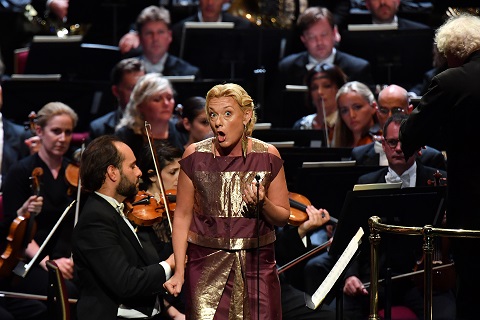 Magdalena Kozena (Shéhérazade). Photo Credit: BBC/Chris Christodoulou.
Magdalena Kozena (Shéhérazade). Photo Credit: BBC/Chris Christodoulou.
The story-telling was entrusted to Kozena in Ravel’s Shéhérazade, and, singing the vocal cycle that she recorded with Rattle and the Berlin Philharmonic in 2012 for Deutsche Grammophon, she proved as persuasive a narrator as her husband, who complemented the princess’s tales-for-survival with pointillistic precision and refinement. Kozena’s mezzo was sumptuous and radiant in ‘Asie’, unfailingly focused, even across the registers, sultry at the bottom and shining in the middle-upper blooms; her French was fairly idiomatic, and she was certainly attentive to the consonants even if the vowels didn’t always have sufficient Gallic languor.
Rattle did not miss a single gesture of rhetoric, even when Ravel asks for whispers and wisps. At the start of ‘Asie’ the asymmetrical rocking of the cellos and cool clarinet cross-rhythms perfectly captured the slightly uneasy blend of sensuality and latent primitivism - which finds further expression in the juxtaposition of harp and timpani motifs - as we set off on an exciting, unsteady but unstoppable journey.
Her mezzo almost trembling with barely repressed sensuousness, Kozena breathed desire - ‘I would like to see eyes dark with love and pupils bright with joy’ - as the viola and celli tremolando and songful violin solo offered an instrumental representation of the vocal emotions. And, just when we were on the verge of being lulled into yearnful dreams, danger surfaced in a sudden flash of vocal fire and instrumental vigour: a vision of ‘greedy merchants with scheming eyes, cadis and viziers, who with a snap of their fingers dispense at will life or death.’ Perhaps there was not enough variety of vocal colour, to match the instrumental mood- and place-conjuring of envisioned travels through Persia, India and China, but Rattle pushed on fervently and with a growing sense of violence and quasi-hysteria as the princess expressed her wish to witness juxtapositions of ‘roses and blood’ and ‘assassins smiling as the executioner slices off an innocent’s head’. The Bb peak, ‘I would like to see men die of love or of hate’, proved a step too high but it mattered not as the curtailed climax was swept up in intense instrumental ardour.
Principal flautist Gareth Davies bewitched with a lovely purity and expressive freedom in ‘La Flûte Enchantée’, and voice and ‘flute song’ blended beautifully, though I’d have liked a little more hushed mystery - Kozena was rather forthright, especially in the faster episodes. The slow tempo Rattle adopted in ‘L’indifférent’ at first surprised and then convinced, creating a tender and precious sound upon which the well-shaped, silky, lower-lying vocal lines could rest. Kozena’s precision as she snaked through the slippery chromatic lines with their enharmonic coils was impressive: a veritable vocal spell.
The spells were rather more vicious and violent in intent after the interval, though Rattle emphasised the symphonic dimensions of L’enfant et les Sortilèges, and regardless of the beguiling colours and moods we were offered as we danced through the score, the wit remained more tasteful than sardonic, and sometimes, perhaps a little too restrained? I’d have liked more sense of spontaneity and a tad more tartness to the irony.
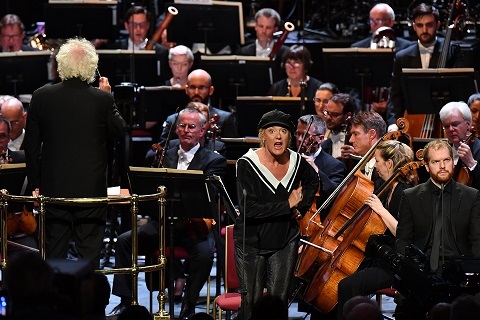 Magdalena Kozena (Child). Photo Credit: BBC/Chris Christodoulou.
Magdalena Kozena (Child). Photo Credit: BBC/Chris Christodoulou.
But, this is to nit-pick. Rattle synthesised the eclecticism of the score, revealing the meticulous polish, delicacy, proportion and elegance of Ravel’s musical language and form. The tight nasality of the oboes’ parallel fourths and fifths captured the child’s restless ennui at the start, and Kozena, now attired in sailor suit and cap, conveyed childish insouciance and inconsequence; subsequently, she communicated the wicked little boy’s realisation, growth and loss of innocence most potently.
Ravel distinguishes brilliantly between the coloration of the women’s voices, and Patricia Bardon’s mezzo-soprano had a fulsome richness befitting the Child’s ‘Maman’ - a lovely warmth which made Bardon’s later duet with Jane Archibald’s chirruping Dragonfly, prone to stratospheric micro-motifs, so heart-winning. Archibald’s embodiment of both the Fire and the Princess was one of the highlights of this Prom. She relished the floridity of Fire’s florid declaration, ‘Away! I warm the good, but I burn the bad!’ - what a glorious frisson she produced on the sustained high A’ - and as the frantic flames settled and Cinders rose, grey and sullen, from the ashes, I had a moment of revelation - so this is where Britten found the inspiration for the wood’s ‘sleep’ glissandi in A Midsummer Night’s Dream! Removing her ochre-tinted shawl, Archibald moved to the rear, raised behind the strings, to sing an impeccable plaint with the flute for her lost Cavalier - what stunning two-part modal writing Ravel crafts here - and the low flute’s sad musings were made so much more telling by the sudden rushes of rising pitch, and by the fantastic lustre of Archibald’s vocal climaxes.
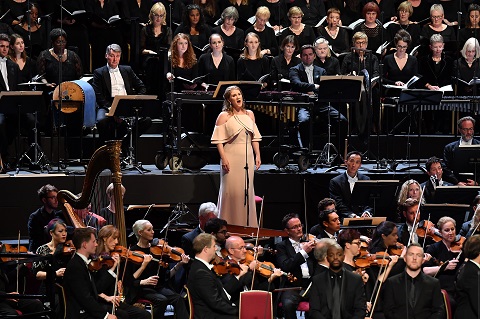 Jane Archibald (Princess). Photo Credit: BBC/Chris Christodoulou.
Jane Archibald (Princess). Photo Credit: BBC/Chris Christodoulou.
This may have been a ‘concert performance’ but there was no lack of communication, drama and interaction. Who could not envision the Sarabande that Anna Stéphany’s Louise XV Chair dances with David Shipley’s slightly louche Armchair, so flirtatious were the vocal glissandi; and Stéphany’s China Cup was similarly coquettish as it engaged in the well-known frisky Foxtrot with Sunnyboy Dladla’s big-hearted Wedgewood Tea-cup. My only regret was that the instrumental nether regions - bass clarinet, contrabassoon, trombone, tuba and bass drum - were so restrained! Might Rattle not have let them off the leash a little, and encouraged them to let rip?
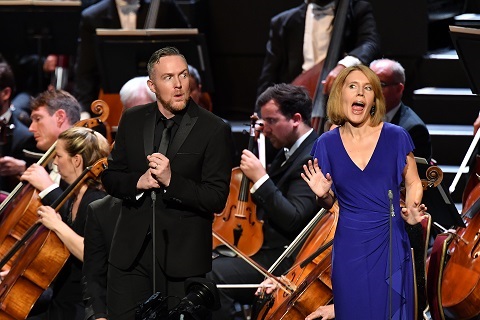 Gavan Ring (The Black Cat), Anna Stéphany (The White Cat). Photo Credit: BBC/Chris Christodoulou.
Gavan Ring (The Black Cat), Anna Stéphany (The White Cat). Photo Credit: BBC/Chris Christodoulou.
As the naughty Child swung on the Grandfather Clock’s pendulum, the pounding desperation of Gavan Ring’s ‘Ding, ding, ding!’, and the fervency and fluency of Ring’s urgent lyric ascents, brought a lump to the throat. Here, there was a smarting acerbity to the orchestral sound, though it was the honest pathos of Stéphany’s Squirrel, caged in an unnatural prison, that brought a tear to the eye. Ring and Stéphany delivered a Cat’s duet of seductive beauty, accompanied by visceral orchestral swoops and swoons which showed T.S. Eliot and Andrew Lloyd-Webber the fever pitch that feline ecstasy can reach. Elizabeth Watt confirmed a real talent for vocal characterisation as The Bat and The Owl.
Stravinsky called Ravel ‘an epicure and connoisseur of instrumental jewellery’, and Rattle gave us a practical demonstration of what he meant. This was stunning instrumental scene-painting revealing the power of musical fairy-tale to recreate the grotesque and magical, and to summon pastoral shepherds, insects, frogs and toads, dragonflies and nightingales in other-worldly ardour. The final garden scene was headily atmospheric. Perhaps the LSO Chorus may have been more spiteful and vicious in wielding their ‘talons’ and ‘teeth’ to reprimand the thoughtless Child, but at the close Rattle drew astonishingly great tenderness from his vocal and instrumental forces: a paradoxical childlike simplicity from rich musical sophistication - a wonder to beguile children and adults alike.
Claire Seymour
Prom 48: Ravel
Magdalena Kozena - Child (mezzo-soprano). Patricia Bardon - Mother/Shepherd/Dragonfly (mezzo-soprano), Jane Archibald - Fire / Princess / Nightingale (soprano), Anna Stéphany - Chair (La Bergère)/White Cat/Chinese Cup/Squirrel (mezzo-soprano), Elizabeth Watts - Shepherdess/Bat/Owl (soprano), Sunnyboy Dladla - Teapot/Little Old Man/Tree-Frog (tenor), Gavan Ring - Grandfather Clock/Black Cat (baritone), David Shipley - Tree/Armchair (bass), Sir Simon Rattle - conductor, London Symphony Orchestra, London Symphony Chorus.
Royal Albert Hall, London; Saturday 18th August 2018.
Image=http://www.operatoday.com/Prom%2048_CR_BBC%20Chris%20Chistodoulou_15%20%281%29.jpg image_description=Prom 48: Sir Simon Rattle and the London Symphony Orchestra and Chorus product=yes product_title=Prom 48: Sir Simon Rattle and the London Symphony Orchestra and Chorus product_by=A review by Claire Seymour product_id=Above: Cast of L’enfant et les sortilèges with Sir Simon Rattle and the London Symphony OrchestraPhoto credit: BBC/Chris Christodoulou
The Bassarids at the Salzburg Festival
And difficult Henze’s opera is. There is an heroic orchestra — batteries of brass, batteries of percussion, harps, pianos, guitars, it is after all the destruction of the founding family of one of ancient Greece’s greatest cities in the retelling of the last play of one of Greece’s greatest tragedians, Euripides! Not to mention two tone rows (yes, Henze was a serial composer) that configure the stark world of Pentheus, king of Thebes and the colorful world of Dionysus his challenger.
Euripides’ Bacchae was recast as an opera libretto for Henze by W.H. Auden and Chester Kallman, who provided the libretto for The Rake’s Progress and texts for Benjamin Britten. Thus here as well are the expected discussions, rather fixations on repressed sexual realities.
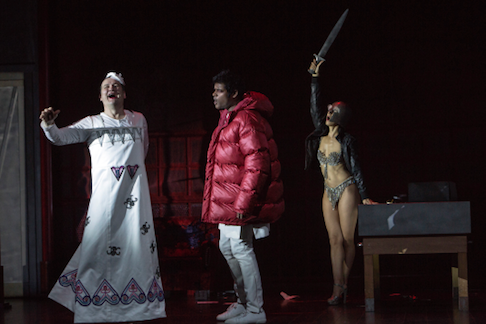 King Pentheus dressed as a woman, Dionysus plus a bacchanalia spirit (mute role)
King Pentheus dressed as a woman, Dionysus plus a bacchanalia spirit (mute role)
Essentially Semele, great grand daughter of Cadmus, founding king of Thebes, was murdered while giving birth to a son who may be the son of Zeus, and therefore a god, or maybe not. Cadmus abdicated naming Semele’s sister Agave’s son Pentheus as the new king. Pentheus has complicated feelings about his mother who is pretty complicated herself. A challenger appears who may be the god Dionysus. Everyone joins his cult. Pentheus disguises himself as a woman to learn about the cult. He is discovered by a band of women led by his mother who tear him to pieces believing that he is a lion. Dionysus removes his mother Semele from her earthly tomb and takes her to Olympus to join him as a god.
With all this on his mind Henze needed far more than his two tone rows, thus he mined musical and operatic traditions to embellish and enrich his musical manifestation of the Auden/Kallman take on the Euripides’ Bacchae. Vocal lines are comprehensible, and there actually is a sort of bel canto. There are occasional, quite beautiful arias within the opera’s symphonic structure. Bach’s St Matthew’s Passion is oft quoted, Mahler like textures and harmonies are discernible, and by musical miracle we even arrive at a momentary, truly magnificent 6/4 chord (second inversion of a triad) during Semele’s assumption!
It is magnificent, complex, highly expressive music that painstakingly delves into the psychological depths of insecure men and women, of obsession, and into the psychologies of mass social phenomena and the resulting human debasement.
But the final scene of the opera is in fact wonderfully liberating, indeed moving as Dionysus leaves Thebes and abandons the cult he has founded. He commands Persephone to open the gates of hell and release his mother that she may triumphantly unite with him upon Olympus.
Mounting Henze’s setting of the Auden/Kallman’s neurotic tale of infanticide in the massive stone world of the old riding school was a wondrous gift to famed Polish stage director Krzysztof Warlikowski. He simply spread it all out across the expanse of the riding school paddock, The a vista crypt and shrine of Semele on the far left, the private bedroom (his neurotic inner life) of King Pentheus on the far right and in between three palace rooms where the founding dynasty of Thebes was destroyed. The massive upper reaches of the riding school galleries became a metaphorical mount Cithaeron.
Henze’s choruses were crucial players in the drama, not spectators, though the chorus did begin the evening as spectators filing into the first two rows of the auditorium as the citizens of Thebes praising their new king. They quickly left and little by little they joined the Dionysian cult as did Thebes founder Cadmus, deftly enacted by venerable bass Willard White who was in good voice.
The palace prophet Tiresias — blind of course — was played by Austrian tenor Nikolai Schukoff who cross-dressed as the fey Calliope of the Intermezzo. Cadmus’ granddaughter Agave was convincingly, even heroically portrayed by Frankfurt Opera’s dramatic mezzo soprano Tanya Ariane Baumgartner. Her weaker sister Autonoe was sung by Berlin’s Komischen Oper’s Vera-Lotte Böcker.
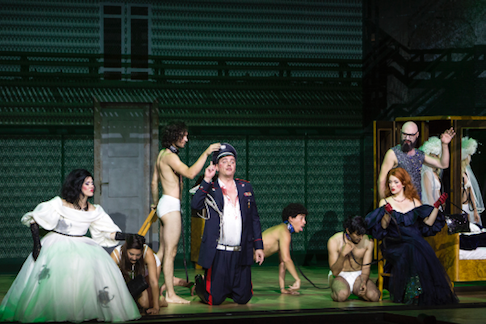 Agave as Venus in Intermezzo, with Adonis, Persephone and Calliope
Agave as Venus in Intermezzo, with Adonis, Persephone and Calliope
A more complicated if less defined character was Pentheus’ Captain (of the royal guard) sung by Hungarian bass-baritone Károly Szemerédy who doubled as the Adonis in the Intermezzo in which Dionysus’ magic mirror shows to Pentheus the unbridled sexuality of his mother — a cunningly staged scene by Warlikowski that video-mirrored the Intermezzo in black and white from its enactment far stage left onto a wall far stage right.
Pentheus’ wet nurse Beroe, sung by Dutch mezzo Anna Maria Dur, was another complex character. Hera, Zeus’ wife impersonates Beroe so that she could intimidate Semele into demanding to see her lover (Zeus) thus destroying herself. Yet Beroe expresses blind, uncomplicated maternal love for Pentheus earning our sympathy.
Canadian Opera’s baritone Russell Braun brought unbridled commitment to his portrayal of the weak, sexually repressed King Pentheus, moving from impotent authority to loss of identity, from fulfillment as a woman to honesty as a lost man. Sri Lankan-American tenor Sean Panikkar brought full spectrum to Dionysus, from cunning manipulator to the loving son of the mother he never knew.
Henze’s score is fiendishly difficult, for its singers and for its orchestra. Conductor Kent Nagano marshalled the always impressive forces of the Vienna Philharmonic into a convincing performance, simultaneously chorus master Huw Rhys James conducted (from the pit) the 100 or so voices of the concert choir of the Vienna State Opera in its huge chorus role.
Michael Milenski
Additional production information:
Sets: Christian Schmidt; Costumes: Reinhard von der Thannen; Lights: Stefan Billiger
Grosses Festspielhaus, Salzburg, August 13, 2018.
image=http://www.operatoday.com/Bassarids_Salzburg1.png
image_description=n, Hanna Schwarz as Pique Dame [All photos copyright Ruth Walz, courtesy of the SBrandon Jovanovich as Hermanalzburg Festival]
product=yes
product_title=The Bassarids at the Salzburg Festival
product_by=A review by Michael Milenski
product_id=Above: Tanya Ariane Baumgartner as Agave, the king of Thebes mother, holding high his severed head [All photos copyright Ruth Walz, courtesy of the Salzburg Festival]
August 17, 2018
Claude Debussy and Lili Boulanger commemorated at the Proms
Absurd comparisons help no one: it is not in any sense meaningful to compare one of the most important, endlessly rewarding composers of the twentieth or any other century, the creator of music as significant for its course as that of Schoenberg or Stravinsky, with that of a fine, exceptionally promising talent cruelly cut short at the age of twenty-three. This is not a competition. Suffice it to say that Boulanger’s setting of Psalm no.130 needs no apologies from anyone. It stands, never falls, on its own merits.
It certainly received no apologies in this commanding performance from the CBSO, CBSO Chorus, Justina Gringytė, and Ludovic Morlot. They clearly believed in it; so therefore did we. The piece opens - and certainly did in performance - de profundis (or rather ‘du fond de l’abîme’): dark, deep, with an intense sense of drama that pervades, impels its twenty-five minutes or so as a whole. This was a true invocation: ‘je t’invoque, lahvé, Adonaï’. In melody and harmony it seemed very much haunted by the First World War, during which it was composed (1914-17). Chorus and orchestra alike offered clarity, warmth, and heft too. As will always be the case with such a work, I could not help but think of other music of which it reminded me: occasionally, perhaps ironically, Vaughan Williams (via Ravel?), even some of Szymanowski’s choral writing, although it has none of that composer’s complexity. Debussy too, in St Sebastian mode? And yet it could certainly never be pinned down to influence, nor to ‘voice’. If Ravel at all, it was the Ravel of the Left Hand Piano Concerto - yet that was, of course, still to come: more than a decade later. Spitting, sinful song of the chorus - ‘Si tu prende garde aus péchés…’ - found itself transformed by the rich, dark, almost instrumental mezzo-soprano of Gringytė, duetting with various orchestral soloists (and a tenor from the chorus), and vice versa. This was undoubtedly a personal response to the hallowed text - yet sincerity, as Stravinsky reminded us, is never enough; it may not be necessary. The true mastery of this setting meant that, just as with many ‘bigger names’, the question never arose. Here was an ultimate illumination that was anything but naïve.
Debussy had preceded the psalm, with that foundational work of musical modernity, Prélude à l’après-midi d’un faune. Exquisitely soft and - yes, that inevitable word - languorous, its opening sounded slower than usual - not, however, to its detriment. Morlot caressed Debussy’s lines, had them luxuriate, in a way that is now a little unfashionable. Yet if phrase endings were often held back, this was no mannerism; the method made sense, just as it did when some phrases were lightly pushed, momentum building, the goal justly vague. (This is not Beethoven!) Indeterminacy may not have been born here; at the very least it seemed to have been instantiated. At times, we seemed not so very far from the world of Klangfarbenmelodie. Perhaps.
Nocturnes followed the interval. There was no doubting here that this was the fully mature Debussy. ‘Nuages’ moved - until it held back. Harmonic roots in Pelléas were perhaps unusually apparent. One felt the amorality of Allemonde beneath this sky. ‘Fêtes’ was vivid, vigorous, proceeding with fine precision and drama. There was a wonderful, hushed tension as the trumpets, followed by woodwind, came centre stage. Rhythmic exactitude seemed already to hint at the Ravel work with which the concert would conclude. (We rightly distinguish between these two giants of French music, yet sometimes it is worth asking again what they had in common too - or might do, in performance.) The close sounded unusually dark, as if invaded by forces that impelled it to the abyss (Boulanger’s abîme?) The CBSO Youth Chorus joined for ‘Sirènes’. This was a sirenic seduction that sounded very much in the line of Debussy’s Épigraphes antiques - yet with a far keener sense of harmonic adventure. I was put in mind of Nietzsche, in The Gay Science: ‘at long last our ships may venture out again, venture out to face any danger; all the daring of the lover of knowledge is permitted again; the sea, our sea, lies open again; perhaps there has never yet been such an “open sea”.’ Yes, and what dangers have ensued…
Finally came Ravel’s Boléro. The antipathy to this work bewilders me; or rather, I can understand it at some level without sharing it. Whether intended as such or no, it comes across - at least in so fine a performance as this - as experimental, even polemical: indeed as polemical as anything in Stravinsky. I was especially taken by the way the trombone soloist and then his section as a whole danced. (Now there is a misunderstood concept - as if \ must always entail licence!) Indeed all of the CBSO’s soloists and sections beguiled, in themselves and in combination: held one captive, as sirens might, at aural arm’s length, rendering us unable and unwilling to turn away. It was, moreover, quite the ‘French’ sound one heard from the orchestra as a whole, as it reached that terrible climax. Quite the odyssey!
Mark Berry
Prom 44: Debussy, Lili Boulanger, and Ravel
Debussy: Prélude à l’après-midi d’un faune; Lili Boulanger: Psalm 130: ‘Du fond de l’abîme’; Debussy: Nocturnes; Ravel: Boléro. Justina Gringytė (mezzo-soprano)/CBSO Youth Chorus/CBSO Chorus (chorus master: Julian Wilkins)/City of Birmingham Symphony Orchestra/Ludovic Morlot (conductor). Royal Albert Hall, London, Wednesday 15 August 2018.
image=http://www.operatoday.com/JG-Paul-Marc-Mitchell.jpg image_description=Prom 44: City of Birmingham Symphony Orchestra, Chorus and Youth Chorus conducted by Ludovic Morlot product=yes product_title=Prom 44: City of Birmingham Symphony Orchestra, Chorus and Youth Chorus conducted by Ludovic Morlot product_by=A review by Mark Berry product_id= Above: Justina Gringyte
Photo credit: Paul Marc Mitchell
August 16, 2018
Pique Dame in Salzburg
There were ghosts present — Jansons’ teacher Herbert von Karajan who influenced the design of the Grosses Festspielhaus to favor the Vienna Philharmonic, and Neuenfel’s artistic ancestors — Salzburg Festival founder Max Reinhardt and the surrealist poet/sculptor, Max Ernst — who formed Mr. Neuenfels to be an enfant terrible of a more recent German opera world.
No longer of an age to be thought of as enfant terrible Neuenfels nevertheless is true to form. He did create a truly surreal Pique Dame, its action frozen into multiple tableaux, tableaux that oozed the luxe of Czarist Russia, the austerity of death, the naïveté of love, the joy of sunlight, the frustration of waiting, the anxiety of searching, and so on.
Fixating on the specific mood and atmosphere of each number of Pique Dame (it is very much an old style numbers opera) the heavy pathos of Tchaikovsky’s tormented, obsessed lovers is overlooked, pushed aside to paint the moments of the story. We were no longer able to connect a flow of feeling, thus we were left with no sympathy for Hermann or for Liza. We did have a huge sense of their world.
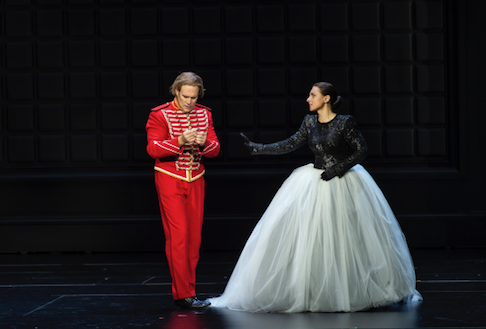 Brandon Jovanovich as Hermann, Eugenia Muraveva as Liza
Brandon Jovanovich as Hermann, Eugenia Muraveva as Liza
These atmospheres were gloriously, indeed sumptuously created in Von Karajan’s very present orchestra pit, conductor Jansons urging every possible color from the Vienna Philharmonic, its solo players and its sections creating their unique Vienna tonal world. It was this orchestra beyond compare that riveted us for the multitude of scenes that exposed the soul of the tormented composer Tchaikovsky far more than it involved us in Pushkin’s tale.
Conductor Jansons considers this opera one of the ten finest in the repertory. Though most of us would not agree we surely must appreciate his respect for the piece and for this surely once-in-a-lifetime reading.
The stage setting and costumes were huge in keeping with this orchestral magnitude. Huge gray tufted walls were set upon a black floor laden with conveyor belts used to move fixed battalions of choristers on and off the stage and to allow Hermann to remain stationary while walking, as examples. A proscenium was built into the back wall through which smaller stages were thrust forward for the pastoral performance and as a hospital room the death of the countess. As well the gray surround walls served as a screen for huge projections of storms, city streets and, of course the triumphant face of the pique dame as the production’s final image.
Each chorus number, and there are many, was specifically costumed. There were possibly one hundred choristers, dressed first as fantastically breasted Mother Gooses, keepers of the possibly 50 children chorus who arrived in cages. The choristers became bathers, then donned rain gear when the weather changed, wore party dress for the engagement scene, skeleton costumes, elaborately bustled black dresses, and the men in tuxedos for the final card game.
It was extravagant, overpowering, expensive costuming.
If the elaborate costuming of the choruses illustrated the various exotic tableaux, the principles remained rather plainly and simply dressed in their anguish. Lisa was in simple, contemporary black and white attire, the Pique Dame wore a bizarre short-shirted, pink and green concoction, clothing she shed as she slowly died.
Hermann, the obsessed gambler, masterfully enacted by American tenor Brandon Jovanovich, was from beginning to end a toy soldier in an unbuttoned red uniform. Beautifully sung through the tortured twistings of his obsessive love of Liza and his obsessive quest of the Pique Dame’s three cards (not to discount the oblique, obsessive goals of the production) he was indeed an operatic soldier of impressive magnitude.
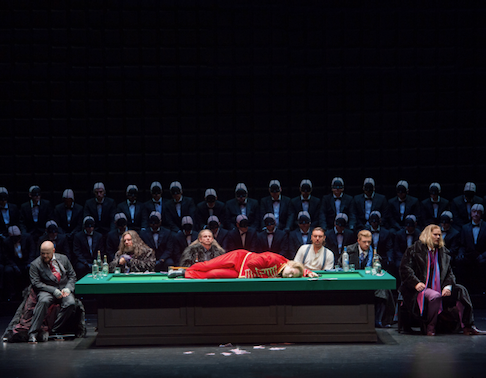 The death of Hermann, plus all named male characters
The death of Hermann, plus all named male characters
Mr. Jovanovich’s heated performance was in contrast to the distant involvement of Russian soprano Eugenia Muraveva as Liza. Mlle. Muraveva is an excellent singer of elegant presence and great reserve. Both Tchaikovsky’s Liza, and last summer’s Lady Macbeth of Mtsensk (that befell her when Nina Stemme fell ill) are well beyond her histrionic range.
The Countess aka Pique Dame was portrayed by 75 year-old, once mezzo Hanna Schwarz who brought little old lady confusion to this role usually taken by old divas of important presence. Mme. Schwartz delivered her death aria in a thin, dying voice, pathetic rather than moving, a performance well in keeping with the emotional void generated by the Neuenfels production.
The more direct and satisfying performances came from Russian male voiced imports — baritone Igor Golovatenko as Liza’s intended Prince Yeletsky, baritone Vladislav Sulimsky as Count Tomsky, bass Stanislavsky Trofimov as Surin, tenor Pavel Petrov as Chaplitsky, bass Gleb Peryazev as Narumov, and tenor Alexander Kravets as Chekalinski.
Equally impressive were the Russian female voices that completed the cast, Oksana Volkova as Polina, Margarita Nekrasova as the governess, Vasilisa Berzhanskaya as Mascha, and Yulia Suleimanova as Prilepa.
Michael Milenski
Production information:
Sets: Christian Schmidt; Costumes: Reinhard von der Thannen; Lights: Stefan Billiger
Grosses Festspielhaus, Salzburg, August 13, 2018.
image=http://www.operatoday.com/PiqueDame_Salzburg1.png
image_description=n, Hanna Schwarz as Pique Dame [All photos copyright Ruth Walz, courtesy of the SBrandon Jovanovich as Hermanalzburg Festival]
product=yes
product_title=Pique Dame at the Salzburg Festival
product_by=A review by Michael Milenski
product_id=Above: Brandon Jovanovich as Hermann, Hanna Schwarz as Pique Dame [All photos copyright Ruth Walz, courtesy of the Salzburg Festival]
August 15, 2018
Lohengrin at Bayreuth
Elsa is to be burned at the stake for murdering her brother, the fire is lighted. A cataclysmic electrical display travels across live points on monumental insulators and conducts itself through the town clock upon which a white space ship in the vague shape of a giant moth alights (other times a swan). Elsa’s savior appears in street clothes wearing insulated gloves.
Matched by an orchestral display of appropriate proportion.
He sings but he is not tenor Roberto Alagna who would have brought his unique colors and attitudes to Lohengrin had he not cancelled three days before rehearsals were to begin. There were moments throughout evening when I could hear his voice and sense his persona, matched in so many ways to the lyricism, vulnerability and delicacy of mezzo Waltraud Meier, Wagner’s Ortrud in this production.
Polish tenor Piotr Beczala stepped in to sing his first Lohengrin. His was a spell binding portrayal, heroic in its youthful strength, of unflagging voice in its careful shaping of the subtleties of text, and profoundly moving as the tragic, failed savior of the duchy of Bramant.
In this production created by German visual artists (painters) Neo Rauch and Rosa Loy, and American stage director Yuval Sharon one is not sure how the concept evolved — to wit moths (like people) are attracted to light (enlightenment) and executed (confused) by touching its energy. As unlikely a metaphor as it was, finally, it was a powerful metaphor that took us to Wagner’s philosophical plain and kept us there, director Sharon staging the action in stultifying ceremonial symmetry to achieve solid inviolable confirmation.
The phenomenal energy introduced by Lohengrin burst the bindings holding Elsa to the stake, and this was the same energy that was to have bound her forever to Lohengrin, pulses of electricity rushing along cables into the marriage chamber as he bound her with electrical cord to a giant illuminated insulator.
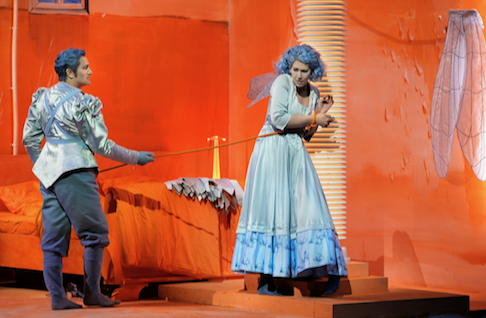 Piotr Beczala as Lohengrin and Anja Harteros as Elsa
Piotr Beczala as Lohengrin and Anja Harteros as Elsa
But Ortrud had come to Elsa in a truly magical garden (mysterious foliage moving every which way) to warn her of the dangers and the insult of accepting what she must not know. Conductor Christian Thielemann convincingly led the two women to an understanding that overcame the mandate imposed on Elsa of blind acceptance of the imposed order. The radical strength imparted by Ortrud overcame Elsa’s blind ties to Lohengrin, and she was heroically able to burst the binding of matrimony in a truly magisterial musical climax.
And in the last scene Ortrud, bound to the stake to die for her participation in Telramund’s pagan, dark world, heroically burst her bindings as well. Stage director Sharon’s world is blatantly politically correct, and always a few clever and significant steps beyond Wagner’s Romantic philosophy. Mr. Sharon simply changed Richard Wagner’s ending — Elsa does not fall dead.
In a final sacrificial act Lohengrin attaches a backpack of pure light to Elsa who, with Ortrud goes forth to found, presumably, a new, enlightened world, leaving behind, presumably, the combative, male centricity of the old order. Wagner’s dream of theater as a religious rite was fully achieved and the audience went wild with its new liberation, with its rebirth into a new, maybe better world — though a world unfortunately left undefined, and certainly unquestioned.
Note that Cosima Wagner (Richard's widow) famously went forth to preserve Wagner’s nationalistic ideals, making Bayreuth a foundation of Nazism. Note that Katerina Wagner today preserves the Wagner legacy and Bayreuth canon, and she preserves its firm national identity (no English to help a significant if small percentage of foreigners). Though Mme. Wagner has embraced electrical rather than gas lighting, and installed the latest stage machinery she has not added supertitles, thus betraying her great grandfather’s greatest theatrical ambition — an immediacy of comprehension.
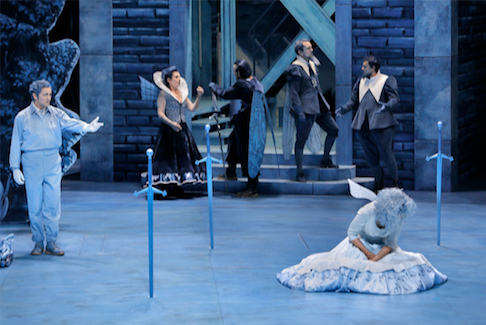 Lohengrin, Ortrud, Telramund, King Heinrich, a herald, Elsa
Lohengrin, Ortrud, Telramund, King Heinrich, a herald, Elsa
Painters Rauch and Loy’s world is brilliantly old fashioned in feel, painted drops the primary background. Sophistication abounded in the use of scrims, shadowy moving pieces and color. Architectural pieces and costumes superimposed the Medieval upon the Romantic, layered the industrial and modern, and confused the real with the fantastic, to wit pale, moth colored Elsa (well, until she was electric orange), not to overlook the moth wings, subtly worn by all the principles as if natural attire.
All the magic of Bayreuth’s Festspielhaus was in place — the hidden orchestra of absolute musical authority, the present acoustic that permits casting of artists of intimate intensity like 62 year-old Waltraud Meier as Ortrud whose voice very rarely betrayed its age and always found the full depth of character. The persuasive soprano of Anja Harteros kept Elsa as the focal point of this production, clearly sailing over the ensembles, never losing its inherent sweetness. Polish Tomas’s Konieczny had little to do other than be a force of darkness, Georg Zeppenfeld as King Heinrich was the benign moderator.
Conductor Christian Thielemann miraculously accomplished the required musical persuasion.
Michael Milenski
image=http://www.operatoday.com/Lohengrin_Bayreuth1.png
product=yes
product_title=Lohengrin at Bayreuth
product_by=A review by Michael Milenski
product_id=Above: Lohengrin's swan
Photos by Enrico Nawrath
Salome in Salzburg
Castellucci creates theater as Richard Strauss creates music. It is a language all its own, though sometimes of concrete reference it is usually an abstract flow of stimuli that create their own reality.
Here Castellucci has made a Salzburg Salome. Starting with the Latin "te saxo loquuator" (what the stones may say to you), a phrase found only in Salzburg where it is inscribed above the entry of the 18th century tunnel connecting old Salzburg with a later Salzburg built beyond its famous mountain.
Castellucci inscribes the phrase on a cloth that covers the massive galleries cut into the cliff behind the old riding school theater where he holds us in silence, save a cricket sounding. Finally the cloth parts to reveal that the galleries have been filled in with stone creating a gigantic cavern. Specific images appear, Salome in a white dress stained by menstrual blood standing on the huge mirrored floor, a displaced disk revealing a black hole.
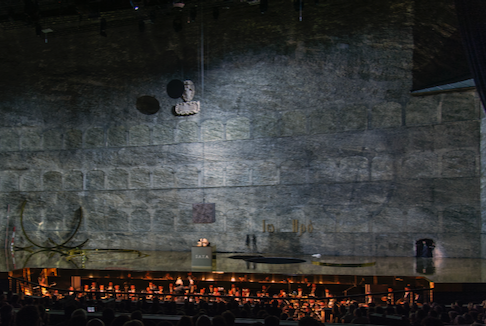 The dance
The dance
Only when we have fully entered into Castellucci’s theater does the Strauss music begin. The players of the Vienna Philharmonic and maestro Franz Welzer-Möst become very present in the Castellucci's theater world — they themselves in fact become the dance that dooms the 15 year-old princess — Salome herself folded, immobile on a pedestal during the dance, a huge square cut stone slowly descending to crush her under its massive weight (sublime choreography by Castellucci collaborator Cindy Van Acker).
Castellucci’s implacable stone world reflects everything except the black voids he creates for the prophet’s aura and for Herod’s doom. There is no color save the occasional lightening flashes of brilliant red or blue and the painted red faces of Herodes, Narraboth, and the black-hatted Jews and the Nazarenes, and the huge gold, rolling wine chalice that links the brass horns of the pit to the stage.
A live black stallion dances a vista in Jochanaan’s cistern to Salome’s orchestrally created sexual fantasy. It is the stallion’s severed head that is then presented to Salome. In the final moments of the opera Salome herself descends into a pit — the final image of Castellucci’s theater is Salome’s head, a deathly silver light illuminating her face.
Like all productions in the Felsenreitschule (the name of the old riding school theater) Castellucci’s Salome is site specific. Thus I have spoiled nothing for you by revealing a few of its more striking images — the production is and will always be unique to these stones of Salzburg and its festival and for all that this may mean.
The sine non qua of the Castellucci production is its protagonist, Lithuanian soprano Asmik Grigorian. Diminutive, lithe, of fresh and beautiful voice to her death and dramatically expansive in her movements this extraordinary artist was as real and vivid a presence in Strauss’ account of an adolescent awakening as was the black stallion that was Jochanaan.
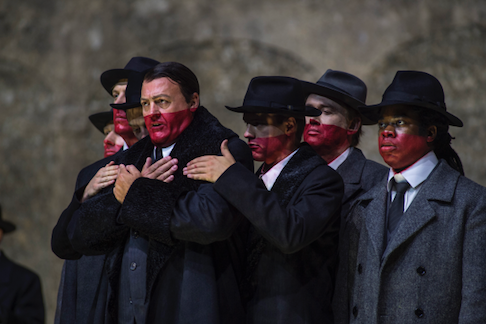 John Daszak as Herod
John Daszak as Herod
The prurient world surrounding Salome’s innocence erupted into a frenzy of battling images, during which the salient image was the cleansing of Jochanaan’s blackened body. Conductor Welzer-Möst’s orchestra created a frantic orgy of argument clearly visible in the a vista pit. The physical presence of the Vienna Philharmonic within the confines of the Castellucci theater world engendered a toxicity of enormous and hugely indulgent proportion.
English tenor John Daszak was the stark Herodes, his tormented spirit dominating every moment of Castellucci’s theater. Hungarian bass-baritone Gábor Bretz menacingly rang out his prophecies and admonitions shrouded in blackness. The pleas and imprecations of Italian mezzo soprano Anna Maria Chiuri’s Herodias were largely overlooked in the fracas of Castellucci’s powerfully masculine world, Salome its innocent victim.
Michael Milenski
Cast and production information:
Herod: John Daszak: Herodias: Anna Maria Chiuri; Salome: Asmik Grigorian; Jochanaan: Gábor Bretz; Narraboth: Julian Prégardien; Herodias' page: Avery Amereau; Jews/Nazarines/Soldiers: Matthäus Schmidlechner, Mathias Frey, Patrick Vogel, Jörg Schneider, David Steffens, Tilmann Rönnebeck, Paweł Trojak, Neven Crnić, Henning von Schulman, Dashon Burton. The Vienna Philharmonic. Conductor: Franz Welser-Möst; Production (stage direction, sets, costumes and lighting): Romeo Castellucci.
image=http://www.operatoday.com/Salome_Salzburg1.png
image_description=Asmik Grigorian as Salome [Photo copyright Ruth Walz, courtesy of the Salzburg Festival]
product=yes
product_title=Salome at the Salzburg Festival
product_by=A review by Michael Milenski
product_id=Above: Asmik Grigorian as Salome [All photos copyright Ruth Walz, courtesy of the Salzburg Festival]
August 14, 2018
Vaughan Williams Dona nobis pacem - BBC Prom 41
Neither Boulanger nor Elgar had direct experience of war, but, like all decent people with any conscience, they cared about what was happening around them, and could address the human impact of war. Boulanger's Pour les funerailles d'un soldat is a grave processional, a far more mature piece than the miniatures she is usually represented by on programmes that stress her gender and youth, as opposed to her music. A steady pace, drum rolls, the tolling of bells and rising frisson in the orchestra enhance the solemn choral backdrop. The strength of Alexandre Duhamel's delivery added even more gravitas. At the end, wordless sighs vocalized by the voices of the BBC Symphony Chorus.
This provided context for Elgar's Cello Concerto in G minor op 85 (1918-9) which, in some ways, is am abstract funeral of sorts. Jean-Guihen Queyras defined the first theme drawing out the richness, as if to savour it. Gardner and the BBCSO reiterated the theme with sweeping expansiveness. Theme and response repeat, replicating the rising and falling figures which move like processional. Queyras's tone was beautiful, suggesting the warmth of Elgar's vision, yet also pointedly poignant. As so often in Elgar, confidence is undercut by an awareness that things do not remain the same forever. Although Gardner's approach was not as full blooded as, say, Barbirolli, he conducted with refined sensitivity, which worked well with Queyras's sophisticated elegance. The sudden changes of direction were nicely defined, enhancing the interaction between soloist and orchestra. Though we've heard Elgar's Cello Concerto so many times, this approach was perfectly valid, and rewarding because it was slightly unusual. For an encore, Queyras chose Dutilleux, one of the Trois strophes sur le nom de Sacher, a brave choice in a place like the Royal Albert Hall where sensitive playing is usually drowned out. But Queyras's mastery held the audience spellbound.
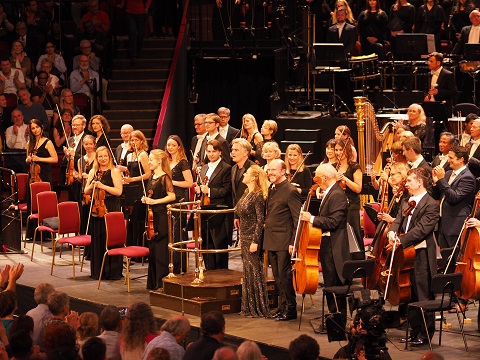 Edward Gardner, soloists and the BBC Symphony Orchestra. Photo Credit: Roger Thomas.
Edward Gardner, soloists and the BBC Symphony Orchestra. Photo Credit: Roger Thomas.
But the highlight of Prom 41 was, undoubtedly, Ralph Vaughan Williams's Dona nobis pacem, which Gardner approached with astonishing originality, bringing out the power in the message. Perhaps in modern times, we can better appreciate the visceral intensity. Gardner also drew out the structural cohesion of the piece, and even brought out its cyclic qualities, which are themselves part of meaning. Beware of over-emphasising the use of different texts. What matters is how Vaughan Williams draws together different strands of human experience into an integrated whole. Sophie Bevan stood in the organ loft, distant but not too distant, a reminder that the organ and its restrained undertones pulse at the heart of this piece. Bevan floated her lines so they penetrated the vastness of the hall, the exquisite purity of her tone reflected in the winds. Within moments serenity was shattered by savage chords, the pounding of timpani and the call of trumpets. "Beat! Beat ! Drums" is a Dies Irae in all but name, the lines swirling and whipping like flames, swept by violent forces, the BBC SO and Chorus unleashing fury.
Neal Davies sang the Reconciliation, where the word “beautiful" is repeated, not only by the soloist but by the chorus. Beautiful, because "mine Enemy is dead, a man as divine as myself is dead". This is the core "anti war" sentiment, refuting the idea that war resolves things: in death, all men are equal. Thus the deliberate phrasing, where Davies parsed the sentence with pauses. "I draw near", he continued, approaching the intimate moment of the kiss, with reverence. A violin melody singing alone, garlanded, like the soprano was earlier, by hushed chorus. Thus a brief repeat of the Dona Nobis Pacem, plaintive and austere with a rumble of muffled drums as the Dirge began, its quiet , relentless pace suggesting the cortege described in Walt Whitman's text. With the four strophes, the chorus burst out defiantly. "I hear the great drums pounding...and every blow of the great convulsive drums strikes me through and through". This is vintage Vaughan Williams in every way, with its echoes of Symphony no 3, the tag "pastoral" more ironic than literal. The text, also Whitman, refers to "two veterans, son and father" who die together, buried in a double grave, statistically an unlikely image in modern warfare, but one which works in metaphysical terms, underlining relentless futility, where one war engenders the next. No words needed in the orchestral postlude, from which Davies re-emerges as the voice of the Angel of Death; the words "Dona nobis pacem" now appear almost as screams of protest. The swirling furies of the Dies Irae return, to a text from the Book of Jeremiah."There is no balm in Gilead".
Most dramatic of all was the final section. "O Man, greatly beloved" sang Davies with fulsome affirmation, followed by orchestra and chorus in a series of quotations from the Old Testament. Gardner defined the ebb and flow, intensifying the trajectory: If all things must change, there may be resolutions beyond the grave, and from war. Thus "Dona nobis pacem" rang again, clean, pure and bright, Bevan holding the last words so they seemed to vibrate into eternity.
Anne Ozorio
image=http://www.operatoday.com/%28c%29%20Sussie%20Ahlburg%201.png
image_description=Sophie Bevan [Photo © Sussie Ahlburg]
product=yes
product_title=Ralph Vaughan Williams, Edward Elgar, Lili Boulanger, - Edward Gardner, BBC Symphony Orchestra, BBC Symphony Chorus, Jean-Guihen Queyras, Sophie Bevan, Neal Davies, Alexandre Duhamel. BBC Prom 41, Royal Albert Hall, London - 12th August 2018
product_by=A review by Anne Ozorio
product_id=Above: Sophie Bevan [Photo © Sussie Ahlburg]
August 12, 2018
John Wilson brings Broadway to South Kensington: West Side Story at the BBC Proms
The John Wilson Orchestra Prom is a greatly anticipated annual highlight of the Proms season, and in recent years Wilson and his band have celebrated the music of George Gershwin, Cole Porter and, in 2015, Bernstein himself ( Bernstein: Stage and Screen ). The concert was billed in some sources as the first time that Arthur Laurents, Leonard Bernstein and Stephen Sondheim’s complete concert version of the musical had been performed in the UK - though Bernstein-protégé Justin Brown conducted the LSO in a Collins Classics summer pops performance in 1990, with Derek Chessor (Riff), Cynthia Hayman (Maria) and Kurt Streit (Tony) in the leading roles. But, perhaps on that occasion the score was truncated - and it matters not: this was certainly the first complete performance of this version at the Proms, and Wilson and his musicians didn’t disappoint those who had reportedly been queueing since the early hours for day-passes. The RAH was packed to the rafters for the evening performance, the second of two that day, and the audience made their prior excitement and subsequent appreciation heartily felt and heard.
Wilson’s baton is a live wire: it jives with the silky slipperiness of the most sinuous snake, ducking and diving, neatly and niftily. With an occasional tight sway and precise, sometimes miniscule movements, Wilson indicates his intent with economy and authority, and every player knows exactly what he wants. The twenty-one violins and eighteen cellos and double basses played with plush richness; woodwind solos had space to sing; the bright big-band brassiness was alternately polished and rasping; the two percussionists juggled the panoply of chimes, maracas, whistles, cymbals and sundry sound-makers with calm dexterity. Quite simply, I felt as if I was wallowing in orchestral luxury from the first off-beat pizzicatos which initiate the Prologue to the violins’ pianissimo reminiscence of a fragment of ‘Somewhere’ which brings the tragedy to a close.
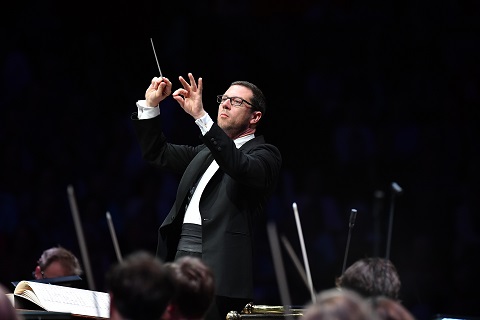 John Wilson. Photo Credit: BBC/Chris Christodoulou.
John Wilson. Photo Credit: BBC/Chris Christodoulou.
Tempi were on the swift side which was great for ‘Something’s Coming’ and ‘The Dance at the Gym’ but, while it might be judged that the up-tempo ‘Maria’ communicated the impetuousness of Tony’s passion, ‘Tonight’ needed a little more spaciousness for the phrases, and the singers, to breathe. In the latter, though, the voices of Mikaela Bennett (Maria) and Ross Lekites (Tony) blended with beguiling ease.
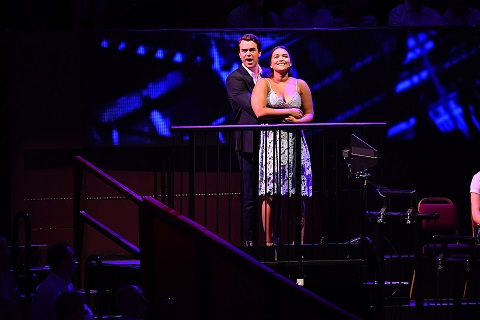 Ross Lekites (Tony) and Mikaela Bennett (Maria). Photo Credit: BBC/Chris Christodoulou.
Ross Lekites (Tony) and Mikaela Bennett (Maria). Photo Credit: BBC/Chris Christodoulou.
After the pre-season ‘fuss’ about casting - which saw Olivier-award nominated Sierra Boggess (Phantom of the Opera, The Little Mermaid, and House of Rock) withdraw from the role after criticism that Latina/o actors had been overlooked - Bennett proved an open-hearted, pure-toned Maria, who kept her vibrato in check at moments of romantic innocence and sincerity (‘One Hand, One Heart’), soared with beautiful sweetness, and made ‘I Feel Pretty’ more convincing that it sometimes is, aided by some terrifically expressive string accompaniment.
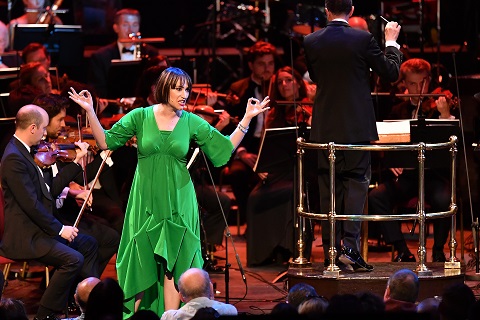 Eden Espinosa (Anita). Photo Credit: BBC/Chris Christodoulou.
Eden Espinosa (Anita). Photo Credit: BBC/Chris Christodoulou.
Lekites (moonlighting from Frozen on Broadway) made good use of his high baritone to convey just the right note of frankness and naivety, and had sufficient heft to hint at the heights of Tony’s romantic ardour, though there was little ‘chemistry’ between this pair of star-crossed lovers. Eden Espinosa was a vivid Anita, at least vocally, though not entirely convincing dramatically; that said, ‘America’ suffered particularly from the absence of a stage milieu, and in terms of orchestral flair this number was stunning. What wonderful orchestrations Bernstein, Sid Ramin and Irwin Kostal devised between them - it seemed that the double basses might achieve rocket-style lift-off from their stools as they attacked the triplet syncopations with true panache and gusto. Alistair Brammeri and his fellow Jets whipped through ‘Gee, Officer Krupke’ with spice and punch. And, while I was wondering why Louise Alder had been drafted in to sing ‘Somewhere’, she appeared in the organ loft and sang, literally, like an angel - and my unasked questions evaporated into the ether, extinguished by the pure luminosity of her soprano.
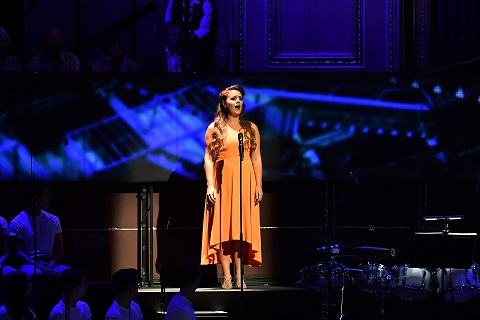 Louise Alder (soprano; ‘Somewhere’). Photo Credit: BBC/Chris Christodoulou.
Louise Alder (soprano; ‘Somewhere’). Photo Credit: BBC/Chris Christodoulou.
This might have been a ‘concert’ version, but stage director Stephen Whitson made use of every RAH stair-well, balcony and platform. What was ‘missing’ however, was dramatic context. There was no dialogue, excepting some spoken text over the sung numbers and one or two introductory phrases (perhaps this was fortunate, as the amplification volume button was turned up so high the spoken text would surely have become as muddied as some of the busier orchestral dialogues, which were at times cloudy despite Wilson’s fine baton-work).
And, though the cast were costumed - tight coloured ti-shirts for the muscled Jets and Sharks, ’50s frocks (some more flattering than others) for the ladies - there was little sense of the upper West Side Manhattan milieu, or the urban tensions between the white Americans and Puerto Rican immigrants which underpin the dramatic frissons. The latter find expression not just in Laurents’ book and Sondheim’s skilful lyrics, and, of course, in the score itself, but also in Jerry Robbins’ choreography - a veritable narrative ballet - and the absence of the danced expression and drama was a more serious deficiency - all the more so as for last year’s Oklahoma! it had proved possible to stage all elements that form the ‘whole show’. The second act suffered especially from the lack of theatrical context, for here the dramatic structure needs all the constituent parts to be pulling their weight. The tragic denouement seemed to take the Hall unawares, and lacked gravitas and pathos. We did have a ‘Chorus’ - the students of ArtsEd and Mountview theatre schools - tiered behind the orchestra stage-right, though their slightly clumsy choreographed ups-and-downs and ‘dramatic gestures’ didn’t make much impact.
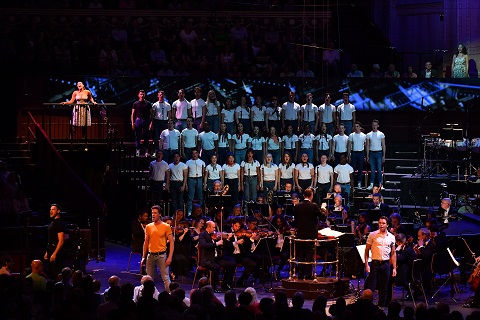 Students from ArtsEd and Mountview. Photo Credit: BBC/Chris Christodoulou.
Students from ArtsEd and Mountview. Photo Credit: BBC/Chris Christodoulou.
One positive outcome of these mildly irritating short-comings was that the emphasis was thrown on the music - Bernstein’s wonderful eclectic fusion and Wilson’s heart-winning rendition of it. As Nigel Simeone recalled in his programme article, when Kenneth Tynan saw West Side Story on Broadway in 1958 he described the score as ‘smooth and savage as a cobra’. Perhaps a little more grit, even vulgar earthiness, would not have gone amiss at times, but who could not relish such lustrous lavishness and sweetness as we enjoyed.
Claire Seymour
Bernstein: West Side Story (concert version)
Maria - Mikaela Bennett, Tony - Ross Lekites, Anita - Eden Espinosa, Riff - Leo Roberts, Bernado - Gian Marco Schiaretti, Rosalia - Emma Kingston, Francisca - Laila Zaidi, Consuelo - Jocasta Almgill, Snowboy/Big Deal - Christopher Jordan Marshall, Action - Alistair Brammer, Baby John - Jack North, Diesel - Michael Colbourne, A-Rab - Fra Fee, Officer Krupke - Phil Barnett, Louise Alder - soprano (‘Somewhere’); John Wilson (conductor), Stephen Whitson (stage director), John Wilson Orchestra, students from ArtsEd and Mountview.
Royal Albert Hall, London; Saturday 11th August 2018.
image=http://www.operatoday.com/JWO%20title.jpg image_description=West Side Story: BBC Prom 39, John Wilson Orchestra product=yes product_title=West Side Story: BBC Prom 39, John Wilson Orchestra product_by=A review by Claire Seymour product_id=Above: Cast of West Side Story, John Wilson and the John Wilson OrchestraPhoto credit: BBC/Chris Christodoulou
August 11, 2018
Glyndebourne announces new Artistic Director
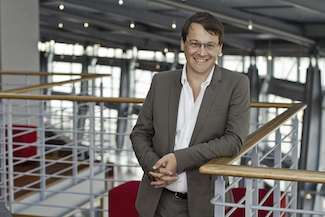 Stephen Langridge has been appointed Artistic Director of Glyndebourne. Stephen is currently Director for Opera and Drama at Gothenburg Opera, Sweden, a role he has occupied for five years. He will take up his new role at Glyndebourne in spring 2019. . . . [More]
Stephen Langridge has been appointed Artistic Director of Glyndebourne. Stephen is currently Director for Opera and Drama at Gothenburg Opera, Sweden, a role he has occupied for five years. He will take up his new role at Glyndebourne in spring 2019. . . . [More]
Prom 36: Webern, Mahler, and Wagner
My most recent published book, After Wagner, would have been and was originally intended to be quite a different endeavour, had the example of Stefan Herheim’s production of Parsifal and many other performances and productions not intruded and helped shape it otherwise. Not only did a concluding chapter on staging and performance turn into a fully fledged third part (of three chapters); perhaps more importantly, I began to read back such concerns into more ‘work-based’ writing too. Indeed, the idea for the first chapter, on Parsifal ‘itself’, initially intended as a self-standing article, arose from my reflections on another production of that work : in many ways, a very bad production, however wonderfully performed, yet one that still had me think about the role of history and historical thinking in Parsifal.
And so it was with this Prom concert too. Hearing Esa-Pekka Salonen and the Philharmonia in Webern’s Five Orchestral Pieces, the opening Adagio to Mahler’s unfinished Tenth Symphony, and the first act of Die Walküre had me scribble in my programme booklet, lest I forget, not only that I should add a specific reference to Webern and Wagner’s unendliche Melodie (‘endless melody’) in what I am currently writing. I should also explain more clearly, I realised, in the section I had drafted that afternoon, how the legacy of that idea for so much twentieth-century music, Mahler’s included, was predicated on a qualitatively different understanding of ‘melody’ from that which previously had held sway – and still, in certain quarters, does:
The term has often been misunderstood; it has little to do, even in Tristan, with the long phrases of Italian bel canto opera, but rather refers to the need for each and every note to be expressive, significant within the whole. Therein surely lies one of Wagner’s most important legacies to Schoenberg, his pupils Alban Berg and (especially) Anton Webern, and beyond, to Boulez, Stockhausen, et al. It is as much a way of understanding the greatest music of the past – usually, yet not necessarily Austro-German – and of placing works, here the Ring, within that lineage as it is of offering prescriptions for the ‘music of the future’ (a term Wagner endowed with often unacknowledged irony).
Whether that thought will make it into the final cut remains to be seen – my co-editor may be cursing yet another round of Wagnerian expansion on my part – but it can remain here, at least, with thanks to the performers and indeed to the Proms.
For, as Carl Dahlhaus pointed out, when Wagner coined the term, he did so with respect to Beethoven, divining in the Eroica Symphony the unfolding and development of a single coherent melody – perhaps not so very different from what Schoenberg, defying interpreters ever since to make final sense of his term, called the Idea of a musical work – an idea of an Idea that was unquestionably familiar and congenial to Webern, if not necessarily to be identified with his. ‘According to Wagner,’ Dahlhaus continued, ‘music is “melodic” when every note is eloquent and expressive; and in contrast to a “narrow melody,” in which the melodic element is continually interrupted in order to make room for vacuous formulae … avoidance of cadences is not the nature of the principle, but one of its consequences.’ Such was what we heard in Salonen’s – and the Philharmonia’s – Webern and Mahler, at least insofar as audience bronchial activism and telephone calls permitted. Salonen’s principal revelation here, at least for me, was Webern’s build-up of harmonic tension, owing much to Wagner, and in Webern’s case at least to Brahms too, on the (relatively!) micro- and macro-levels. Not that that was at the expense of other parameters (as Webern’s fruitfully unfaithful successors would soon term them), nor at the expense of ‘character’, but rather underlying them. Hearing op.10 and the Adagio together, the one emerging from the other, was a masterstroke: a familiar enough idea in itself now, largely thanks to fellow composer-conductors such as Michael Gielen and Pierre Boulez, but not always endowed with such immanent meaning. We heard what was different too, of course, the particular quality of Webern’s iridescent sweetness, his dancing: so much more echt-Viennese, for better or worse, than the ever-alienated Mahler, who perhaps speaks in more familiar tones yet to us and our condition. (Assuming, that is, we are not all Austro-German nationalists!) Yet the overwhelming quality of the climaxes, musically prepared, never appliqué, had much in common – provided, that is, one listened. How keenly, moreover, one listened to the intervals and their import at the close of the Mahler, having been led to do so by Webern – and how keenly would one therefore be led to do so in the first act of Die Walküre, following the interval.
Wagner’s storm cleared the Mahlerian air – just as was happening outside the Albert Hall in ‘real’ life too. Robert Dean Smith as Siegmund sounded in better voice than I have heard him for quite some time. Certainly his opening phrase was such as one could have taken dictation from it, verbal and musical: an implied caesura both from the expressionism of the first half and from the inhuman dialectics of Das Rheingold, whose precedent was implied to many of us. Anja Kampe’s Sieglinde answered with almost instrumental colour – a modern chalumeau, perhaps – which yet did not preclude the keenest verbal response to Wagner’s text too. As so often in Wagner, as in Mahler and Webern, emphasis upon one element and excellence therein heighten rather than detract from other elements. It was clear, very soon, that this woman was damaged (are not all the characters here?) but also that she was emphatically a human being and a woman. Philharmonia chamber music – as with Liszt, most of Wagner’s chamber music is to be found in his orchestral writing – both beguiled and underlined dramatic tension: Hunding was already present in absentia. The sadness of cellos en masse commented on and extended the message of that unforgettable cello solo at the beginning of the scene. Wind anticipated the springtime (Lenz) with which Sieglinde would later identify Siegmund.
Enter Hunding. Franz-Josef Selig, in one of the greatest performances I have heard from him – which is saying quite something! – endowed Wagner’s Stabreim with all the significance it needs, and which yet it does not always receive. Selig realised and communicated how those consonants interact with the vocal line and indeed with the orchestra. So too, clearly, did Salonen. Unendliche Melodie! The febrile, almost Erwartung-like orchestral cauldron Salonen stirred drew attention to how anti-melodic, in the bel canto sense, these vocal lines can sometimes be – even in this, one of the most lyrical of the Ring acts. Occasionally, Dean Smith sounded a bit tired here, but he recovered – and really made the most of his role as saga narrator, as did Selig. One could almost see the ghostly horses of past, invisible dramas; one certainly heard them. Gurrelieder seemed but a stone’s throw away. Whilst Sieglinde was silent, one could not help but notice that she was. Hunding’s venom – not a quality I have usually associated with the often kindly Selig – was such as to draw still greater attention to the lack of a female voice. Timpani upon his departure, likewise brass response, further darkened the scene.
One of the few doubts I entertained about the entire performance was the excessive – to me, at any rate – holding of Dean Smith’s second ‘Wälse’. Still, if that is all I have to say on the negative side, there should be much rejoicing in Valhalla. Kampe’s return incited that turn to the vernal at which she had previously hinted, Philharmonia woodwind especially responsive – and generative. How she spun her line, verbally and musically: she might almost have been taking lessons from Wagner in Opera and Drama on the poetic-musical period. Perhaps, indeed, she had. It certainly was not long before her delivery sent shivers down this particular spine. That identification of Siegmund, as yet with ‘Lenz’ took place in more of a hothouse setting than often one hears, testament doubtless not only to Salonen’s long experience with Tristan, but also to the re-examined standpoint from which he is now addressing the Ring. Release when she named him Siegmund was as much musical as – well, whatever else you want to call it. Preparation had proved just as assured as in Mahler and Webern, and had doubtless, quite rightly, been coloured by Wagner’s posthumous history in their work. This, then, proved to be a performance both magnificent and fruitful. Salonen would seem to have come to the Ring in earnest at just the right, or at least a right, time – for him, for me, and, I hope, for you too. We shall see, or rather hear, over the next few years as his Ring gathers pace both in concert and in the opera house.
Mark Berry
Programme:
Webern: Five Orchestral Pieces, op.10; Mahler, ‘Adagio’ from Symphony no.10; Wagner: Die Walküre, Act I. Siegmund: Robert Dean Smith; Sieglinde: Anja Kampe; Hunding: Franz-Josef Selig. Philharmonia Orchestra/Esa-Pekka Salonen (conductor). Royal Albert Hall, London, Thursday 9 August 2018.
image=http://www.operatoday.com/Salonen_Suomela.png image_description=Esa-Pekka Salonen [Photo by Benjamin Suomela] product=yes product_title=Prom 36: Webern, Mahler, and Wagner product_by=A review by Mark Berry product_id=Above: Esa-Pekka Salonen [Photo by Benjamin Suomela]Glyndebourne announces new Artistic Director
A strong advocate of contemporary music, he has directed several world premieres, including productions for the Royal Opera House, Aldeburgh Festival, Dutch National Touring Opera and Glyndebourne.
His work also includes productions of Otello for Salzburg Festival, Parsifal for the Royal Opera House and La damnation de Faust at Lyric Opera of Chicago as well as several productions at Gothenburg Opera.
A passionate believer in music education and talent development, throughout his career Stephen has alternated between the leading operatic stages and groundbreaking community projects. He is the son of the late tenor Philip Langridge.
Stephen commented: ‘Underlying all my work is the belief that opera is a natural and dynamic form of human expression, to which everybody should have access, both as a participant and audience. I am thrilled to take up this appointment as Artistic Director of Glyndebourne, and join the superb team of talented and ambitious people making extraordinary and transformational opera experiences.’
Gus Christie, Executive Chairman of Glyndebourne and acting Artistic Director, said: ‘I am delighted that Stephen will be joining Glyndebourne as our new Artistic Director - having worked here as a director back in the 1990s, he has a strong understanding of the company. From both his work as a stage director all around the world and his experience running the Gothenburg Opera house, I am confident that he will be a great fit for the company and I am very much looking forward to having him co-leading Glyndebourne in the coming years.’
Robin Ticciati, Music Director of Glyndebourne, said: ‘I am hugely looking forward to creating Glyndebourne’s next chapter with Stephen. His vision of what opera can represent for people today and how it can develop as an artform excites me greatly.’
As Artistic Director, Stephen Langridge will join Sarah Hopwood, Managing Director, who together will co-lead Glyndebourne and ensure it achieves the highest artistic standards, whilst maintaining the financial independence that enables it to be bold and innovative.
image=http://www.operatoday.com/Langridge_Stephen_Konstn%C3%A4rlig_Ledare_Opera_Drama%20%281%29.jpg image_description=Stephen Langridge appointed Artistic Director of Glyndebourne Festival Opera product=yes product_title=Stephen Langridge appointed Artistic Director of Glyndebourne Festival Opera product_by=Above: Stephen LangridgeAugust 9, 2018
Prom 33: Thea Musgrave, Phoenix Rising, and Johannes Brahms, Ein deutsches Requiem, op.45
No matter: the concert was what it was, concluding in a truly excellent performance of Brahms’s German Requiem, infinitely preferable to a curiously vacuous one I heard last autumn – perhaps more the time of year for it – from starrier forces in Berlin .
First, however, came Thea Musgrave’s 1997 orchestral work, Phoenix Rising, its title taken from a sign outside a Virginia coffee shop, its programmatic subject matter that of, well, a phoenix rising from the ashes. Its opening éclat promised much, very much a presentiment of the sharpness – rhythmic, yet not only that – of the rest of the BBC Symphony Orchestra’s performance under Richard Farnes. It could have been the prelude to a stage work; I could not help but wonder if it might have been better off that way. For the piece’s initial post-Peter Grimes dramatic tension dissipated somewhat, transforming in a different way from the phoenix, into a competent yet hardly earth-shattering tone poem. Unrepentantly tonal, it came to sound more like film music than a concert work. Visual theatrics, in which the excellent timpanist cued a bass drum player above, before downing his sticks and leaving the stage amused and/or puzzled, yet seemed to lack motivation in to the musical material (other than his ceasing to play for a while, before being heard at the end, off-stage). It was interesting to hear a Proms premiere from a composer long overlooked in this country; I doubt I should hasten to hear it again.
The introduction to the opening chorus of the Brahms, ‘Selig sing, die da Leid tragen’ – from the Beatitudes, of course – truly set the scene for the rest of Farnes’s reading. Combining serenity with a hint of harmonic grit often missed, he pointed to the location of meaning in Brahms’s harmony. It is all there, pretty much. In the words too, of course, but one might have a pretty good feeling for what this splendidly Lutheran humanist – in more than one sense – work was about even without. Or so one imagined. At any rate, the BBC Symphony Chorus, upon its entry, ensured that we never had to find out, its rounded tone of consolation just the thing – as was its diction. The movement remained founded, even grounded, upon its bass line, orchestral and choral. This was to be a ‘natural’, unaffected performance of the very best kind.
The following chorus’s roots in early music – not only Bach and Handel, not only Schütz, but earlier – were clear at its opening, without any need to underline, to highlight. Once again, the placing of chords, the path of harmonic progressions, mattered in work and performance, yet without a hint of pedantry. Soft, which is not to say weak, foreboding, ‘All flesh is as grass’, grew and grew through the great sarabande processional. Brahms may not have been a Believer, but he knew what belief and Belief were. The central section, ‘So seid nun geduldig…’, was taken more swiftly, with greater contrast, than often one hears; it worked very well indeed, heightening expectancy in words and music alike. A sense of return, musical as much as theological, was finely achieved thereafter, with the return of the opening material, prior to turning of the corner, clean and warm: the Lord’s Word would endure for ever. Again swifter than usual, the closing section worked splendidly, the foretelling of heavenly rejoicing almost akin to a choral climax in Haydn. Farnes shaped this music, as that of the whole, with powerful yet unobtrusive understanding.
Johan Reuter proved a sincere soloist, his diction also excellent, in ‘Herr, lehre doch mich’, the chorus engaged in a dark game, or perhaps better ritual, of versicle and response. Subtle darkening of instrumental colours as the psalmist reflected upon the humbreing of his days proved just as telling as the vocal line itself. A swift closing once again worked; it was not hard-driven, but a release that was again as much musical as a mere response to the words. Klemperer’s is not the only way. And yet, all the while, that pedal point resounded in a way the grand old man would surely have appreciated. The ensuing chorus, ‘Wie lieblich sind deine Wohnungen,’ flowed beautifully, indeed beguilingly, without a hint of sentimentality.
Golda Schulz’s solo work in the next number, ‘Ihr habt nun Traurigkeit’, offered a near ideal blend of the ‘angelic’ and the ‘womanly’: the ‘Ewig-Weibliche’, one might almost suggest, in Goethian homage. I was put a little in mind of Edith Mathis (on Daniel Barenboim’s early recording, although there was perhaps greater range here. Maternal comfort – the death of Brahms’s mother almost certainly played some role here, just as the death of Webern’s mother would for so much of his œuvre – was apparent, was felt, with a nice sense of homage to Mendelssohn, delectable BBC woodwind and all, towards the close.
I wondered whether Reuter might have been a little forthright in ‘Denn wir haben hie keine bleibende Statt’, but perhaps that was as much a matter of the Albert Hall acoustic as performance. At any rate, choral swallowing up of death and grave in victory proved a thing of awe, prior to another Haydn-Gloria-close: which, after all, is precisely what the words from Revelation suggest. This was not difference for the sake of it, but a keen response both to words and music. The final chorus, taken more or less attacca, reinforced the ‘cyclical’ element to Brahms’s vision. That is not quite the right word, I know, for we have been changed by what has happened in the meantime; yet tonally, there is – and here there was felt to be – a strong element of return. Farnes’s ability to maintain the longest of lines came in very handy here, as did his readily apparent long-term harmonic thinking. Blessed were these dead souls indeed.
Mark Berry
Golda Schulz (soprano)/Johan Reuter (bass-baritone)/BBC Symphony Chorus (chorus master: Neil Ferris)/BBC Symphony Orchestra/Richard Farnes (conductor). Royal Albert Hall, London, Tuesday 7 August 2018.
image=http://www.operatoday.com/img-1098-1.jpg image_description=Thea Musgrave [Photo © Kate Mount] product=yes product_title=Prom 33: Thea Musgrave, Phoenix Rising, and Johannes Brahms, Ein deutsches Requiem, op.45 product_by=A review by Mark Berry product_id=Above: Thea Musgrave [Photo © Kate Mount]August 8, 2018
Gianni Schicchi by Oberlin in Italy
Gianni Schicchi (1918), like Verdi’s Falstaff (1893), masterfully parses its dirty trick comedy among many players and many musical forms, though Puccini’s world is much evolved from that of Verdi, to include minstrel, jazz, Orientalism, musical alliteration, dissonance, spoken word, even a couple of old fashioned arias. Conductor Kevin Class did not miss a beat, making the most of every last bit of this stylistic richness, providing ample fodder for stage director Isabel Milenski’s [this critic’s daughter] canny take on Puccini’s comedy.
Even though Puccini’s hero — lifted from Dante’s Inferno — predates Verdi’s Shakespearean Falstaff by a few hundred years Schicchi’s wily, positive intelligence resonates in a modern, exploding world in ways Falstaffian self-indulgence simply cannot. Director Milenski’s Schicchi was 19 year-old [!] tenor Michael Butler who enthralled the audience with non-stop wit every bit as much as he enraged dead Buoso Donati’s relatives with his deceit.
Young Butler had lots competition in the charm department as this Gianni Schicchi was the first of three operas (with La Rondine in the Petrarca Opera House and Ariodante on the steps of the Church of the Assumption) presented gratis to to an enthusiastic public by Oberlin Conservatory’s summer program in Arezzo, Italy. The singers were essentially American undergraduates very much in the process of discovering their voices, finding their stage personae and, coincidently, learning Italian!
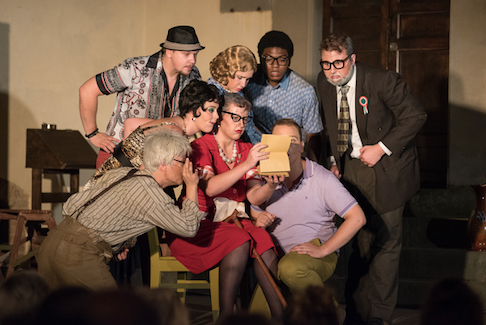 Zita reading Buoso's will to his relatives
Zita reading Buoso's will to his relatives
To a man these were charming, talented young artists, vocally and dramatically coached in their roles by operatic professionals and meticulously rehearsed in Gianni Schicchi’s formidable ensembles, preparations that made this Gianni Schicchi into opera theater of solid effect.
Lyrically Gianni Schicchi belongs to the young lovers, Rinuccio and Lauretta, who were far closer to Puccini’s prescribed 21 and 18 year-olds than the usual big house lovers. It was a huge pleasure to watch Ethan Burck and Giuliana Bossa as they negotiated Puccini’s lovely lines with concentrated vocal thinking, finding themselves at last in a high window overlooking the courtyard of the Palazzo dei Priori (where we were seated) singing their contentment.
Scenic design credit goes mostly to the long ago architect of this 14th century palazzo who provided a big entry door through which the dying Buoso (prop master Luke D’Alessandro was himself this prop!) emerged onto the door’s porch (now a stage), led by Rinuccio to the bed where he expired to be stuffed (except for an arm) later into the armoire on another wall. Long ago someone had planted a tree to shade the porch into which old (well, maybe 20), furious Aunt Zita climbed, a perch from which she hurled dead Buoso’s pill bottles at Schicchi, and behind which pregnant Nella had a bit of morning sickness.
You get the idea — all of Buoso’s relatives were characters who did their natural thing without forcing comedy. And particularly Schicchi who tore up the stage in his “Si corre dal notaio,” playing to the hilt the smarts of a maximally personable auto mechanic like a hard sell vaudeville artist — Aunt Zita threw her cane at him which he then used to execute Puccini’s strutting and twirling.
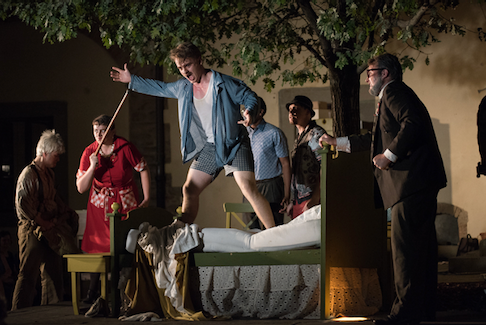 Betto, Zita, Schicchi, Rinuccio, Gherardo, Simone
Betto, Zita, Schicchi, Rinuccio, Gherardo, Simone
Not to mention Betto enacted by Korean American Simon Nam who shuffled and shook a spoon to Puccini’s pentatonic Butterfly quotations, and Zita, Nella and La Ciesca who did their best, with Puccini’s help (“Spogliati, bambolino”), to seduce Schicchi, casting suspicion on who might be the actual father of Nella’s expected child.
Conductor Class kept his tempi deliberate, and director Milenski effected highly theatrical stage pictures that camouflaged strategic sight-lines to the conductor, thus the well-known treacheries of the three formidable ensembles were painstakingly overcome — a feat that provided enormous satisfaction not to say relief to all involved — singers and spectators!
Finally Schicchi gave the spoken encomio (what better use for Buoso’s money than to seed the lives of the triumphant young lovers) in perfect Italian, an additional reward to us all thanks to the splendid efforts of Oberlin in Italy.
Michael Milenski
Cast and production information:
Gianni Schicchi: Michael Butler; Rinuccio: Ethan Burck; Lauretta: Giuliana Bossa; Zita: Helena Crothers; Nella: Madison Williams; La Ciesca: Emma Webster; Simone: Thomas Petrushka; Betto: Simon Nam; Gherardo: Matteo Adams; Gherardino: Jenna Venturi; Marco: Lukasz Zienturski; Doctor / Notary: Robert Raso; A cobbler: Seth Tack; A dyer: Alex Smith. Orchestra: L'Orchestra AgrimusArte. Conductor: Kevin Glass; Stage Director: Isabel Milenski; Stage Design: Elizabet Puksto; Costume Design: Clara Fath; Lighting Design: Christian Londos. Cortile del Palazzo dei Priori, July 27, 2018.
image=http://www.operatoday.com/Schicchi_Oberlin1.png
product=yes
product_title=Gianni Schicchi by Oberlin in Italy
product_by=A review by Michael Milenski
product_id=Above: Rinuccio and Lauetta [All photos by Erica Andreini, courtesy of Oberlin in Italy]
August 7, 2018
Sarah Connolly and Joseph Middleton journey through the night at Cadogan Hall
We started in daylight though, with Charles Villiers Stanford’s ‘A soft day’. Middleton conveyed the folky wistfulness of the gentle first-inversion harmonies though Connolly took time to settle, and she seemed a little nervous in the opening phrases. This was her Proms debut recital and perhaps she had still to get the ‘feel’ of the acoustic and balance in a capacity Cadogan Hall. But, there was characteristic openness and warmth in the lower range - the falling minor sixth in the first phrase which conveys the poet’s thankfulness was fully of sincerity - and lustre as her voice rose, as well as attentiveness to the text: the free elongation of the ‘rain’ in the first statement of the refrain which closes both stanzas created lovely suspense before the gentle patter, ‘drip’, ‘drip’, fell lightly. The anonymous poet’s direct appeal to ‘Look how the snowy mountains/Heaven’s sun doth gently waste!’, in Parry’s ‘Weep you no more, sad fountains’, was similarly vibrant, and the twos-against-threes in Middleton’s accompaniment lilted lazily and beguilingly.
The piano introduction to Vaughan Williams’ ‘Love-Sight’ was similarly tender while the subsequent oscillations generated urgency and movement, and Middleton effected a persuasive change of mood at the volta of Dante Gabriel Rossetti’s sonnet. Again, Connolly seemed somewhat uncomfortable in her middle range, and the intonation was at times unfocused, but she did use the rising phrases to create dramatic intensity. The anxious questions posed by Robert Bridges in the final stanza of Ivor Gurney’s ‘Thou didst delight my eyes’ were, similarly, effectively heightened. Connolly seemed to get fully into her stride with Sir Arthur Somervell’s ‘Into my heart an air that kills’, a setting from Housman’s A Shropshire Lad, the opening declamatory line of which was beautifully soft and well-centred. The memories triggered by the pastoral vista brought warmth, but also a poignancy which was deepened by Middleton’s sensitive expression in the piano postlude.
Frank Bridge’s ‘Come to me in my dreams’ was an early highlight in the recital, the vocal lines extending languidly accompanied by freely unfolding, bluesy piano harmonies. Matthew Arnold’s ardent appeal to his beloved to salve his uncertainties with a kiss upon his sleeping brow and say, ‘My love! why suff’rest thou?’, drooped down a seventh, heavy with rich emotion, but if here the hopeless longings of the day were becalmed, in the composer’s ‘Journey’s End’ Connolly distinguished effectively between the anxious questions and fears of the young boy and the troubling, regretted knowledge of his father who knows all too well what is to be found when the journey of life’s ‘done’. Herbert Howell’s ‘Goddess of Night’ was more consoling, the slowly rolling, dark-hued piano chords suggesting a peace that ran deep, and Gustav Holst’s ‘Journey’s End’ offered a less immediately anxious interpretation of Humbert Wolfe’s poem, as Connolly slipped with smooth lyricism through the scalic lines, with restrained vibrato but deep expression.
In the five songs of Britten’s Charm of Lullabies the mezzo soprano showed a real feeling for the composer’s approach to text-setting, and his wry, sometimes caustic, humour. In ‘A Cradle Song’ Connolly moved evenly across registers above Middleton’s asymmetrical ‘rocking’, the bass ostinato of which straddled some bitter, dry intervals as the right hand circled restlessly before trickling upwards and into silence. The quirky skips and swing of ‘The Highland Balou’ were similarly anchored to insistent piano bass notes, and Connolly relished the idiosyncrasies of Robert Burns’ dialect, which she highlighted with flashes of vocal brightness. ‘Sephestia’s Lullaby’ was impressively off score, and Connolly confidently and clearly enunciated the rapid ‘nursery lines’ - ‘Mother’s wag, pretty boy/ Father’s sorrow, father’s joy’ - which separate three statements of the more reflective refrain, ‘Weep not, my wanton, smile upon my knee.’ The chromatic keenness of the latter was secure and pointed. The irony of Thomas Randolph’s ‘A Charm’, which Britten evokes in the piano’s bubbling, stabbing gestures and the singer’s extravagant commands, ‘Quiet! Sleep!’, which threaten - one imagines, futilely - the infant with hellish Furies that shall ‘lash thee to eternity’ if he does not succumb to sleep. Fortunately, the final unaccompanied stanza of ‘The Nurse’s Song’ was more peace-inducingly restful, and this song allowed us to enjoy the rich colours of Connolly’s mezzo as it crooned its increasingly more impassioned lullaby against the, at times, quasi exotic gestures and dissonances in the piano accompaniment.
Cradle of Lullabies was preceded by two songs which were originally destined for inclusion in the cycle, but which Britten later chose to exclude. He scored them through with a single pencil line suggesting omission but not complete rejection - as Connolly discovered when she examined the manuscript in the Britten-Pears Library. Now prepared for publication Colin Matthews, the songs received their premiere here at Cadogan Hall.
The piano’s easeful accompaniment of swinging arpeggios in ‘A Sweet Lullaby’, which sets selected verses of a poem printed by Nicholas Breton in an anthology of 1597, is deceptively soothing, though there are some intervallic piquancies, for the sentiments of the raw, expressive text - expressively shaped by Connolly, and conveying the poet-speaker’s pained concern and care for the child, as the melodic sank low - are melancholy: ‘Come, little babe, come, silly soul,/ Thy father’s shame, thy mother’s grief.’ The text of ‘Somnus, the humble god’, by the seventeenth-century poet, John Denham, employs some delightful triple rhymes and Britten captures the energy that this scheme creates in the wide distances between the forward-rolling low piano left hand and the high flourishes in the right, and in the voice’s fervent, insistent appeals which climax with the realisation that ‘Sleep, that is thy best repast,/ Yet of death it bears the taste,/ And both are the same thing at last.’ The piano’s final tierce de Picardie went some way to releasing the tension of the preceding troubled images.
And so, we arrived at the final pair of premieres. Lisa Illean’s ‘Sleeplessness … Sails’ is one of this year’s BBC commissions from women composers. Illean sets an untitled poem by Osip Mandelstam, in which the narrator, unable to sleep, reads an episode of the Iliad and finds his ‘suspended state of insomnia is lithely mingled with the image of a fleet of ships suspended mid-voyage, resembling a crane in flight. The Australian composer certainly creates a dream mood, in which fantasy is evoked by expansive registral contrasts in the piano, and the improvisatory quality of the accompaniments trickling lines, as well as by the slow presentation of the text by the voice. There is a strong sense of anticipatory stasis and if at times the vocal line seemed to drift and lack direction, that was probably the point, and the extended phrases were certainly precisely crafted by Connolly. The descent of the vocal line in the final stanza resonated with feeling - ‘And the sea, and Homer - all is moved by love.’, as the sea trembled and churned with increasing tempestuousness and vigour.
Connolly and Middleton bid us ‘Farewell’ courtesy of Mark-Anthony Turnage’s 2016 setting of Stevie Smith’s poignantly understated ‘Farewell dear friends’, the direct simplicity of which was emphasised by Connolly’s clear-voiced high vocal line and the sparseness of the piano accompaniment. Turnage’s instinctive responsiveness to the rhythms of the language was, as always, noteworthy, in the particular shaping of words and phrases, but also in the overall pacing of the song. The final verse was delivered with powerful directness and honesty by Connolly: ‘Sing ding dong farewell/ As a sweet bell.’
Claire Seymour
Dame Sarah Connolly (mezzo-soprano), Joseph Middleton (piano)
Stanford - ‘A Soft Day’ from A Sheaf of Songs from Leinster Op.140, Parry - ‘Weep you no more, sad fountains’ fromEnglish Lyrics Set 4, Vaughan Williams - ‘Love-Sight’ from The House of Life, Gurney - ‘Thou didst delight my eyes’, Somervell - ‘Into my heart an air that kills’ from A Shropshire Lad, Bridge - ‘Come to me in my dreams’, ‘Journey’s End’, Howells - ‘Goddess of Night’, Britten - ‘A Sweet Lullaby’ (world premiere), ‘Somnus’ (world premiere), Holst - ‘Journey’s End’, Britten - A Charm of Lullabies, Lisa Illean - ‘Sleeplessness ... Sails’ (BBC commission: world premiere), Mark-Anthony Turnage - ‘Farewell (world premiere).
Proms Chamber Music 4 at Cadogan Hall; Monday 6th August 2018.
image=http://www.operatoday.com/Sarah-Connolly-High-Res-Credit-Jan-Capinski-Web-2017.jpg image_description=Dame Sarah Connolly (mezzo soprano) and Joseph Middleton (piano): Proms Chamber Music 4, at Cadogan Hall product=yes product_title=Dame Sarah Connolly (mezzo soprano) and Joseph Middleton (piano): Proms Chamber Music 4, at Cadogan Hall product_by=A review by Claire Seymour product_id=Above: Sarah ConnollyPhoto credit: Jan Capinski
Vanessa: Keith Warner's Glyndebourne production exposes truths and tragedies
It’s taken sixty years for Vanessa to receive a fully staged performance in the UK, though the opera was presented with reduced forces at the Royal Northern College of Music in 2011 and the Lyric Hammersmith in 1999, as well as in concert performance at the Barbican in 2003. Recently, Vanessa has been a more regular visitor to the world’s opera houses, notably at Santa Fe Santa Fe and Wexford (both in 2016). Warner’s Glyndebourne production communicates a strikingly compelling commitment to and belief in the opera, offering considerable compensation for the long delay. The opera is replete with ghosts and gaps which seem designed to deny us full understanding. Ambiguity and inscrutability can possess their own power, but Warner seeks to illuminate the hidden and the unclear, to bring the secrets into the half-light, constructing a historical and psychological narrative while retaining the opera’s elusiveness, and the result is dramatically persuasive and powerful.
During the troubled, agonised strains of the orchestral introduction, Emma Bell’s Vanessa stands centre-stage, in obvious distress, the flaming intensity of the score communicating Vanessa’s psychological fragmentation and anguish. Through a glass window, a woman is glimpsed, giving birth. Vanessa’s first words are, “No I cannot understand why he has not arrived yet.” She is speaking of Anatol, her long-lost lover, whose return she anticipates with restless excitement. The handsome man who actually arrives is Anatol’s son, who shares his late father’s name. Is this ‘imposter’ Vanessa’s son? Is that why the aged Baroness refuses to speak to her daughter? Given that Vanessa, after her initial dismay, accepts the younger Anatol as a substitute for her former love, Warner’s insinuation ties the knots which bind past and present even more tightly, and tragically. And, perhaps it is telling, as Warner suggested in a recent interview, that the book which Vanessa snatches from Erika whom she accuses of lack of passion, “You do not know how to read. You have never known what love is”, is a copy of Oedipus.
Past and present are brilliantly fused by Ashley Martin-Davis’s designs and Mark Jonathan’s lighting. Gian Carlo Menotti drew one of the central symbols of the libretto from one of Isak Dinesen’s Seven Gothic Tales, ‘The Roads Round Pisa’, in which the narrator explains, “When I was a student my friends used to laugh at me because I was in the habit of looking at myself in the looking glasses, and had my own rooms decorated with mirrors. They attributed this to personal vanity. But it was not really so. I looked into the glasses to see what I was like. A glass tells you the truth about yourself.” The mirrors in Vanessa’s mansion have been shrouded for twenty years, stopping the clock and thereby avoiding confrontation with the illusion-shattering effects of time. As she tells Anatol, “I have scarcely breathed so that life should not leave its trace and that nothing might change in me that you loved.”
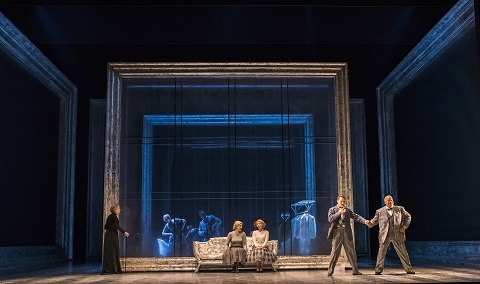 Photo credit: Tristram Kenton.
Photo credit: Tristram Kenton.
Warner and Martin-Davis uncover the mirrors: huge flickering repositories framed in antique silver which line the stage and are swivelled, with sleight of hand, across it. The glass is hazily transparent and reflectively silvered. As Jonathan flecks the monochrome palette, dramatized by chiaroscuro, with sepia and blue tints, reflections of the opera’s characters merge with ghosts of the past glimpsed through the deceiving glassy surfaces, in a surreal dance of time which conjures unsettling and unanswerable questions about history and identity. There’s an immersive, cinematic fluidity to the movement on stage (Movement Director, Michael Barry), and it’s intensified further by the use of cinematic projections (Projection Designer, Alex Uragallo) - soft-focused portraits, gothic forests - which draw us into other times and worlds. And, the film noir visual style is complemented by the expressionist qualities of Vanessa’s most impassioned vocal hysteria and Warner’s judicious use of stylised gesture.
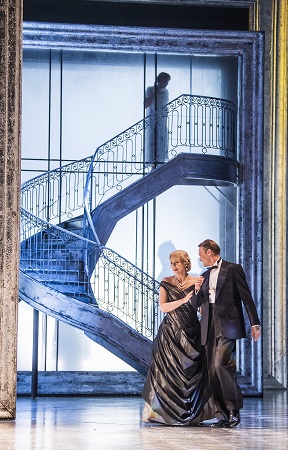 Vanessa (Emma Bell) and Anatol (Edgaras Montvidas). Photo credit: Tristram Kenton.
Vanessa (Emma Bell) and Anatol (Edgaras Montvidas). Photo credit: Tristram Kenton.
Warner has, too, an excellent eye for a telling detail that can make its mark with understated pertinence. As Donnie Ray Albert’s warm-voiced and big-hearted Old Doctor sits alone on a chaise longue, sadly reflecting on Vanessa and Anatol’s imminent departure to Paris and on the loss of Erika’s child, he fingers his silver pocket-watch, “Vanessa was once a child too”, before slipping it into the travelling trunk beside him. Vanessa has sought to run from time, to fiercely grip the past, but it cannot be evaded. Indeed, Anatol, in a characteristically theatrical plea, urges her to leave the house and follow him into the future: “Love has a bitter core. Let your love be new as were we born today.” The Doctor’s gesture serves to make Vanessa’s wedding gift to Anatol even more poignant. Initially Anatol refuses to remove the present from the marquetry box which houses it, and the gift remains unidentified until the closing scenes when a servant appears, bearing a valise, from which Anatol removes the box and then, slowly, the gift, placing a gleaming gold watch on his left wrist.
The Old Doctor can appear a Chekhovian figure of fun - a family friend who has a warm heart who is gently ridiculed for his buffoonery. And, Donnie Ray Albert’s drunken yearnings for the fulfilment of his poetic leanings do offer a welcome respite from the relentless anxieties; moreover, he is ably complemented by William Thomas’s flamboyant Nicholas, the Major-Domo who kneels to clutch and stroke the ball guests’ fur coats, lamenting extravagantly that this is the closest he will come to such women.
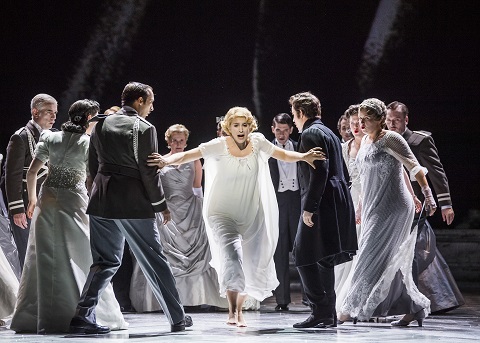 Erika (Virginie Verrez) and Glyndebourne Chorus. Photo credit: Tristram Kenton.
Erika (Virginie Verrez) and Glyndebourne Chorus. Photo credit: Tristram Kenton.
But, Warner adds layers and dimensions to the characterisation, drawing on hints in the text, and allied with Ray Albert’s sumptuously engaging bass-baritone wins our sympathy for the man who, so Warner infers, has carried out the abortion on Erika’s child. Before Erika, crazed by her pregnancy and the announcement of the marriage to be, dashes into the cold darkness and is engulfed by the cinematic forest, the Doctor is seen at the side of the stage; is he beckoning her? As she staggers recklessly onwards, the filmic focus sharpens then retreats, unsettlingly; her destination seems to be a small hut in the heart of the wood, but before she can enter, the closing mirrors have shut out the chink of light and the vision vanishes. Personal pain and regret are thus redolent in the Doctor’s reflection that though he has delivered many children, the lost ones can never be replaced.
One might accuse Warner of filling in too many of the opera’s silences which are integral to the ‘meaning’, and there are occasional visual commentaries which might be thought to go a step too far towards elucidation. But, in fact, in the early versions of the opera, Erika’s decision to abort Anatol’s child was both less ambiguous and more prominent in the score. In ‘His Child … Must Not Be Born: Revising Erika in Samuel Barber’s Vanessa’ [1] , Stephanie Poxon scrutinises the sketches and versions of the piano and vocal scores, the composer’s holograph manuscript, and the 1964 revised score, and shows how what was an emphatic statement in the creators’ original plans was gradually diminished in specificity and dramatic impact, as Erika’s attempt to force a miscarriage by running into the snow was altered to attempted suicide, and ‘His child must not be born’ was modified, first to ‘shall not’, and finally to simply ‘His child …’. Similarly, the extended, melodically wide-ranging, syncopated chromaticism of Erika’s first statement of the phrase was simplified and shortened, ‘almost spoken’.
Menotti, as a script-writer, would have been familiar with the suffocating censorship of Hays Production Code, which stringently forbade any reference to the subject of abortion in films, and although opera was outside the Code’s jurisdiction, reviews of the first performance did criticise this aspect of the opera, though taking care to avoid the word ‘abortion’. Indeed, composer Robert Evett, writing in New Republic on 27 th January 1958), restricted himself to the observation that, ‘in the course of the opera, an unmarried party gets pregnant and a lot of unpleasant things happen’. Barber scholar Barbara Heyman’s suggestion that the revisions were made to encourage more regular performances of the opera seems feasible. [2]
Warner’s centralising of these issues - Anatol’s possible parentage, Erika’s abortion - serves to clarify what previously had remained uncertain, but it also foregrounds Erika’s confused identification with Vanessa, no more so than when she tell her grandmother that the child will not be born and is met with rejection and silence of the kind Vanessa has suffered from the Baroness for twenty years.
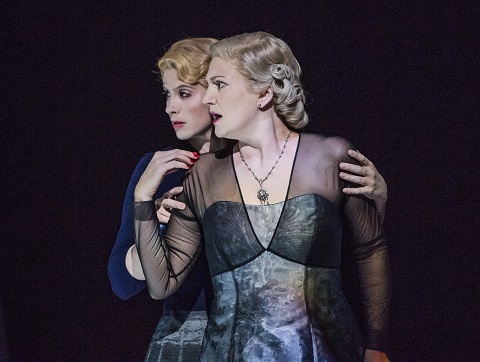 Erika (Virginie Verrez) and Vanessa (Emma Bell). Photo credit: Tristram Kenton.
Erika (Virginie Verrez) and Vanessa (Emma Bell). Photo credit: Tristram Kenton.
The cast are tremendous, and their performances make Warner’s concepts utterly persuasive. Emma Bell is a painfully fragile Vanessa who veers between elated rapture, soaring gleamingly at the peaks, and agitated restlessness. Like Tennessee Williams’ Blanche DuBois, Vanessa is feverish from the first and Bell uses the florid ornamentation and chromatic disruption of the vocal line to convey her impetuousness and her anguish. Her distress at her lack of understanding of her niece’s torment, and the gentle delivery of her avowal upon departure, “I love you Erika. I have always loved you.”, win some sympathy for Vanessa, but it is Erika whose plight is most tragic, and Virginie Verrez skilfully exploits the comparative lyrical simplicity of Erika’s melodies to allow us into the young girl’s heart and mind.
The first we see of Anatol is an iconic silhouette, leaning louchely against the mirror frame-wall and lighting a cigarette. Edgaras Montvidas’ beautiful tenor conveys every ounce of the manipulator’s charm and poise, and while Montvidas acts skilfully to ensure that we appreciate both Anatol’s essential weakness and his self-serving Machiavellianism, it’s easy to understand why both women are so immediately and comprehensively deceived and seduced. Moreover, the tenor effectively portrays Anatol’s flights into theatrical hyperbole - occasions for some of Menotti’s most fancifully self-indulgent poeticism - as in the Act 3 duet between the two lovers in which both Bell and Montvidas venture into rhapsodic unreality. Rosalind Plowright’s Old Baroness is a terrifying portrait of moral rectitude; though physically frail, the Baroness is a commanding presence, her silence both the judge and the punishment.
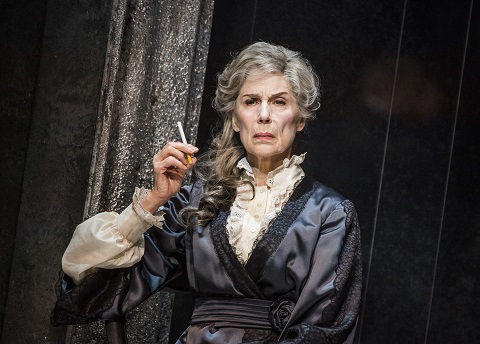 The Old Baroness (Rosalind Plowright). Photo credit: Tristram Kenton.
The Old Baroness (Rosalind Plowright). Photo credit: Tristram Kenton.
Conductor Jakub Hrůša led a searing reading of the score. The wonderfully impassioned and accomplished playing of the London Philharmonic Orchestra conveyed Barber’s unwavering intensity but Hrůša ensured that we were not overwhelmed by the music’s emotional excess, allowing for moments of lucidity amid the high-wire hysteria which increasingly dominates.
Menotti described Vanessa as a story of ‘two women ... caught in the central dilemma which faces every human being, whether to fight for one’s ideals to the point of shutting oneself off from reality, or to compromise with what life has to offer, even lying to oneself for the mere sake of living’. At the close, after all the secrets and lies, illusions and evasions, the lament for the five principals offers a choric statement of truth, expressing pathos at the futility of the characters’ delusions: “Erika, Erika, only to kiss the imposter!” Erika orders the mirrors to be masked once more, but though the grey curtains drape heavily, the reflections are not extinguished. As Verrez’s Erika makes a slow dignified progress across the stage, a figure trails her in the glass - her own reflection, or the ghost of Vanessa twenty years before? Warner seems to be suggesting that one can never erase the truths of time that reside in the soul.
Claire Seymour
Barber: Vanessa
Vanessa - Emma Bell, Erika - Virginie Verrez, Anatol - Edgaras Montvidas, The Old Baroness - Rosalind Plowright, The Old Doctor - Donnie Ray Albert, Nicholas, the Major-Domo - William Thomas, Footman - Romanas Kudriašovas; Director - Keith Warner, Conductor - Jakub Hrůša, Designer - Ashley Martin-Davis, Lighting Designer - Mark Jonathan, Movement Director - Michael Barry, Projection Designer - Alex Uragallo, London Philharmonic Orchestra, The Glyndebourne Chorus.
Glyndebourne Festival Opera; Sunday 5th August 2018.
[1]
Opera Journal
, December 2005, Vol.38(4), pp.3-32.
[2] In Samuel Barber: The Composer and his Music (OUP, 1992).
Photo credit: Tristram Kenton
August 5, 2018
Rollicking Rossini in Santa Fe
The original production directed by the late Edward Hastings with scenery designed by Robert Innes Hopkins and costumes by David C. Woolard has been well traveled (15 North American companies) since its acclaimed debut in 2002. Updated to 1920 or so, Mr. Hopkins has devised a pop-up of a set, with the large raised stage platform floor opening up to form a back wall and revealing a 3-D greeting card of a Moorish palace. Set pieces are similarly cleverly created by cast members magically unfolding them from the floor.
The visual delights were continued as Mr. Hopkins had a field day summoning up colorful “Algerian” attire that defined a political power structure with its wide variety of social stations. Elvira and Zulma were lavishly decked out in richly detailed harem dress. Only Isabella and “uncle” Taddeo were in period Italian dress, she as a sleek, independent aviatrix who crash-landed her plane (vice: arriving during a shipwreck) in an attempt to rescue her love, Lindoro from the imprisoning Bey.
Isabella’s bi-plane was an added character in the comedy, first appearing in miniature “flying” through the audience (held aloft by a stagehand on a stick) during the famous overture, disappearing behind a concessions stand, then reappearing on stage “flying” on wires in progressively larger versions, until it is clear it has struck land offstage. A life-sized model is revealed together with the title heroine during the introduction to Cruda sorte.
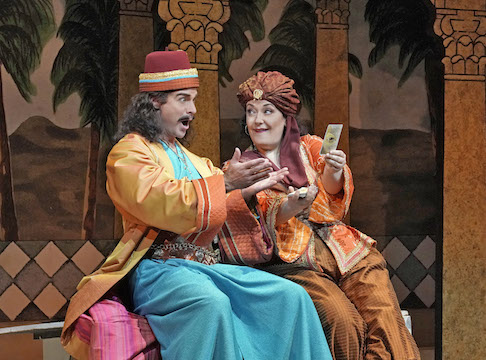 Craig Verm (Haly) and Suzanne Hendrix (Zulma)
Craig Verm (Haly) and Suzanne Hendrix (Zulma)
Daniela Mack has every bit the assured star presence needed to carry the show. From her opening aria to her last note, Ms. Mack lavished the role with virtuosic singing worthy of a grand tradition. The sparkling ease of her rapid-fire coloratura was characterized by a distinctive, glowing tone that was even from top to bottom.
If anything, the extremes of the writing liberated her to hurl fusillades of thrilling top notes, counter-balanced by persuasive, imposing chest tones. Moreover, the accomplished mezzo is a poised actress and cuts a beautiful, lanky figure as the strutting, self-assured pilot. No wonder Mustafa is attracted to her. We all are.
Jack Swanson (Lindoro) can be added to the short list of top tier Rossini tenors. His brilliant, focused lyric instrument has a captivating color, and his effortless execution of endless racing melismas was jaw dropping in its elan and artistry. Mr. Swanson is enthralling not only for his assured, stylish vocalizing but also for his amiable, boyishly handsome stage presence. He brought the house down with his first aria, capturing our hearts, and then came back for the rest of us with a wonderfully detailed interpretation. Watch this talented young man’s star rise rapidly in coming months.
Scott Conner is a refreshingly different Mustafa, his substantial, pointed bass eschewing the more usual blustery, fussing buffo take on the role. Mr. Conner has a pompous, insinuating presence and his insistent vocalizing brought great determination and depth to the character. His fleet-tongued patter was astounding in its accuracy and clarity. He was ably complemented by Patrick Carfizzi as Taddeo. Mr. Carfizzi has a substantial, mellifluous bass that shone splendidly in his Act II aria, which was a virtual feast of sonorous tone and characterful nattering. As a shameless, rubber-faced, loose-limbed comedian, Patrick also evinced some of the evening’s best laughs.
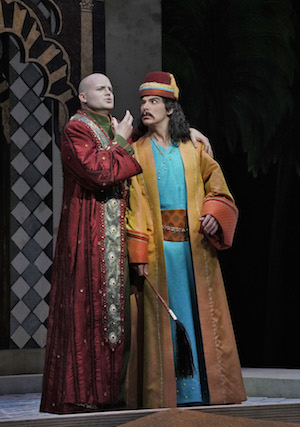 Scott Conner (Mustafa) and Craig Verm (Haly)
Scott Conner (Mustafa) and Craig Verm (Haly)
Giving him close competition, Craig Verm clearly relished his hijinks (and low jinks) as a highly excitable Haly. Mr. Verm is possessed of one of the finest, most mellifluous baritones of his generation and his pronouncements rang out with great presence in the house. His generous rendition of Haly’s aria was one of the evening’s many highlights. But he is also not afraid of coloring his fine voice in service of the comedy and his obvious enjoyment of his assignment is infectious.
Apprentice Stacey Geyer more than held her own among this stellar group, her polished, glistening soprano sailing above the staff with an easy beauty. As her confidante Zulma, Suzanne Hendricks had a wicked sense of fun, and revealed an accomplished, substantial mezzo with a luscious sheen.
Corrado Rovaris reigned supreme in the pit, leading a fizzy, propulsive, idiomatic reading that found the responsive orchestra in fine form. Maestro Rovaris found a good balance between breathless patter and sustained phrases, and ensured the all-important Rossini crescendo effects were served up with a rising tension and increasing excitement. If his gusto occasionally challenged his singers’ breakneck elocution, the effect was that it galvanized them to pick up the gauntlet, and the high energy result was exhilarating.
I did not see Mr. Hastings’ fondly remembered original production, but I can attest that Shawna Lucey has staged an endlessly varied, wildly inventive, flat out rib-tickling rendition that capitalizes on the strengths of the original concept. The comic business was character specific and well executed. I might have done without the trickery that the telegrams Mustafa was typing turned out to be anachronistic tweets. Ditto the overlord putting his name all over the buildings. And posing for a photograph with a lion he shot. And damn if I didn’t laugh at it all!
Ms. Lucey has not only done fine, illuminating work with the solos and small ensembles, but most remarkably she has peopled the stage with interesting groupings and interaction from the entire cast. Susanne Sheston’s chorus goes from strength to strength this summer, and they not only sang with rousing accuracy, but also threw themselves into the staging.
Several of the best massed numbers required great personal investment from each and every person on stage. The Act I finale espoused three times as much energy as any dance number in Mamma Mia! and with far better music. If you didn’t bop along in your seat as the entire cast uninhibitedly busted moves as they shimmied and boogaloo’d and twerked and jerked, well, you must have been at the wrong address.
In a festival where we have seen the tragedy of a geisha, the test of a nuclear bomb, a sardonic sampling of Voltaire’s cynicism, and a “dramedy” that pointedly pontificates the value of high art over entertainment, it is perhaps fateful that I ended my time in Santa Fe with a mightily classy form of amusement.
L’Italiana in Algieri sets out to entertain, albeit with first class musical values in service of a masterful score, and entertain it does. We don’t have to choose. We can simultaneously have high art “and” belly laughs.
James Sohre
Cast and production information:
Elvira: Stacey Geyer; Zulma: Suzanne Hendrix: Mustafa: Scott Conner; Haly: Carig Verm; Lindoro: Jack Swanson; Isabella: Daniela Mack; Taddeo: Patrick Carfizzi; Conductor: Corrado Rovaris; Director: Shawna Lucey; Set Design: Robert Innes Hopkins; Costume Design: David C. Woolard; Lighting Design: Duane Schuler; Chorus Master: Susanne Sheston; Original Production: Edward Hastings
image=http://www.operatoday.com/algiers01.jpeg image_description=Daniela Mack (Isabella) and Jack Swanson (Lindoro) [Photo © Ken Howard] product=yes product_title=Rollicking Rossini in Santa Fe product_by=A review by James Sohre product_id=Above: Daniela Mack (Isabella) and Jack Swanson (Lindoro)Photos © Ken Howard
Rock solid Strauss Salomé- Salzburg
Behind a gauze sceen, a madonna figure with lace veil and golden crown materializes, laying down her veil. Dark figures appear, crushing the veil and crown underfoot. Princess Salomé (a sensational Asmik Grigorian) enters. "Wie schön ist die Prinzessin Salome heute Nacht!" sings Narraboth (Julien Prégardien, vocally recognizable even beneath the makeup), his lines repeating in different patterns. Dark swelling chords surge from the orchestra, Salomé puts on the veil and crown. Like the Madonna she's worshipped (by Narraboth) but later treated as a whore (by Herodes - John Daszak). Horns and trombones call from the pit, heralding the voice of Jochanaan (Gábor Bretz).
This staging (by Romeo Castellucci) manages to depict the multiple levels in the opera as a coherent whole. Instead of depicting the dungeon as an underground cavern, it uses the simple device of a black hole projected onto the stage, from which Jochanaan emerges, first garbed as a mythic beast hardly visible against the blackness behind him. The hole is nearly always present, breaking into the marble and mirror glass neatness of the palace. Later it will serve as a technical device disguising quick scene changes. This is perceptive since the opera itself deals with the way Jochanaan's presence unsettles Salomé, and the way the subconcious intrudes into consciousness. Bretz holds aloft a circular object, like an opaque mirror.
Mirror images abound. Salomé speaks at Jochanaan with images of beauty proliferating in nearly every line, swiftly changing and moving, Grigorian singing with good rhythmic deliberation, almost as though she was already singing the dance of veils. As Salomé moves in on Jochanaan to kiss him, the orchestra wails in horror. "Du bist verflucht." sings Bretz, with malevolent force "Du bist verflucht, Salomé!" Welser-Möst brings out the strident dissonace, brasses blaring and exhaling - not unlike over-excited human screams. Then Grigorian dances, slowly, in time to the music, her legs exposed. It's explicitly erotic, though chaste. Tubas and baleful bassoons announce the entry of Herodes and Herodias (Anna Maria Chiuri) and their retinue, stepping over Narraboth’s corpse, unperturbed. More characters at cross-purposes. "Hört ihr es nicht?" "Ich höre nichts" Clarity in the singing makes the exchanges bristle with tension. This was particularly effective in the interaction between Herodes and the Jews and Nazarenes. They too are "dancing" games of non-communication. When the voice of Jochanaan blasts through again, Bretz cuts through, firm and direct.
A monolith marked "Saxa" is shifted, revealing Grigorian, now in a silk shift, looking vulnerable. But something has changed in her. Her lines are now fierce, almost monotone, rising to maniacal savagery. Now she's seen in a circle, surounded by white liquid. No whitewash, not milk so much as the symbolism of the moon of which she sang before she encountered Jochannan "Ja, wie die Schönheit einer Jungfrau, die rein geblieben ist." Herodes grows more insistent, and the red paint, covering Daszak’s face like a mask, melts away, staining his clean white shirt. "Ich will den Kopf des Jochanaan" sings Grigorian, her vouce rising to wild crescendo. Still, Herodes prevaricates, his lines disintegrated into horrified fragments. Welser-Möst hold nothing back, defining the turbulence with its sharp brass alarums and thunderclaps of percussion. Grigorian alternates between ferocity and tenderness, searching lines reaching out, then receding into regret. A tour de force performance, made even more moving by the sensitive filming which picks up the emotion in her expressive face. The dancing here is in the voice part and the music swirling around it: Grigorian embraces the headless corpse of the prophet, seated like a Babylonian statue, carved in stone. "Ich habe ihn geküsst, deinen Mund", she sings against a luminous orchestral background which rises to strange, unsettling valediction. And so Salomé dies, her head poking from a hole in the ground, as if on a silver platter.
This is a production of surreal, esoteric beauty, so full of subtle detail that it will, in time, reveal even more depths. Kudos to the dramaturge Piersandra Di Matteo. But it also reveals extremely high levels of musicianship, both in the singing and orchestral playing. Since it is co-sponsored by ORF, 3sat and UNITEL in co-operation with Wiener Philharmoniker and the Salzburg Festival, no doubt a DVD will be forthcoming. In which case grab it.
Anne Ozorio
image=
image_description=
product=yes
product_title=Richard Strauss - Salomé - Franz Welser-Möst (conductor), Julian Prégardien, Asmik Grigorian, Gábor Bretz, John Daszak, Anna Maria Chiuri, Romeo Castellucci (director) live broadcast from the Salzburg Festival, 28th July 2018
product_by=A review by Anne Ozorio
product_id=
August 4, 2018
Prom 26: Dido and Cleopatra – Queens of Fascination
It made for a splendid late-night concert, a fine mix of repertoire familiar and (to me, at any rate) unfamiliar, any minor reservations I may have entertained relating entirely to the orchestra and conductor. Prohaska, if I may be forgiven for saying so, crowned herself queen of this repertoire, notwithstanding the frankly unpromising surroundings of the Royal Albert Hall.
We began, as indeed we should end, with Purcell, with Dido and Aeneas: one of the very greatest of English operas and indeed of ‘Baroque’ operas, if that problematical term may be held to mean anything at all. ‘Tristan und Isolde in a pint pot,’ that legendary conductor of what was then not quite ‘early musicke’, Raymond Leppard, called it. There was no question from the Overture that Antonini was more at home with these, ‘his’ musicians than he had been with members of the LSO Chamber Orchestra in a concert last year at the Barbican. For one thing, the acoustic was kind to the instruments, lessening intonational problems, which were in any case rarely grave. Resplendent, regal in gold, our soprano walked onto the stage as the Overture drew to a close, ready to give a rich-toned, clear, beautifully ornamented account of Dido’s first number. Here, as elsewhere, what struck me about her ornamentation, aside from the awe-inspiring ease with which it and any other coloratura were despatched, was how it did not really register as ‘ornamentation’. It was musical and indeed verbal expression, created seemingly on the spot. (Whether that were actually the case is neither here nor there.) Her lightly acted performance also proved just the ticket. In homage perhaps to Goldilocks, another queen of sorts, it was neither too much nor too little.
Christoph Graupner’s Singspiel for Hamburg, Dido, Königin von Carthago (1707), was quite new to me. It is one of those curious – to our ears, yet not necessarily to those of the time – works written in German and Italian, standard Italian arias doing their thing whilst the action was largely advanced in the vernacular. I should certainly be keen to learn more. The Egyptian princess Menalippe’s ‘Holdestes Lispeln der spielenden Fluthen’ proved vividly pictorial. One could almost see – one could certainly hear – those rippling waters through ravishing instrumental playing. This may be too early and the wrong country too, but Poussin more than once came to my mind. When later Prohaska turned to the Queen of Carthage herself, we heard first a German accompagnato (‘Der Himmel ist von Donner Keylen schwer…’) followed by its Italian aria, ‘Infido Cupido’. This was very much music written and communicated in the terms of early eighteenth-century opera seria. Hearing it in this particular context, we understood both its roots in earlier opera and much of what distinguished it from its predecessors too. Prohaska’s stylistic awareness is never a sterile thing, ‘dogma’ in the slightly misleading popular understanding of the term; it is and here was always put to expressive, dramatic use. Much the same might be said of her performance of the tempest aria that ensued: of a genre yet not over-determined by it.
In between the Graupner excerpts, we heard music by Antonio Sartorio and Matthew Locke. The former’s Giulio Cesare in Egitto contains, according to the programme note, no fewer than sixty-five arias. Prohaska gave us two, ‘Non voglio amar’ and ‘Quando voglio’, the first furious – with foot-stamping – and, that inescapable word, tempestuous. I could not help but wonder whether the musicians might have been better off without a conductor in the first; Antonini looked a little awkward and the results might have been a little freer. No harm was done, though, and his provision of a recorder obbligato in the latter aria offered winning counterpoint to the woman of desires revealed by our queen of song. The Locke excerpt offered an ineffably ‘English’ contrast, much of it mysteriously veiled, harking back to the days – still current, of course, yet somewhat old-fashioned – of the viol consort.
Handel was next on the menu. Antonini’s way with the Concerto grosso, op.6 no.8, made me long for something a little grander, a little more aware of harmonic motion. This is, after all, orchestral music. Tastes being what they are today, that was never likely to be the case, though. I liked the way the Siciliana, its fifth movement, harked back in context to the seventeenth century. A hard-driven account of its Allegro successor proved less welcome. Handel’s own Giulio Cesare followed, its libretto derived by Nicola Francesco Haym from that of Giacomo Bussani for Sartorio. What a wonderful idea – obvious, one might think, yet unusual – it was to offer excerpts from both operas. In Cleopatra’s ‘Che sento? Oh dio! … Se pietà di me non senti’, Prohaska’s shading to dramatic ends opened up a new creative, expressive world. I felt – and I suspect much of the audience did likewise – a window into understanding of the queen’s character had been opened wide, even just by this account of a single aria. More please!
Dario Castello’s D minor Sonata, published in 1629, performed its bridging role well. It is perhaps not especially thrilling music, but it has its moments of interest; it also benefited, I think, from being given as chamber music, without a conductor. Moving forward a few years, yet remaining in Venice, we heard from Cavalli’s Dido, Prohaska adopting just the right – to my ears, at least – slightly post-Monteverdian air. (Yes, the great man was still alive in 1641, but that is hardly the point.) I can hardly offer greater praise than to say that her singing brought Frederica von Stade to mind, both in command of line and in its generosity of spirit. Hasse’s aria, from his Marc’Antonio e Cleopatra, sounded very much again from the world of later opera seria. Prohaska’s coloratura probably deserves another endorsement here: impeccable, both ‘musically’ and ‘dramatically’, not that the distinction is especially meaningful.
And so, we returned to Purcell. The Chaconne from The Fairy Queen had me long for Britten’s more generous way with such music, yet unquestionably it danced. A vivid narration from Dido and Aeneas, the Second Woman’s ‘Oft she visits this lone mountain’, was imbued with quite the sense of drama, given brevity and (relative) lack of context. Dido’s Lament was sung with expressive freedom that never approached licence, a reminder of Leppard’s Tristan designation, dignified without a hint of sentimentality. As an encore, we heard ‘Fear no danger to ensue’, the duet part taken by Antonini on recorder. A lovely concert, then, but in the best sense an educative one too. Bildung, one might say, is an excellent thing indeed.
Mark Berry
Cast and production information:
Henry Purcell: Dido and Aeneas: Overture and ‘Ah! Belinda, I am pressed with torment’; Christoph Graupner: Dido, Königin von Carthago: ‘Holdestes Lispeln der spielenden Fluthen’’; Antonio Sartorio: Giulio Cesare in Egitto: ‘Non voglio amar’; Matthew Locke: The Tempest: ‘The Second Musick: Curtain Tune’; Sartorio: Giulio Cesare: ‘Quando voglio’; Graupner: Dido: ‘Der Himmel ist von Donner … Infido Cupido’, ‘Agitato da tempeste’; George Frideric Handel: Concerto grosso in C minor, op.6 no.8; Handel: Giulio Cesare in egitto: ‘Che sento? Oh dio! … Se pietà di me non senti’; Dario Costello: Sonata no.15 in D minor; Cavalli: Didone: ‘Re de’ Getuli altero … Il mio marito’; Hasse: Marc’Antonio e Cleopatra: ‘Morte col fiero aspetto’; Purcell: The Fairy Queen: ‘Chaconne – Dance for Chinese Man and Woman’; Purcell: Dido and Aeneas: ‘Oft she visits this lone mountain’, ‘Thy hand, Belinda … When I am laid in earth’. Anna Prohaska (soprano)/Il Giardino Armonico/Giovanni Antonini (conductor). Royal Albert Hall, London, Thursday 2 August 2018.
image=http://www.operatoday.com/Anna%20Prohaska%20Portrait%202.png image_description=Anna Prohaska [Photo © Harald Hoffmann] product=yes product_title=Prom 26: Dido and Cleopatra – Queens of Fascination product_by=A review by Mark Berry product_id=Above: Anna Prohaska [Photo © Harald Hoffmann]Parsifal: Munich Opera Festival
With a cast of dreams, an orchestra of distinction conducted by Kirill Petrenko, not to mention a world-class opera chorus, what could be not to like? Nothing for much of the audience, it would seem. Alas, for me it proved a grave disappointment, for which the responsibility must either lie with me, Audi, or both of us.
I am not sure I have ever seen a production of Parsifal so lacking in - well, anything. Goodness knows one can argue about what this work is about, what its problems might be, what its extraordinary virtues might be, even what it might be made to be about, and so on and forth. Goodness knows directors can come up with execrable concepts or execute their concepts, good or bad, less than well. I speak from the bitter experience of having attended a good few, not least the present Uwe Eric Laufenberg farrago at Bayreuth , which somehow manages both to be intensely offensive in its Islamophobia and unbearably boring.
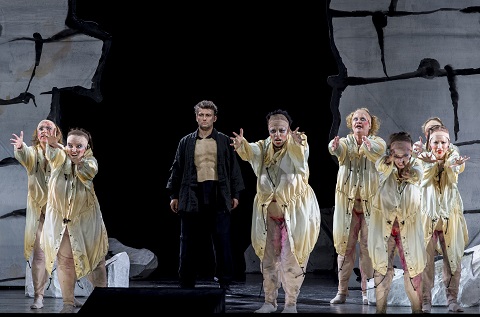 Jonas Kaufmann (Parsifal) and the Grail Knights. Photo credit: Ruth Walz.
Jonas Kaufmann (Parsifal) and the Grail Knights. Photo credit: Ruth Walz.
Audi, however, seems to have no discernible thoughts about it whatsoever. I almost have nothing beyond that to say, so shall keep the rest of this very short. Its selling point - to some, anyway - seems always to have been designs by the strangely overrated visual artist, Georg Baselitz. They struck me as very much in keeping with what else I have seen from Baselitz; if you like to look at this sort of thing, this is the sort of thing you would have liked to look at. The first act, all of it, is set in a forest. For some reason, the knights take off their outer clothes to reveal unflattering fattish naked suits, which suggest a degree of androgyny, although that suggestion seems later - by the Flowermaidens - to be refuted. The second act is barely staged at all, yet without any of the virtues of a concert performance. The third act returns to the forest. The end. To think that this succeeded a production by Peter Konwitschny beggars belief.
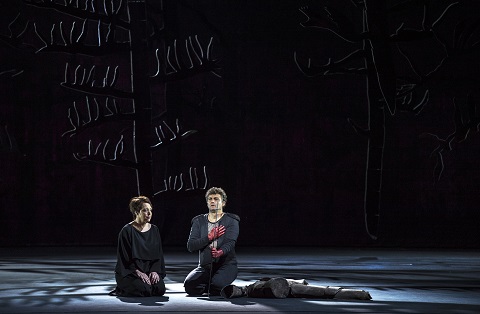 Nina Stemme (Kundry) and Jonas Kaufmann (Parsifal). Photo credit: Ruth Walz.
Nina Stemme (Kundry) and Jonas Kaufmann (Parsifal). Photo credit: Ruth Walz.
Yet so oppressive are the designs, for that is really all the production can be, so different is the experience from a concert performance, that much very good - although not, I think, quite so good as many seem to have thought - musical work went largely to waste. Petrenko’s conducting was excellent, although it never seemed to me to dig so deep as, say, the work of a Barenboim or indeed, in days not so very distant, a Haitink . Still, there could be no real complaints either with Petrenko or his orchestra. His tempi in the first act, at least earlier on, felt relatively swift; I have no idea whether they actually were. Yet they never felt rushed; his was a fleet, at least slightly Boulezian conception, until it was not. For there was plenty of space, well taken, to manage the work’s ebb and flow - whilst seeming, and doubtless to a certain extent, being managed by the work’s ebb and flow. Interestingly, the opening of the third act, its Prelude in particular, sounded more anguished than anything in the second. If only some of the pain implied for Parsifal’s wayfaring had been otherwise reflected in the staging. This was certainly a reading that developed and, by any standards, marked a fine debut run in the work. One oddity: I do not think I have heard such feeble Grail bells. According to the programme, however, this was a special instrument modelled by the Bayreuth piano company, Steingraeber, after the instrument used at the 1882 premiere. If so, the Meister was - not for the first time, nor even for the last - surely mistaken. The Bayreuth bells we know from, say, Karl Muck’s 1927 recording, in their 1926 design pack sound to my ears more impressive in every way. Or maybe I am just too wedded to what I think I ‘ought’ to hear.
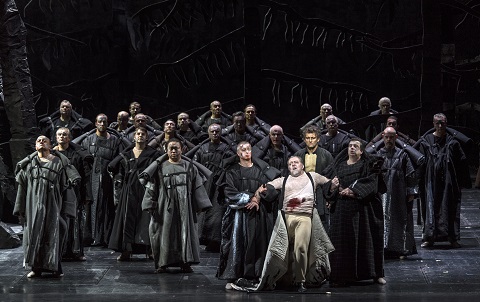 Christian Gerhaher (Amfortas). Photo credit: Ruth Walz.
Christian Gerhaher (Amfortas). Photo credit: Ruth Walz.
Singing was also distinguished, although it was really the Amfortas and, perhaps more oddly, the Klingsor who stood out for me. Christian Gerhaher has recently, surprisingly, seemed more at home in opera than in Lieder, and so it was here. His fabled beauty of tone was never an end in itself but put to sweet, agonising dramatic work - alongside the fascinating suggestion, apparent in his eyes if nowhere else on stage, of a crazed, ecstatic religious visionary. Could that not have been the director’s concept, if he had no other? It would certainly have opened up all manner of possibilities. Wolfgang Koch’s way with words, music, and their combination marked him out as an uncommonly excellent Klingsor - even if Klingsors rarely disappoint. Again, one learned much simply from observing his facial expressions. Jonas Kaufmann offered lovely moments, lovely passages, and a great deal of verbal acuity too in his assumption of the title role. However, his voice really did not sound as I recall it from not so long ago; there were times when it sounded not only strained but worn. Let us hope that this was just an off-day (a highly relative off-day). He and Nina Stemme as Kundry were certainly not helped by Audi’s non-production. I am not entirely convinced that this is Stemme’s ideal role, but it is surely not unreasonable for us to adjust our expectations according to a particular artist’s abilities and conception. Something a little wilder either on stage or in voice, or ideally both, would not have gone amiss, but again there were no grounds for true complaint. Likewise with René Pape’s Gurnemanz. His beauty of tone remains, yet there is now far more of a sense of verbal response than once there was in his singing. If Parsifal, then, is for you primarily, even exclusively, about singing and more broadly about musical performance, you would have experienced something undoubtedly special. If, however, it needs to be for you a drama too, I cannot imagine your response would have been so very different from mine.
Mark Berry
image=http://www.operatoday.com/J._Kaufmann_Blumenmaedchen_c__R._Walz.jpg image_description=Parsifal : Munich Opera Festival product=yes product_title=Parsifal : Munich Opera Festival product_by=A review by Mark Berry product_id= Above: Jonas Kaufmann (Parsifal) and the Grail KnightsPhoto credit: Ruth Walz
August 3, 2018
Santa Fe: Atomic Doesn’t Quite Ignite
Well for starters, could we please have the original production back? Or another version that manages to convey the menace and import of this disturbingly contemporary peril? The SFO team of collaborators promised much, delivered a good deal, but fell short of this important work’s shattering impact.
I am a great admirer of baritone Ryan McKinny. When he is ideally cast, I have heard him as a thrilling Dutchman or full-throated Jochanaan. The role of Dr. J. Robert Oppenheimer sadly does not play to his gifts. While Mr. McKinny was always engaged and highly musical, his handsome instrument just doesn’t have the easy, ringing top needed to succeed completely in the role. Ryan worked hard, earned my admiration, and always displayed the highest professional standards, but ultimately could not anchor the production as Oppenheimer should.
Conversely, Daniel Okulitch was in splendid, refulgent voice as General Leslie Groves, indeed I have never heard him sing better. The macho snarl in his cogent delivery made a powerful impression. Mr. Okulitch, too, was curiously miscast. The General is meant to be portly, indeed there is a lengthy, humorous “cake “ section about his having to watch his weight and diet. That makes little sense when the lean, handsome actor has made previous SFO shirtless appearances that had patrons scrambling for their binoculars.
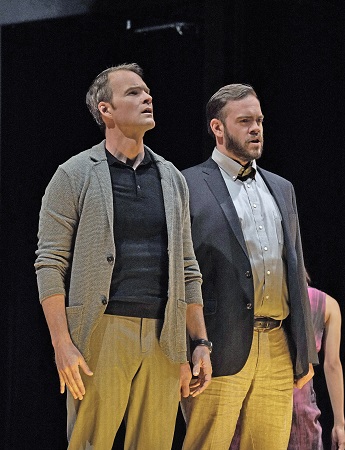 Ryan McKinny (Robert Oppenheimer) and Andrew Harris (Edward Teller). Photo credit: Ken Howard for Santa Fe Opera 2018.
Ryan McKinny (Robert Oppenheimer) and Andrew Harris (Edward Teller). Photo credit: Ken Howard for Santa Fe Opera 2018.
Andrew Harris’ characterful, measured bass was a good fit for physicist Edward Teller. Meteorologist Frank Hubbard was exceedingly well served by Tim Mix’s steady, powerful baritone. Apprentice tenor Mackenzie Gotcher performed with distinction as Army Captain James Nolan. The always reliable, sweet voiced, stylish tenor of Benjamin Bliss (Robert Wilson) on this night sounded veiled on top. I think this may be the result of the Adams-mandated miking.
It is hard to judge opera singers’ true accomplishment when a sound mixer is in between. Mssrs. Okulitch, Mix, and Harris were least impacted, while the other men sounded tinny (especially handicapping McKinny). Having seen the original twice, I was never “aware” of the amplification as I was here. There is no one in this capable cast that wouldn’t have fared better without it. Happily, the ladies were not so afflicted.
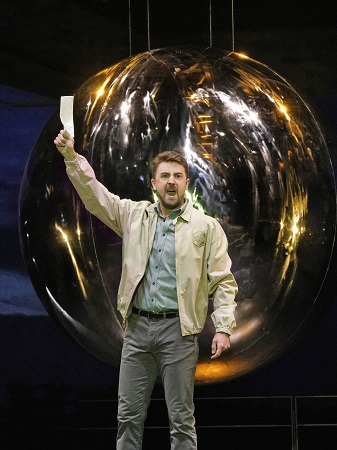 Ben Bliss (Robert Wilson). Photo credit: Ken Howard for Santa Fe Opera 2018.
Ben Bliss (Robert Wilson). Photo credit: Ken Howard for Santa Fe Opera 2018.
Julia Bullock was everything one could wish as she created a haunting, melancholy, determined Kitty Oppenheimer. Ms. Bullock’s shining, supple soprano is in complete service to creating a three-dimensional portrait of the hapless spouse. Her touching interpretation of “Am I in Your Light” was alone worth the trip. Her poignant legato phrases were matched in beauty by the urgent delivery of conversational passages. This was a triumphant role assumption by a young artist at the height of her powers and on the precipice of her stardom.
Meredith Arwady’s powerful, rich contralto always adds immeasurably to any show, and her secure reading of Pasqualita was no exception. Ms. Arwady left us wanting (much) more. The biggest star of the night might just have been the Young Apprentice opera chorus, meticulously groomed by chorus master Susanne Sheston. From the very first choral statements they served notice that they were here to make thrilling music, flawlessly articulated, and dramatically compelling. Their high caliber contribution would be welcomed at any opera house in the world.
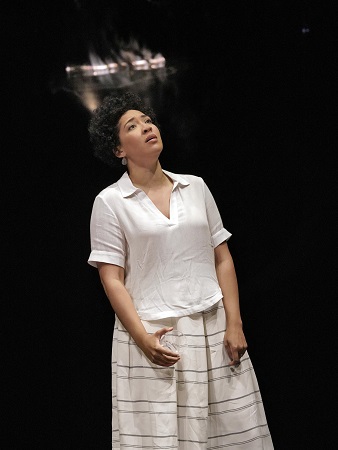 Julia Bullock (Kitty Oppenheimer). Photo credit: Ken Howard for Santa Fe Opera 2018.
Julia Bullock (Kitty Oppenheimer). Photo credit: Ken Howard for Santa Fe Opera 2018.
The overall musical effect was variable. Early on in the night, after the second or third unsteady passage occurred, I trained my eye on conductor Matthew Aucoin. His stick technique was not what I expected for a score demanding such precision, but rather consisted of a loop of bobbing and waving. The experienced instrumentalists seemed sometimes to be not so much playing together as clinging together. Maestro Aucoin has obvious enthusiasm for the piece, but I urge that it be wedded to more accuracy with the baton.
It has to be reported that throughout Act I a torrential, violent thunder and lightening storm eclipsed any drama to be found on the stage, and some string players had to retire momentarily to preserve their instruments. That did not help, but also did not cause the imprecision in the ensemble.
The storm also caused any number of unintentional (and hearty) laughs. After a particularly loud thunderclap, Oppenheimer’s next line was: “What if it’s a dud?” There is much tense discussion about the weather in the waning pages of Act I, since it will impact the test and the potential spread of radioactive fallout. The actors were thwarted in increasing the dramatic stakes by constant titters at dialogue about unfortunate weather. But truthfully, well before Mother Nature intruded, the dramatic progression was already dampened.
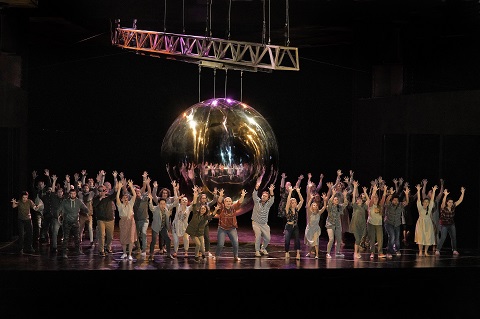 Santa Fe Chorus. Photo credit: Ken Howard for Santa Fe Opera 2018.
Santa Fe Chorus. Photo credit: Ken Howard for Santa Fe Opera 2018.
David Gropman’s well-intended set design is dominated by the omnipresent “bomb,” in the guise of a suspended silver, reflective globe (think: a really really oversized Christmas ornament). Selected industrial set pieces are added and subtracted beneath it, and the ball tracks up and back, but what you see is all you’re going to get. Since all is revealed up front, there is no impending visual impact, never any unsettling “tease” about what this thing looks like and what it does.
A plus side is that the surface takes light well, and designer James F. Ingalls has made good attempts to make it look menacing, or at least colorful. I wish Mr. Ingalls had gone further in isolating key dramatic moments, especially Oppenheimer’s anguished aria, “Batter My Heart” which inexplicably left the hero on a fully lit, un-atmospheric stage.
Gabriel Berry’s costumes were period, correct, and awfully plain in their palette. The dancers were more fancifully attired, although Emily Johnson’s choreography was a puzzle to me. I am fine with the gestures not telling a story, but shouldn’t they at least reflect the music? In a critical, troubling, angular, unsettling musical bridge, the corps remained resolutely gently undulating.
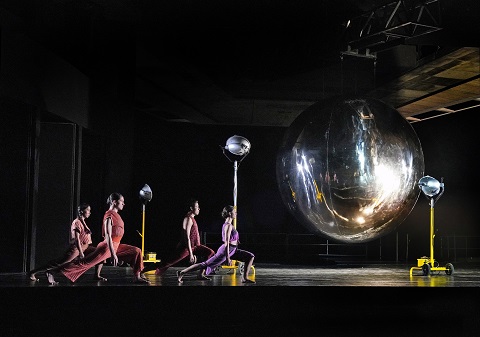 Dancers. Photo credit: Ken Howard for Santa Fe Opera 2018.
Dancers. Photo credit: Ken Howard for Santa Fe Opera 2018.
I am a fan of director Peter Sellars. He takes big risks and the result is often thrilling. But concepts that work brilliantly in one production, don’t always translate to another. The choral and solo gestures that he devised for Glyndebourne’s Theodora were illuminating and bewitching. The semaphoric gesturing in this Dr. Atomic bordered on being “Captioned for the Clinically Bewildered.” Mr. Sellars was at his best in the inter-relationships of the principals and the shifting choral formations, which almost made up for a good deal of distracting background filler of unmotivated crosses.
Whatever my reservations, I commend Santa Fe Opera for boldly scheduling such a difficult, important work this summer, for so diligently resourcing it, and for making it available for new audiences to partake of its glories.
James Sohre
John Adams: Doctor Atomic
Dr. J. Robert Oppenheimer: Ryan McKinny; Edward Teller: Andrew Harris; Robert Wilson: Benjamin Bliss; Kitty Oppenheimer: Julia Bullock; Pasqualita: Meredith Arwady; General Leslie Groves: Daniel Okulitch; Frank Hubbard: Tim Mix; Captain James Nolan: Mackenzie Gotcher; Conductor: Matthew Aucoin; Director: Peter Sellars; Set Design: David Gropman; Costume Design: Gabriel Berry; Lighting Design: James F. Ingalls; Sound Design: Mark Grey, Daniel Gower; Choreography: Emily Johnson; Chorus Master: Susanne Sheston
image=http://www.operatoday.com/Dr%20Atomic.png
image_description=Dr Atomic: Santa Fe Opera
product=yes
product_title=Dr Atomic: Santa Fe Opera
product_by=A review by James Sohre
product_id= Above: Dancers, Meredith Arwady (Pasqualita), Ben Bliss (Robert Wilson), and Tim Mix (Frank Hubbard)
Photo credit: Ken Howard for Santa Fe Opera 2018
Santa Fe: Continuing a Proud Strauss Tradition
The late Mr. Crosby founded the festival, of course, and Ariadne was included in the inaugural line-up. By the time he retired, Maestro had conducted some 567 performances, 171 of them Strauss operas. This new production is the fourth in the work’s history here, and makes a solid case for the opus. From first to last, the cast is peopled with some of the leading practitioners in the field.
Amanda Echalaz is quite a galvanizing presence as Ariadne, her dark-hued, voluminous soprano a mighty force to be reckoned with. This is an instrument of not only immense power, but also possessed of a warm elegance. Ms. Echalaz is capable of pinning you back in your seat one minute with imperious suffering, and tug at your heart the next with exceedingly persuasive pianissimi.
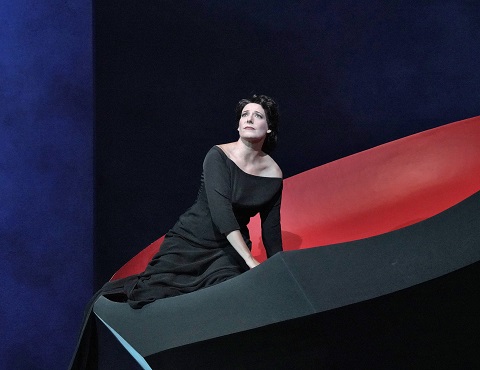 Amanda Echalaz (Prima Donna/Ariadne). Photo credit: Ken Howard for Santa Fe Opera 2018.
Amanda Echalaz (Prima Donna/Ariadne). Photo credit: Ken Howard for Santa Fe Opera 2018.
Like other notable large voices, the outpouring of rich sound can sometimes supersede the enunciation of every consonant, and an occasional unsteady soft high note betrayed her otherwise sound musical technique. Nonetheless, this was a pleasing and effective role traversal that aspired to sweep all before it.
Liv Redpath was quite an accomplished Zerbinetta, with a virtuosic command of coloratura, a decent sense of comedy, an endearing charisma, and a crystalline tone that proved a winning combination. The slight graininess to her fluty soprano makes it fall very engagingly on the ear, but a generalized stage presence meant that a very conscientiously vocalized Großmächtige Prinzessin fell just the short of the tour de force it can be.
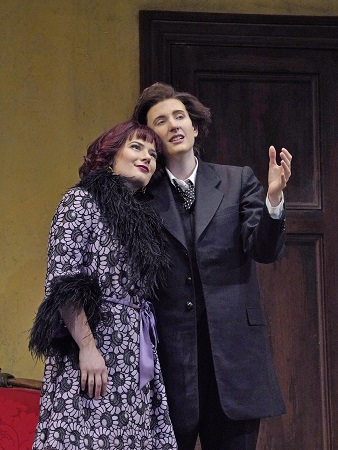 Liv Redpath (Zerbinetta) and Amanda Majeski (Composer). Photo credit: Ken Howard for Santa Fe Opera 2018.
Liv Redpath (Zerbinetta) and Amanda Majeski (Composer). Photo credit: Ken Howard for Santa Fe Opera 2018.
Bruce Sledge brought a highly attractive, clarion tenor to the role of Bacchus. Mr. Sledge’s generous, freely produced tone was wedded to a rock solid technique that allow him to assay a very pliant reading of this notoriously difficult sing. I have rarely heard anyone craft such gorgeous, arching, urgent phrases in this part. I hope he paces himself in his career to be around for many years, because this repertoire needs him now.
As the commedia quartet, pride of place must be given to the endearingly personable Harlequin of Jarrett Ott. The young baritone is at a breakthrough moment in his career thanks to various high vis projects, and he gifts this current role with a richly suave baritone, handsome demeanor, lively stage presence, and infectious sense of fun. Strauss gives Harlequin several chances to shine, and shine Jarrett Ott emphatically does.
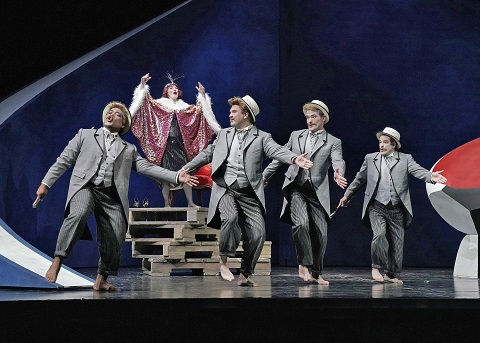 Terrence Chin-Loy (Brighella), Liv Redpath (Zerbinetta), Anthony Robin Schneider (Truffaldino), Jarrett Ott (Harlequin), and Matthew DiBattista (Scaramuccio). Photo credit: Ken Howard for Santa Fe Opera 2018.
Terrence Chin-Loy (Brighella), Liv Redpath (Zerbinetta), Anthony Robin Schneider (Truffaldino), Jarrett Ott (Harlequin), and Matthew DiBattista (Scaramuccio). Photo credit: Ken Howard for Santa Fe Opera 2018.
Not to be outdone, Anthony Robert Schneider’s mellifluous bass enlivened Truffaldino, Matthew DiBattista’s substantial tenor was a perfect fit for Scaramuccio, and tenor Terence Chin-Loy’s gleaming tone successfully caressed Brighella’s high-flying passages. Together, the four of them were a well-oiled machine, strutting, dancing, cavorting and of course, singing remarkably well. On the distaff side of the “opera” proper, Meryl Dominguez (Najade), Samantha Gossard (Dryade) and Sarah Tucker (Echo) provided consistently alluring singing, whether singly or together.
If anyone owned the Prologue, it was likely veteran Rodney Gilfry, giving a bravura performance as the put upon Music Master. Mr. Gilfry was in fine fettle, his robust baritone rarely sounding better. His commitment and animation dominated his every scene. That is not to diminish the dynamic accomplishment of Amanda Majeski as the earnest, anguished Composer. While I tend to prefer a mezzo in this part, Ms. Majeski’s compelling, penetrating soprano made a fine case for the role. I only wished her interpretation had been a bit less relentless and a mite more nuanced.
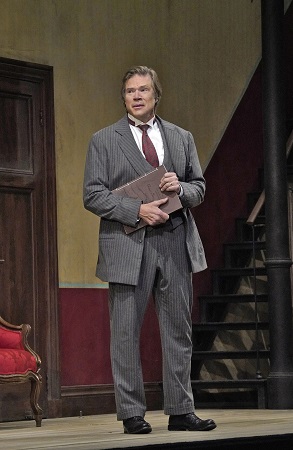 Rod Gilfry (Music Master). Photo credit: Ken Howard for Santa Fe Opera 2018.
Rod Gilfry (Music Master). Photo credit: Ken Howard for Santa Fe Opera 2018.
In a spoken role, Kevin Burdette provided a Masters Class in condescension as the amusingly smug Major-Domo. Brent Michael Smith’s luxurious bass served up solid singing as the Footman, while Jarrett Logan Porter’s warm baritone made for a pleasant turn as the Wigmaker. Lithe and sprightly Brenton Ryan was an animated Dancing Master, and his pointed tenor was deployed with skill and aplomb. Jesse Darden’s assured tenor made the most of his time as the Officer.
Conductor James Gaffigan elicited admirably idiomatic playing from his pit musicians. This is a tricky score, with a reduced orchestration, and Maestro Gaffigan not only crafted soaring ensemble effects with this smallish band, but also drew out the very best solo playing from this talented assemblage. The often prankish, chamber music accompaniment was always wedded seamlessly with the singers. And the gossamer effects at opera’s end were fully realized, and delightfully rendered.
The physical production, while simple, was everything one could wish. Tobias Hoheisel was the accomplished set and costume designer, the former slightly more effective than the latter. The Prologue is set in a shallow, nondescript hallway upstage of which are four doors, three of which are dressing rooms, one of which is a good goof. A long staircase stage left leads to the mansion proper (we are led to believe). So in this Upstairs/Downstairs scenario, these “actors” are definitely in the “downstairs.” The four commedia men are relegated to changing behind a makeshift curtain down left.
Act II (the opera) is a marked shift from reality to fantasy. Mr. Hoheisel has devised a mysterious, upwardly swirling conical structure of an island that somehow evokes a close up Georgia O’Keefe study. The two soaring halves contain a circular playing space that is mysterious, magical and multipurpose. Ariadne’s cave stage left is more a red womb, a sort of stylish oversized Roche-Bobois pedestal chair. The simple addition stage right of a stack of classy wooden pallets, topped with a red upholstered chair balances the high culture realm of the classical opera (cave) and the low culture realm of entertainment (pallets).
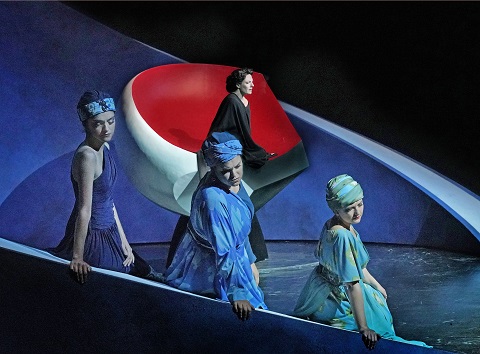 Samantha Gossard (Dryade), Meryl Dominguez (Najade), Amanda Echalaz (Prima Donna/Ariadne), and Sarah Tucker (Echo). Photo credit: Ken Howard for Santa Fe Opera 2018.
Samantha Gossard (Dryade), Meryl Dominguez (Najade), Amanda Echalaz (Prima Donna/Ariadne), and Sarah Tucker (Echo). Photo credit: Ken Howard for Santa Fe Opera 2018.
Mr. Hoheisels’ costumes, while visually appealing were more puzzling. He seemed to be contrasting a Music Hall look for the commedia troupe against a sleeker concert look for the royals. But then there were the uniforms of the household staff. The period didn’t seem entirely consistent even though it was visually satisfying. Thomas C. Hase designed some highly atmospheric lighting, straightforward in the prologue (complete with practical lanterns), moody and mythical in “the opera.”
Tim Albery directed, as well as providing the effective English translation for the Prologue (and for many stretches of interjections in Act II). While Mr. Albery’s basic traffic management was efficient and sensible, the rich detail often present in his work seemed in short supply. Aside from Jodi Melnick’s clever choreography, the action often seemed stuck in neutral. Most lacking was the realization of the unfolding relationship of Ariadne and Bacchus resulting in a loving unification, which, devoid of any palpable emotional connection, seemed to go for too little.
Happily, we could always simply rejoice that musically, some of the best interpreters around were treating us to a generous helping of vintage Strauss. Mr. Crosby, your legacy lives on.
James Sohre
Strauss: Ariadne auf Naxos
Music Master: Rod Gilfry; Major-Domo: Kevin Burdette; Footman: Brent Michael Smith; Officer: Jesse Darden; Composer: Amanda Majeski; The Tenor/Bacchus: Bruce Sledge; Wigmaker: Jarrett Logan Porter; Zerbinetta: Liv Redpath; Prima Donna/Ariadne: Amanda Echalaz; Dancing Master: Brenton Ryan; Najade: Meryl Dominguez; Dryade: Samantha Gossard; Echo: Sarah Tucker; Harlequin: Jarrett Ott; Truffaldino: Anthony Robert Schneider; Scaramuccio: Matthew DiBattista; Brighella: Terence Chin-Loy; Conductor: James Gaffigan; Director and English Translation: Tim Albery; Set and Costume Design: Tobias Hoheisel; Lighting Design: Thomas C. Hase; Choreography: Jodi Melnick
image=http://www.operatoday.com/SFAriadnetitle.jpg
image_description=Ariadne auf Naxos: Santa Fe Opera
product=yes
product_title=Ariadne auf Naxos: Santa Fe Opera
product_by=A review by James Sohre
product_id= Above: Samantha Gossard (Dryade), Meryl Dominguez (Najade), Sarah Tucker (Echo), and Amanda Echalaz (Prima Donna/Ariadne)
Photo credit: Ken Howard for Santa Fe Opera 2018
From the House of the Dead: Munich Opera Festival
And how the work suits such an approach; in many respects, the deconstruction has already been done. Probably Janáček’s greatest opera, indeed his greatest work of all, it is no accident that it is the one Pierre Boulez chose to conduct, towards the end of his life. Alas I never heard that live, although in 2014, I would see Patrice Chéreau’s production in Berlin. That was, of course, a fine piece of theatre, as indeed was Krzysztof Warlikowski’s Covent Garden staging , seen earlier this year. Castorf, however, revelling in its fragmentary nature - for it is in many respects his own - triumphantly, I should say dialectically, offers the strongest sense of a whole I have seen or could imagine. By taking it as it is, Castorf’s team and a magnificent cast, aided greatly by Bavarian State Opera forces under Simone Young in the finest performance I have heard from her, alert both to the needs of the minute and of the greater architecture, present and represent the opera as it is and might be. Quite without sentimentality, they write and rewrite, igniting and reigniting that Dostoevskian redemptive spark that is both present and absent throughout, depending when and where one looks and listens, how and with what one pieces together one’s own narrative, musical and dramatic.
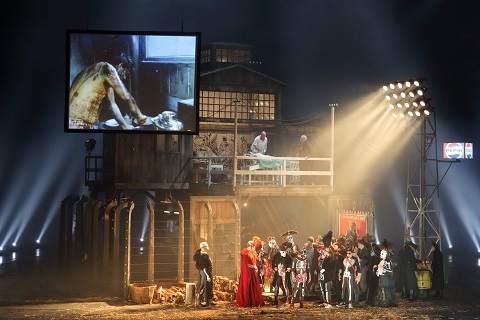 Photo credit: Wilfried Hösl.
Photo credit: Wilfried Hösl.
We are in Russia - no doubt of that. It is Russia at a dark time - again no doubt of that. (When, however, was that not the case, save for a few years under Lenin, and even then…?) But is it a ‘real’ Russia? And what indeed could so impossibly naïve a formulation mean? Live camerawork performs all manner of tasks, questioning our ability to comprehend, to view, to narrate, whilst making it all the more necessary that we try to do so. There is little doubt concerning the realism - until, that is, a true Carnival of the Dead comes amongst the prisoners and the prison. Magic realism? Perhaps, but if so, it is the blackest of magic to follow, perhaps even to sublate, the blackest of comedy and (non-)redemption. Whereas, in his Siegfried and Götterdämmerung , Castorf took us to an alternative historical path for the GDR, an alternative that turned out not to be so very alternative at all, (Al)Exander Platz still a commercial, post-socialist wasteland, Wall Street still failing to burn, here we seem perhaps to have joined the USSR for an alternative 1930s.
Or have we? Trotskyist hints abound: the rabbit hutch (many thanks to my friend Sam Goodyear for having pointed out the connection), Mexico too (‘Partido liberal’, we read on one of many historical and/or imaginary signs), a film advertisement (in Spanish), starring Alain Delon. (Hang on, if we are in 1972…?) Even a carnival bird Aljeja, splendidly sung by Evgeniya Sotnikova, seems both to suggest and to disavow that possibility. Or are we, was I, confusing him/her - here most definitely ‘her’ - with the Prisoner with the Eagle, or his eagle? What might that mean here, whether the confusion or the eagle? Russia or the USSR, however, it certainly remains, even down to the affinity - which seems to have been overstated by some - with Aleksandar Denić’s Walküre set (Azerbaijan, 1942) . What does a sign for Pepsi Cola in English and Russian tell us? And what, at the end, does the English poster invitation to travel to the USSR as a holiday destination mean, not least in such appalling circumstances? Is it a joke, as is perhaps suggested by the presence of a Ring crocodile? Stop trying to ascribe meaning to everything: is that not what, as an imprisoned intellectual, one is compelled to do? Are we to see the future and will it to work, or perhaps indict it? Who knows? We shall never make the journey, just like so many of those prisoners, yet unlike, perhaps, Gorjančikov, who thinks he has something written in his head. Like Dostoevsky, like Trotsky, like Castorf, like our writer, Alexandr Petrovič Gorjančikov, we write and rewrite. So too does the action all around, on stage, on film, seen and unseen; so too, of course, does the orchestra.
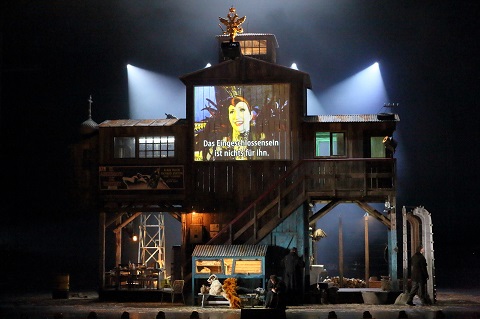 Photo credit: Wilfried Hösl.
Photo credit: Wilfried Hösl.
It is complicated, yes; how can a fragmentary drama with so many ‘characters’ or at least people not be? But it is also visceral, direct. Violence we see, we feel, whether we like it or not, be it in the Guard’s sadistic flagellation (a truly nasty Long Long, almost a match for the still nastier Governor of Christian Rieger) or in the metal of the steppes’ orchestra. Opera too, even in this most inhospitable of circumstances, is reborn. If the Wanderer seemed to have been an inspiration for our noble prisoner’s initial journey to this camp, Peter Mikuláš capturing both intelligence and a certain camouflaged nobility, then it is the Wotan of the second-act Walküre monologue who comes to mind in that of Šiškov. That is partly a matter of Bo Skovhus’s searing portrayal, quite the most powerful performance I have seen and heard from him in a long time. But everyone involved has played a role in putting these pieces together, in constructing something from these musico-dramatic shards. ‘A mother gave birth even to Filka,’ after all - and we know it, because, like Šiškov, he sings, not least in this devilish incarnation from Aleš Briscein. So too, earlier, do Don Juan (an outstanding Callum Thorpe) and his pseudo-Leporello (another excellent performance, this time from Matthew Grills), in a play-within-a-play. That, thanks to Castorf’s lengthy experience with and rejuvenation of post-dramatic commentary, seems more of a play-in-itself than I can recall - until, once again, it does not.
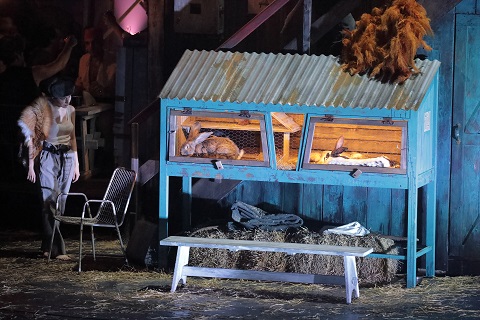 Evgeniya Sotnikova as Aljeja. Photo credit: Wilfried Hösl.
Evgeniya Sotnikova as Aljeja. Photo credit: Wilfried Hösl.
For, like Don Giovanni, this is redemptive within and without, or seems to be: as I said, it takes life and drama as they are. A (post-)religious consciousness is at work here. It also, perhaps, suggests what they might be, or at least what one day, when the revolution comes again, the revolution to which we cling no matter what, we might hope it to be. The noble prisoner leaves, though, so most likely not. He has used, learned from his experience; so, we imagine, have we. The carnival of (Russian) death continues. There is a chink of something uncertain. In the blackest of comedies, we might even think it light. Humanity even - though are we not all now post-human(ist) as well as post-dramatic? Who knows, who cares? This human comedy and tragedy of which we are part rolls on, just as it did for those Calderón-like figures of a reimagined Salzburg World Theatre in the celebrated post-war Furtwängler Don Giovanni. The final scene alienates - like Mozart’s. And yet, like that too, it moves (us). We have experienced something, even if we have not a hope in our living hell of learning what it may have been. We have, like this Gorjančikov, written a work of sorts in our head. No one will read it or even remember it, perhaps it would be impossible for anyone to make sense of its difficult, even nonsensical fragments; yet that spark of creativity, of art, of that which Marx just as much as Schiller considered made us human, has flickered. At least we think it did. Perhaps. Or at least we thought it did. Once. Perhaps. We return, like Gorjančikov, like Trotsky, to watch the post/non-human (non-)drama of the rabbits in their hutch, caged like us and yet (to the sentimental?) more free. Perhaps.
Mark Berry
Leoš Janáček: From the House of the Dead
Alexandr Petrovič Gorjančikov: Peter Mikuláš; Aljeja: Evgeniya
Sotnikova; Luka Kuzmič (Filka Morozov): Aleš Briscein; Skuratov:
Charles Workman; Šiškov: Bo Skovhus; Big Prisoner, Prisoner with the
Eagle: Manuel Günther; Little Prisoner, Bitter Prisoner: Tim Kuypers;
Governor: Christian Rieger; Old Prisoner: Ulrich Reß; Čekunov: Johannes
Kammler; Drunk Prisoner: Galeano Salas; Cook: Boris Prýgl; Smith:
Alexander Milev; Pope: Peter Lobert; Prostitute: Niamh O’Sullivan; Don
Juan (Brahmin): Callum Thorpe; Kedrill, Young Prisoner: Matthew Grills;
Šapkin, Happy Prisoner: Kevin Conners; Čerevin, Voice from the
Kirghizian Steppes: Dean Power; Guard: Long Long. Director: Frank
Castorf; Set Designs: Aleksandar Denić; Costumes: Adriana Braga
Peretski; Lighting: Rainer Casper; Video: Andreas Deinert, Jens Crull;
Live Cameras: Andreas Deinert, Stefaniue Katja Nirschl; Live Editing:
Jens Crull; Dramaturgy: Miron Hakenbeck; Revival Director: Martha
Münder. Bavarian State Opera Chorus (chorus master: Sören
Eckhoff)/Bavarian State Orchestra/Simone Young (conductor).
Nationaltheater, Munich, Monday 30 July 2018.
Photo credit: Wilfried Hösl
August 2, 2018
Haydn's Orlando Paladino in Munich
Speak to the audience in Munich’s Prinzregententheater it certainly seemed to - rightly or wrongly. I could only wish that both the work and those of us in the audience who thought otherwise had not been treated with such condescension. That may sound reactionary. Perhaps indeed it is; perhaps all that matters is that those many people who enjoyed such an ‘entertainment’, to use a properly eighteenth-century word, did indeed enjoy it. Perhaps. Let me, however, try to explain why I found this, much fine singing notwithstanding, a somewhat dispiriting experience.
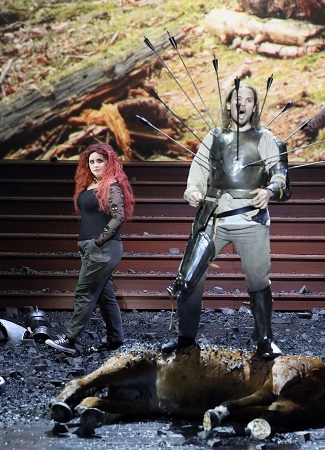 Tara Erraught (Alcina) and David Portillo (Pasquale). Photo credit: Wilfried Hösl.
Tara Erraught (Alcina) and David Portillo (Pasquale). Photo credit: Wilfried Hösl.
No one, I think, would claim Nunziata Porta to be one of opera’s greatest librettists; this is not a Da Ponte, a Wagner, or a Hofmannsthal. Nor indeed a Metastasio. However, his libretto here is, by the same token, likely to be underestimated, precisely because of where his talents lay. His principal occupation at Esterháza was to adapt texts, including provision of insertion arias. (If you do not know any of Haydn’s, for obvious reasons far less widely known than Mozart’s, then they are well worth discovering.) And that is what he did here, on a larger scale, with Orlando Paladino, helping Haydn create a rather extraordinary work, a dramma eroicomico after Ariosto. Its skill lies not just in parodying Ariosto, indeed not primarily in that at all, but in permitting Haydn to do so and indeed to parody much else besides: often wryly, subtly, sometimes more overtly - here, at least in one particular instance, in Pasquale’s ‘Ecco spanio’, Ranisch worked highly successfully with libretto and music. Otherwise, I am afraid, far too little of that came through - which was surely something a skilled production might have seen as its purpose or at least a good part of it.
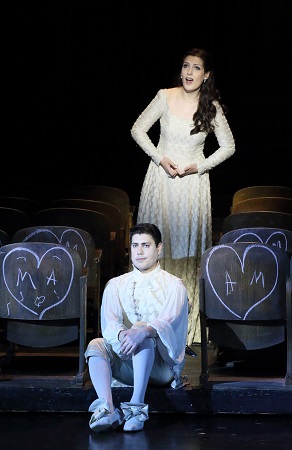 Dovlet Nurgeldiyev (Medoro) and Adela Zaharia (Angelica). Photo credit: Wilfried Hösl.
Dovlet Nurgeldiyev (Medoro) and Adela Zaharia (Angelica). Photo credit: Wilfried Hösl.
Yes, one might respond, but what if an audience does not understand the conventions of late-ish eighteenth-century opera seria? Do we not need to find a way of leading many listeners in? We probably do, or at least in certain circumstances it might be a good idea. (Heaven forfend we might actually expect some work from an audience; nevertheless, if I do not read Russian, I do not claim the problem to lie in Pushkin.) A similar problem, after all, seems often to be experienced with Così fan tutte, which very few seem to understand - or, more to the point, take the trouble to try to understand. (Sometimes it is not ‘all about you’.) By all means, though, lead us in, show us what the opera is or might be about. Ranisch, however, seemed to have no interest whatsoever in doing so. Not unlike Christof Loy in his unforgivable Salzburg Frau ohne Schatten , albeit less aggressively, the message seemed to be: ‘forget about this; I do not like this story very much, so here is another one’.
Alas, Ranisch’s new story seems to me only slightly less banal than Loy’s. For all the filmic creativity - undeniable in its way, if hardly groundbreaking - what we have ultimately is a new, less than captivating, tale of a married couple who own a cinema. One of them is at least partly gay and fantasises about the handsome Rodomonte (or perhaps the actor/singer who plays him). When technical problems cause an explosion in the cinema, he takes the opportunity to wander into the scenes on screen to learn a bit more about himself. A huge amount of silly running around, pulling faces, and so on, detracts entirely from the opera and at best has one wonder what on earth is going on. Now there may well have been a way, even within this particular metatheatrical framework, to engage with the work, to do more of what I have suggested it might. It really does not seem, though, to happen here. A pair of actors, ‘Gabi and Heiko Herz’, seem the most honoured here. Ironically, however, the banality of their story, the striking Cinema Paradiso homage in Falko Herold’s designs notwithstanding, throws one’s attention back towards the singing, if only out of desperation. We end up with another tired old cliché, that eighteenth-century opera other than Mozart’s is ‘really’ only about singing. Orlando Paladino and Haydn thus found themselves doubly damned.
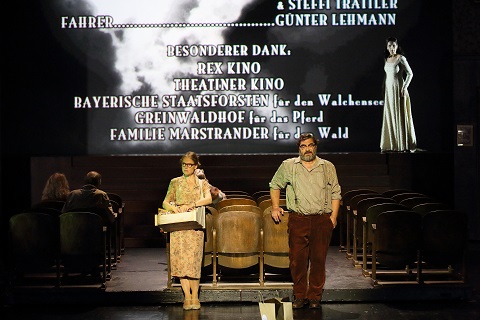 Gabi and Heiko Herz. Photo credit: Wilfried Hösl.
Gabi and Heiko Herz. Photo credit: Wilfried Hösl.
Such might have been less the case, had it not been for Ivor Bolton’s rigid, often hard-driven conducting, which paid little attention, if any, to Haydn’s harmonic rhythm, living if indeed it lived at all only in the moment - perhaps not so ill-suited a complement to the production. The playing of the Munich Chamber Orchestra was in itself excellent, however. One longed for it to be let off its leash, though, not least for the strings to be permitted greater vibrato. There seemed little doubt that they longed for that too. Nevertheless theirs was fine playing, woodwind solos especially joyous. For the real thing, though, turn on record to Antal Doráti - or even, should this be your real thing and you can somehow stand the weird perversities, to Nikolaus Harnoncourt. Those perversities may eclipse formal understanding, or at least the communication thereof, but at least they seem less generated on auto-pilot.
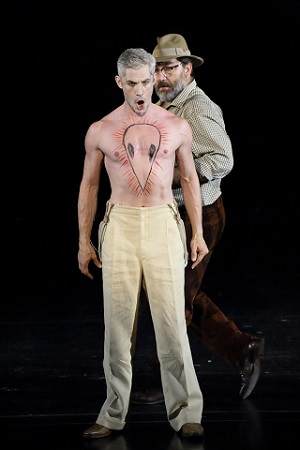 Edwin Crossley-Mercer (Rodomonte) and Heiko Herz. Photo credit: Wilfried Hösl.
Edwin Crossley-Mercer (Rodomonte) and Heiko Herz. Photo credit: Wilfried Hösl.
It was, then, to recapitulate - more of such formal understanding from the conductor, please! - from the singers that considerable pleasure and insight was to be gleaned. Mathias Vidal as Orlando trod a fine line, sensitively and stylishly, between bravado and acknowledged weakness. So indeed did all the male singers; such, not without a pinch of what we might anachronistically think feminism, is indeed the point. Edwin Crossley-Mercer’s diction was not always clear as it might have been, especially in so small a theatre; however, his dark tone proved full of allure - increasingly compromised allure. Dovlet Nurgeldiyev, for me one of the true discoveries of the evening, offered almost heartbreaking tonal beauty, whilst also making as much of the words as the production permitted. Likewise his intended, Adela Zaharia. David Portillo, a supremely versatile singer, finely attuned both to line and style, impressed greatly as Pasquale; his aforementioned aria was probably the highpoint of the entire evening. Elena Sancho Pereg, as Eurilla, proved very much his equal: a fine foil, but also a spirited character in her own right. Tara Erraught’s rich mezzo Alcina left one longing for more. It was she, above all, who brought moments of true drama to proceedings. Perhaps she, instead, should have been directing and/or conducting.
Mark Berry
Haydn: Orlando Paladino Hob.XXVIII:11
Angelica: Adela Zaharia; Rodomonte: Edwin Crossley-Mercer; Orlando: Mathias
Vidal; Medoro: Dovlet Nurgeldiyev; Licone: Guy de Mey; Eurilla: Elena
Sancho Pereg; Pasquale: David Portillo; Alcina: Tara Erraught; Caronte:
François Lis; Gabi and Heiko Herz: Heiko Pinkowski, Gabi Herz. Director:
Axel Ranisch; Conductor: Ivor Bolton; Designs: Falko Herold; Choreography:
Magdalena Padrosa Celada; Lighting: Michael Bauer; Dramaturgy: Rainer
Karlitschek. Statisterie and Opera Ballet of the Bavarian State Opera.
Prinzregententheater, Munich, Sunday 29 July 2018.
image=http://www.operatoday.com/Alcina%20and%20Angelica.jpg image_description=Haydn’sOrlando Paladino: Munich Opera Festival product=yes product_title= Haydn’s Orlando Paladino: Munich Opera Festival product_by=A review by Mark Berry product_id= Above: Tara Erraught (Alcina) and Adela Zaharia (Angelica)Photo credit: Wilfried Hösl
Donizetti's 'Regiment' Ride the Highway: Opera della Luna at Wilton's Music Hall
The vitriolic Berlioz, still smarting from the failure of his own Benvenuto Cellini after just ten performances at the Opéra, may have dismissed Donizetti’s La Fille du Régiment as trivia, but the rest of Paris was smitten when the opera premiered at the Opéra-Comique on 11th February 1804. Even the previous dismissive Mendelssohn had to admit Donizetti’s talent: ‘I am afraid I like it … Do you know, I should like to have written it myself.’
Opera della Luna’s Artistic Director certainly takes the Donizetti’s ‘little opera’ seriously: his production, first seen in 2014 and now slightly revised, treats the opera with a light and loving touch as it transfers the action from the nineteenth-century Swiss Tyrol to the desert mountain ranges of California during the 1950s.
The abandoned baby, Marie, is not found by a corps of military muscle but by a gang of leather-clad bikers, The Regiment, who are engaged in non-mortal combat with their rivals, The Wild Cards. Think Donizetti meets West Side Story. Ian Wilson’s lighting fetchingly contrasts the heat-laden cobalt blue sky with the ochres of the sun-cracked scorched earth from which a few prickly catci sprout. When we transfer, in Act 2, to the Berkenfield Mansion, where Marsha plots with Dulcie Crackenthorpe to marry off her reclaimed ‘niece’ to Dulcie’s son, the desert makes a surprisingly effective home for the grand piano.
The cast’s American accents - in both the spoken text of Clarke’s colloquially spicy translation and in the musical numbers - are convincing and consistent, and none more so than the warm drawl of Charles Johnston as Sulpice, the President of The Regiment. Despite the aggressive posturing and knuckle-rings, beneath the beard and bandana this Sulpice is a gentle giant, and Johnston’s warm baritone was one of the pleasures of the evening - equalled by his easy presence of stage and dramatic nous. He leads a Regiment who are full-voiced and proud, but whose bikes are as big as their hearts - despite the rather limiting dimensions of Wilton’s’ stage, they glide their wheels in neatly choreographed formations with just the right blend of elegance and heft - and the stoical, shoulder-sobbing upon the enforced departure of Marie is both touching and side-splitting.
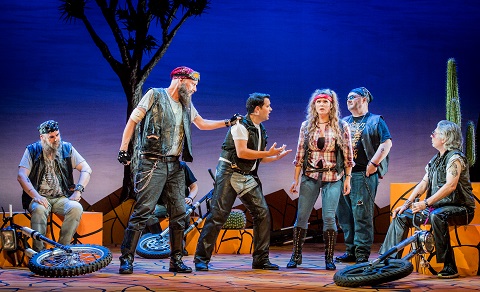 Charles Johnston (Sulpice), Jesus Alvarez (Tonio), Elin Pritchard (Marie). Photo credit: Robert Workman.
Charles Johnston (Sulpice), Jesus Alvarez (Tonio), Elin Pritchard (Marie). Photo credit: Robert Workman.
Johnston’s wise Sulpice also brings out the best in Katharine Taylor-Jones’ Marsha Berkenfield. Glammed up in primary hues and polka dots, Taylor-Jones steers clear of caricature and uses her beautifully soft and sweet contralto to show us Marsha’s scruples and sincerity.
She and Robert Gilden’s Mr Hortensius make a well-balanced double-act. Gilden’s butler minces gloriously, surreptitiously swigging a generous glug of martini from the ‘survival-flask’ when his mistress is lost in the mountains, and shows suave sycophantic servitude when ensuring the guests at Marsha’s soirée have their champagne cravings satisfied. He has the audience in stitches during the Act 2 overture with his oh-so-precious peeling of the paper which wraps the oranges destined for the silver fruit-bowl atop the Steinway, polishing each with a brisk flick of limp wrist and feather duster. Just how he swallowed the banana that made a surprise appearance in the fruit-box, without apparent moving his mouth, I can’t begin to imagine.
As the titular ‘foundling-with-fathers’, Elin Pritchard wore her denim and biker-boots like a natural, her gleeful grin and terrific pout evincing tomboyish charm. Marie’s manic passion for wheels took a musical turn - who knew that a singer’s rolled ‘r’s could accelerate into a “V-rrr-oom!” “Wow!” Marie screamed in the middle of her singing lesson, when Sulpice distracted her from her middle-class aspirational pastimes with the gleaming illustrations in his copy of Ultimate Road Machines.
In fact, memories of home released pent-up frustrations and repressed energies. Literally hemmed in by gawky hem-line, Pritchard stepped on the gas and threw restraint - and her lesson music - to the wind. She kicked off her cotton socks and turned Sulpice’s motorbike encyclopaedia into a tennis racket: poor Hortensius’ face said it all, as his carefully arranged orange tier was dismantled and hurtled into the audience. Pritchard enjoyed herself immensely: she has a powerful soprano which is full of colour and can hit the highs and make them sing. She moved easily through climbs and peaks and negotiated Donizetti’s curlicues smoothly, but was equally persuasive in Marie’s quiet aria of reflection as she tries to reconcile herself to her fate.
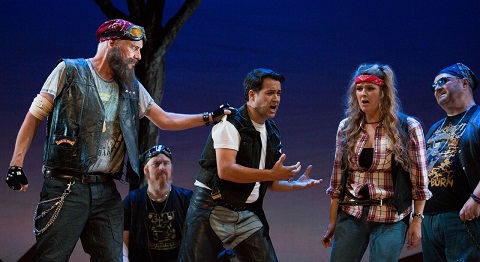 Charles Johnston (Sulpice), Jesus Alvarez (Tonio), Elin Pritchard (Marie). Photo credit: Nathan Cox.
Charles Johnston (Sulpice), Jesus Alvarez (Tonio), Elin Pritchard (Marie). Photo credit: Nathan Cox.
In his clean chinos and white ti-shirt, Jesus Alvarez’ Tonio - a Hispanic immigrant in this production - was certainly out-of-place and an unwanted interloper when he wandered into the bikers’ turf territory. Alvarez played it safe initially, but demonstrated plenty of stamina and courage, nailing each and every one of his high Cs which were well-supported and ringing. The vocal acrobatics turned out to be an initiation rite into the Regiment’s gang and he passed with flying colours, slipping with ease into his black bomber jacket. Alvarez didn’t always persuade me with a legato line, and his English diction was less than ideal, but he blended well in the ensembles and was an endearing Tonio.
Dulcie Crackenthorpe’s ghastly snobbishness was brilliantly captured by Philip Cox, and he was matched for ‘style’ by Jeremy Vinogradov’s self-loving Mrs van der Gelder. As her husband, the Governor of California, Richard Woodall sported a finely sculpted moustache and showed surprisingly balletic grace on the ballroom floor.
Conductor Benedict Kearns had his finger securely on the Donizetti pulse and his tempi were wisely judged, only occasionally leaving the singers rushing a little to catch up. The eleven instrumentalists were not housed in the most comfortable performance space - the percussion and bass were shoved into a cupboard under the balcony - but this didn’t hamper the orchestral performance one iota or dampen their obvious enjoyment of the music.
The overture was confidently played by the small ensemble, kicking off with a ringing horn solo from Kevin Elliott. It took Kearns a while to get the measure of the Hall’s acoustic, and the string ensemble was a little bass heavy at times, but if the orchestra overshadowed Marsha and Hortensius in their opening duet (for reasons of length and logic the opening chorus of Tyrolean citizens praying for safety while a battle between their countrymen and marauding French troops is one of Clarke’s neat excisions) then the players soon dropped down to achieve a more judicious balance. There were expressive solos from oboist Peter Facer and cellist Joanna Twaddle, deepening the pathos of the more sentimental dramatic moments.
Jeff Clarke and the terrific cast gave us a joyful evening of sunny high-spirits. No wonder the bikers let rip with some ritual air-punches and it was smiles all round at the close. Once again, Opera della Luna served up some seriously slick comedy.
Claire Seymour
Donizetti: The Daughter of the Regiment
Marsha Berkenfield - Katharine Taylor-Jones, Mr Hortensius - Robert Gildon, Sulpice - Charles Johnston, Marie - Elin Pritchard, Tonio - Jesus Alvarez, Dulcie Crackenthorpe - Philip Cox, The Governer of California - Richard Woodall, Mrs van der Gelder - Jeremy Vinogradov, The Regiment (Tulip - Richard Belshaw, Beef - Philip Cox, Tiny - Graham Stone, Crispy - Martin George, Rabbit - Jeremy Vinogradov, Lump - Richard Woodall); director - Jeff Clarke, conductor - Benedict Kearns, set designer - Graham Wynne, costume designer - Maria Lancashire, lighting designer (for Wilton’s) - Ian Wilson, Orchestra of Opera della Luna.
Wilton’s Music Hall, London; Tuesday 31st July 2018.
image=http://www.operatoday.com/Elin%20Pritchard%20and%20Charles%20Johnston%2C%20Photo%20Credit%20Nathan%20Cox%20%20%281%29.jpg image_description=The Daughter of the Regiment: Opera della Luna at Wilton’s Music Hall product=yes product_title=The Daughter of the Regiment: Opera della Luna at Wilton’s Music Hall product_by=A review by Claire Seymour product_id= Above: Elin Pritchard (Marie) and Charles Johnston (Sulpice)Photo credit: Nathan Cox
August 1, 2018
Bernstein Bemuses in New Mexico
Perhaps a few too many.
In yet another revision of this melodious, mettlesome stage work (Scottish Opera - Old Vic version), SFO has taken an approach somewhat akin to A Funny Thing Happened on the Way to the New World. To that end, renowned director Laurent Pelly has unleashed a cornucopia of no holds barred comic busy-ness in dogged pursuit of high toned “entertainment,” pure and simple. That Mr. Pelly and his tireless company succeeded in that pursuit, is evidenced by the near constant ripples of laughter elicited from the packed house.
To this viewer, they weren’t arguably always the right laughs. Pelly couldn’t seem to settle on one style and so he incorporated many: slapstick, operetta, cinematic honesty, caricature, romcom, farce, sitcom, and perhaps most wearing, an overly melodramatic, deliberately artificial mugging to the audience. That his willing performers delivered all this with utter commitment cannot be disputed, and I must report they were rewarded for their abandon with frequent ovations.
Candide began life as a notorious 1956 Broadway flop, most notable for a Columbia cast recording, which showcased Bernstein’s eclectic score. After the show languished for some years, Harold Prince devised a 105-minute version with a new libretto by Hugh Wheeler, which was such a success at Brooklyn Academy of Music in 1973 that it moved to a two year hit Broadway run in 1974. It was this lean and mean, immersive, interactive production that won me over, and I saw it four times. At last this meritorious score was married to a sassy, witty book and its previous problematic lack of Voltairean elan and coherent focus were fixed! Mais, attendez-vous. . .
Now that it was a hit, opera houses expressed interest in a proscenium version in two acts. Prince (and others) agreed to continue to tinker with it and began adding back in characters and songs that were extraneous. The temptation seems to have been great to re-order and darken the plot, resurrect good numbers that are nevertheless unnecessary, and worst, give enjoyable characters a second or third number that deserve to remain in Lenny’s trunk.
From the original recording, “Quiet” and “What’s the Use?” made a return to no real dramatic advantage other than being interesting tunes aurally. “The Venice Gavotte” had been re-purposed in 1974 as a delightful expository quartet (with lyrics by Stephen Sondheim, no less). That quartet still opens the show, but now we have an action-stopping Gavotte in Act II as well, reprising that material. I have not yet seen any company make the weak material of “Dear Boy” and “We Are Women” work, no matter how high the caliber of the collaborators.
My curmudgeonly posturing notwithstanding, having made their choice of edition, SFO has wholeheartedly embraced it, lavishing it with superlative production values. Chantal Thomas has provided a versatile, constantly morphing set design that is a director’s dream: all levels, steps, insets, parapets, nooks, crannies and foldouts. In deft obeisance to Voltaire the look is based on a wide variation of oversized books and pages, some curled, some flat, some arched at ever changing relationship to one other. On many occasions, appropriate vibrant projections designed by 59 Productions effectively decorate the white surface.
Director Pelly has also designed the fantastical costumes as is his wont, and they are over-the-top delightful. Many of them are pale colors, decorated with written lines from (one must presume) the novel Candide. The leading characters are a colorful lot, ranging from down at heel bag lady to kept courtesan to bastard peasant to conniving royalty and all points in between. Cunegonde’s ravishing red gown was alone worth the price of admission.
Duane Schuler has contributed his usual fine lighting design, with a couple of breathtaking “white light” isolations that momentarily sobered up the comedic proceedings. Only the follow spot work was a bit variable and not always on the mark. A small quibble about the projected translations: On more than one occasion, the timing prompted the audience to react to reading the joke before the performer actually finished the joke. A little fine-tuning would benefit actor and spectator alike.
Harry Bicket led an enthusiastic and accomplished reading of the score. With “Bernstein at 100” celebrations in full swing, it is impossible to avoid the overplayed overture this year, and while the pit had the notes in place, the effervescence needed found the pace just a notch too slow. Once past the opening, Maestro Bicket found all the zing, irony, and occasional pathos in Bernstein’s accomplished pastiche. The cast could really not have been better.
In the title role, Alek Shrader is giving his finest performance I have experienced to date. The music is a perfect fit for Mr. Shrader’s sweet, well-schooled tenor, and he caressed many a limpid phrase with poised, honeyed tone. But his Candide is anything but a crooning, put upon patsy, and he finds endless comic energy to inform his character and delight the audience. He throws himself unselfconsciously into everything he is asked to do, and if his Valley Girl jumping up and down, hands flailing in indecision didn’t make you laugh the first time, perhaps it will the fourth or fifth. He will die trying.
Indeed, his animated physical feats are so manic, that it is completely stunning when Alek remains stock still as the finally defeated Candide, perfectly crafting the penultimate selection, “Nothing More Than This,” the evening’s finest musical moment. In a perfect production, this might be moved to an earlier moment in the show, so it doesn’t somewhat upstage “Make Our Garden Grow,” almost identical in sentiment and immediately following. But no matter, Alek Shrader made musical magic with both.
Brenda Rae was as spirited, determined, and sexed up a Cunegonde as you could ever wish to see. It goes without saying that she sings brilliantly, with excellent diction, secure tone, and absolute assurance in all registers. Cunegonde’s music often lies in the lower middle, and while Ms. Rae’s attractive instrument doesn’t live there naturally, she negotiated those passages with skill and aplomb.
It is above the staff that this soprano soars, and her flights of fancy in the form of effortless coloratura in a definitive “Glitter and Be Gay,” all the while performing comic physical moves, stopped the show with roars of approval. It is to her credit that Brenda always found a way to make the character likable, even as she is driven by self-serving motives.
The Old Lady makes a delayed appearance in the script but when Helene Schneiderman finally arrives, she threatens to dominate her every scene. For such a diminutive woman, Ms. Schneiderman exudes an oversized presence, sporting a hilarious Mittel-European accent and a rich, full-bodied mezzo. Her traversal of “I Am Easily Assimilated” was a highlight. As the chorus moved around oversized costume plate cards missing the “head,” she daffily moved from one to the other to position her face to complete the picture.
The party trick of having one performer quadruple as Voltaire, Pangloss, Cacambo, and Martin held no challenge for the versatile baritone Kevin Burdette. Moving effortlessly between the four, Mr. Burdette found a highly distinctive accent and demeanor for each, modulating his well-schooled vocalizing to create a slightly different sound as required. As the more-often-than-not narrator, he kept the evening’s pace on sure and fleet footing.
Baritone Jarrett Ott was a delectably preening Maximilian, his pomposity underlined by his virile, buzzy singing. (Spoiler Alert) Mr. Ott was especially amusing in several scenes of fluid sexuality and cross-register chirping. Gina Perregrino made the most of her stage time as the slutty servant girl Paquette, her attractive mezzo contributing solidly to the musical mix and her perky personality keeping darker moments light.
Richard Troxell brought his steely, resounding tenor to bear on four roles that are not always assigned to the same performer: James, Captain, Governor, and Vanderdendur. Mr. Troxell’s ringing top and cleanly articulated phrases served all of them well, but “Bon Voyage” was his personal best. Tenor Abraham Bretón had an amusing turn as the overbearing Jew Don Issachar and also embodied the Crook. Rounding out the cast, bass-baritone Erik van Heyningen successfully impersonated the hypocritical Cardinal Archbishop of Paris and also played Ragotski.
The Apprentice Artists’ chorus made an inestimable contribution to the evening’s success, tirelessly doubling countless characters, seldom off stage, possessed of boundless energy, and singing wondrously under the direction of Chorus Master Susanne Sheston. Rarely is so much asked of an opera chorus in a staging, and director Pelly has gotten incomparable results from this invaluable, talented group of young performers.
At the end of the day, there is much to celebrate in this highly accomplished, thoroughly professional version of Candide. If it may not be everyone’s “best of all possible worlds,” it is a highly infectious, enthusiastically rendered piece of musical theatre. Any questions?
James Sohre
Cast and production information:
Voltaire/Pangloss/Cacambo/Martin: Kevin Burdette; Baron/Grand Inquisitor: Anthony Robin Schneider; Candide: Alek Shrader; Baroness: Kathleen Reveille; Maximilian: Jarrett Ott; Cunegonde: Brenda Rae; Paquette: Gina Perregrino; James/Captain/Governor/Vanderdendur: Richard Troxell; The Old Lady: Helene Schneiderman; Don Issachar/Crook: Abraham Bretón; Cardinal Archbishop of Paris/Ragotski: Erik van Heyningen; Conductor: Harry Bicket; Director and Costume Design: Laurent Pelly; Set Design: Chantal Thomas; Lighting Design: Duane Schuler; Projection Design: 59 Productions; Chorus Master: Susanne Sheston
image=http://www.operatoday.com/Candide_SantaFe.png image_description=Scene from Candide [Photo courtesy of Santa Fe Opera] product=yes product_title=Bernstein Bemuses in New Mexico product_by=A review by James Sohre product_id=Above: Scene from Candide [Photo courtesy of Santa Fe Opera]Santa Fe Floats a Beauteous Butterfly
Ana María Martínez is an operagoer’s dream of a Cio-Cio-San. Ms. Martínez not only has the role utterly securely in her voice, but has also anchored it deeply in her soul. She starts out coloring her substantial soprano sweetly, tremulously, deferentially, and thanks to her slim figure and youthful movement, she manages to actually suggest the naïve fifteen year old bride.
With her first utterance of Act II, however, she suggests a world-weary weight in the instrument that at once conveys her subsequent anguished plight. There is no aspect of this complex characterization that escapes her, and her complete command of the score’s demands places her squarely on the very short list of the role’s most accomplished practitioners.
Video courtesy of LA Opera
Moreover, her alluring creamy middle register rises seamlessly to gleaming heights above the staff. Her ravishing climactic top notes rang out in the house, and her flawlessly controlled, floated pianissimo effects were just as stunning. The rich dramatic detail and nonpareil musicianship that Ana María Martínez brings to this performance is the beating heart of the evening’s persuasive music making.
It is to Joshua Guerrero’s great credit that he actually imbues the caddish Pinkerton with genuine appreciation of his young bride, a believable soft spot for her boundless devotion, and a deeply felt remorse for the heart-rending results of his feckless decisions. Mr. Guerrero’s youthful, burnished tenor handily meets all the demands of the role. While his technique is even throughout the range, the very highest notes in Act I seemed slightly veiled. With his re-emergence in Act III, the voice displayed a more pointed gleam that made his contribution to the trio and especially his impassioned Addio, fiortio asil moments of unsurpassed beauty.
Martínez and Guerrero were successfully joining a “work in progress.” The rest of the solid cast was continuing in the run that began earlier in the season. The fluid sense of ensemble and the admirable execution of the business were so natural, that it appeared this cast had collaborated together for months.
Mezzo-soprano Megan Marino was a revelation as the faithful Suzuki. Ms. Marino’s plummy, stirring low register blossomed effortlessly into an easy middle and upper range that not only imbued The Flower Duet with limpid glamour, but also rang out with urgent conviction as she tries to compel the steadfast heroine to seek another life course. Her staunch, sometimes salty impersonation was a force to be reckoned with.
Nicholas Pallesen proved a fine asset as the well intended, if dithering consul Sharpless. Mr. Pallesen sports a beefy, rolling baritone that he deploys to good effect. He effectively communicated the character’s vacillating intentions, paralyzing indecision and continually withering resolve. If there was an occasional lumbering phrase in the passaggio, his was an engaging traversal, replete with some stirring high notes.
Matthew DiBattista was a particularly self-serving Goro (the men don’t come off so well in this piece, do they??). His oily insinuations were nonetheless wonderfully vocalized. Indeed, in the opening banter, Mr. DiBattista’s timbre sounded more akin to Mr. Guerrero’s leading man than the usual comprimario. His deliciously unctuous characterization was fully realized and relentlessly focused. As the Bonze, Solomon Howard seemed a force of nature, his powerful, rich bass booming out the character’s damning disapproval.
Kenneth Stavert was a particularly imposing Price Yamadori, his stature and sturdy baritone boldly embodying the spoiled, pompous royal. Hannah Haggerty was given more to sing as Kate Pinkerton than is usual, and Ms. Haggerty’s plush, attractive mezzo made the most of every opportunity. Stavert, Haggerty, and all of the Apprentice Singers shone in their brief solo assignments, with bass Colin Ramsey contributing particularly suave declamations as the Registrar. Youngster Paulino Rivera-Torres was a heart-tugging presence as Trouble, who startlingly executes a real coup de theatre at a critical dramatic moment. Susanne Shelton’s chorus was a well-knit ensemble.
I have enjoyed many fine performances from the Santa Fe Opera Orchestra over the years but none has been quite as effortlessly radiant as this Puccini. Conductor John Fiore led such a stylish, colorful, committed reading that the band became another character in the drama. Maestro Fiore exerted awesome control of his forces, partnering wonderfully with the singers with the accommodating elasticity that they needed to “live” the tragic story. From the lush banks of strings to the characterful solo playing, the assemblage made a definitive case for Puccini’s masterpiece.
There was more music than usual, with material included that the composer had excised. While it was all performed to a fare thee well and was interesting to experience, perhaps Puccini knew best, and the evening might have been even tighter without some of these rambling additions.
The revival of Lee Blakeley’s production was uncommonly affecting. Matthew Ozawa has directed with a fine eye to defining each character’s personal journey and their interaction with each other. The intriguing character relationships were evidently successful manifestations of subtext and background considerations. The recurring appearance and integration of an American flag yielded many of the shows most stirring moments.
Set designer Jean-Marc Puissant has devised a wholly effective environment. At curtain rise, only the frame of the house, flanked by selectively placed boughs of pink cherry blossoms. As the music begins, the cast brings on the props, and installs the sliding screens on house, as though Pinkerton may be having it built.
The loving, warm look at the close of Act I gave way in Act II to a worn down, sterile space, the blooming trees having been supplanted by the ugly installation of telephone poles and power lines running from down- to up-stage right. The desolation is further communicated by Rick Fisher’s sensitive lighting design ranging from the soft hues at Act I’s wedding, to the austere reality of Act II’s grey day, to the dawning of false hope in Act III. Every lighting design here is brilliantly augmented by the natural dramatic effects of beautiful sunsets seen through the rear of the open stage and sporadic lightning. On this night we were blessed with both.
Brigitte Reifenstuel brought a wealth of invention and imagination to her richly varied costume design. After the attractive japonaiserie of Act I, Ms. Reifenstuel attired the heroine and her servant in severe blacks and grays, subtly suggesting that Cio-Cio-San may be more in mourning than she is in anticipation of her husband’s return. When Butterfly sheds the dark colors to once more don her wedding gown, the effect is even more wrenching.
Thank you, Santa Fe Opera for giving the world this haunting, impeccably mounted, honestly conceived Madame Butterfly. For this viewer, it sets the gold standard against which all future renditions of this evergreen classic will be judged.
James Sohre
Cast and production information:
Cio-Cio-San: Ana María Martínez; B. F. Pinkerton: Joshua Guerrero; Suzuki: Megan Marino; Sharpless: Nicholas Pallesen; Goro: Matthew DiBattista; The Bonze Solomon Howard; Prince Yamadori: Kenneth Stavert; Kate Pinkerton: Hannah Haggerty; Trouble: Paulino Rivera-Torres; Butterfly’s Cousin: Sylvia D’Eramo; Her Mother: Kaitlyn McMonigle; Yakuside: Benjamin Taylor; Her Aunt: Meryl Dominguez; The Imperial Commissioner: Erik van Heyningen; The Registrar: Colin Ramsey; Conductor: John Fiore; Director: Matthew Ozawa; Set Design: Jean-Marc Puissant; Lighting Design: Rick Fisher; Costume Design: Brigitte Reifenstuel; Choreography: Nicola Bowie; Chorus Master: Susanne Sheston; Original Production: Lee Blakeley
image=http://www.operatoday.com/Butterfly_SantaFe.png image_description=Graphic courtesy of Santa Fe Opera product=yes product_title=Santa Fe Floats a Beauteous Butterfly product_by=A review by James Sohre product_id=Above graphic courtesy of Santa Fe Opera